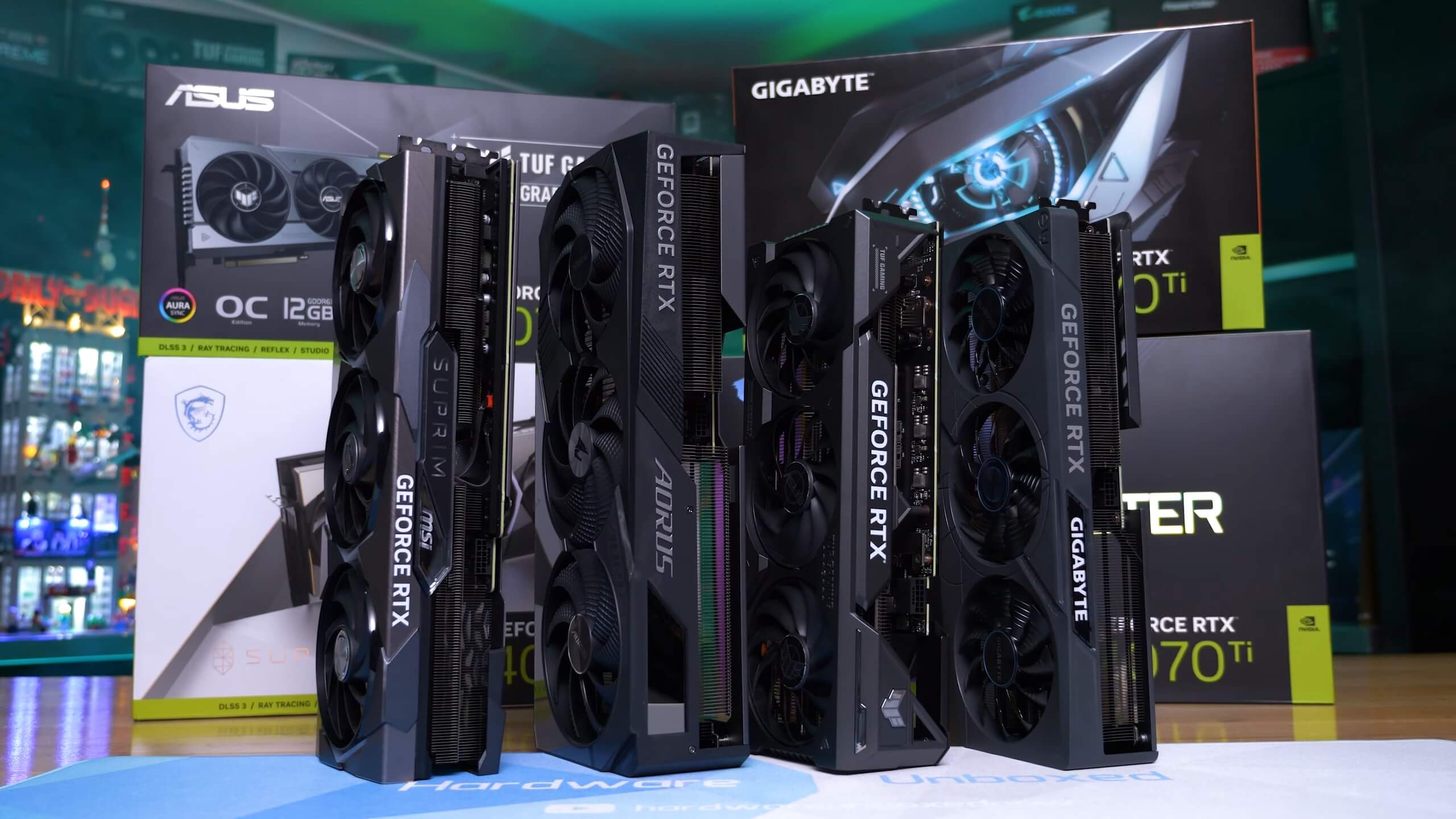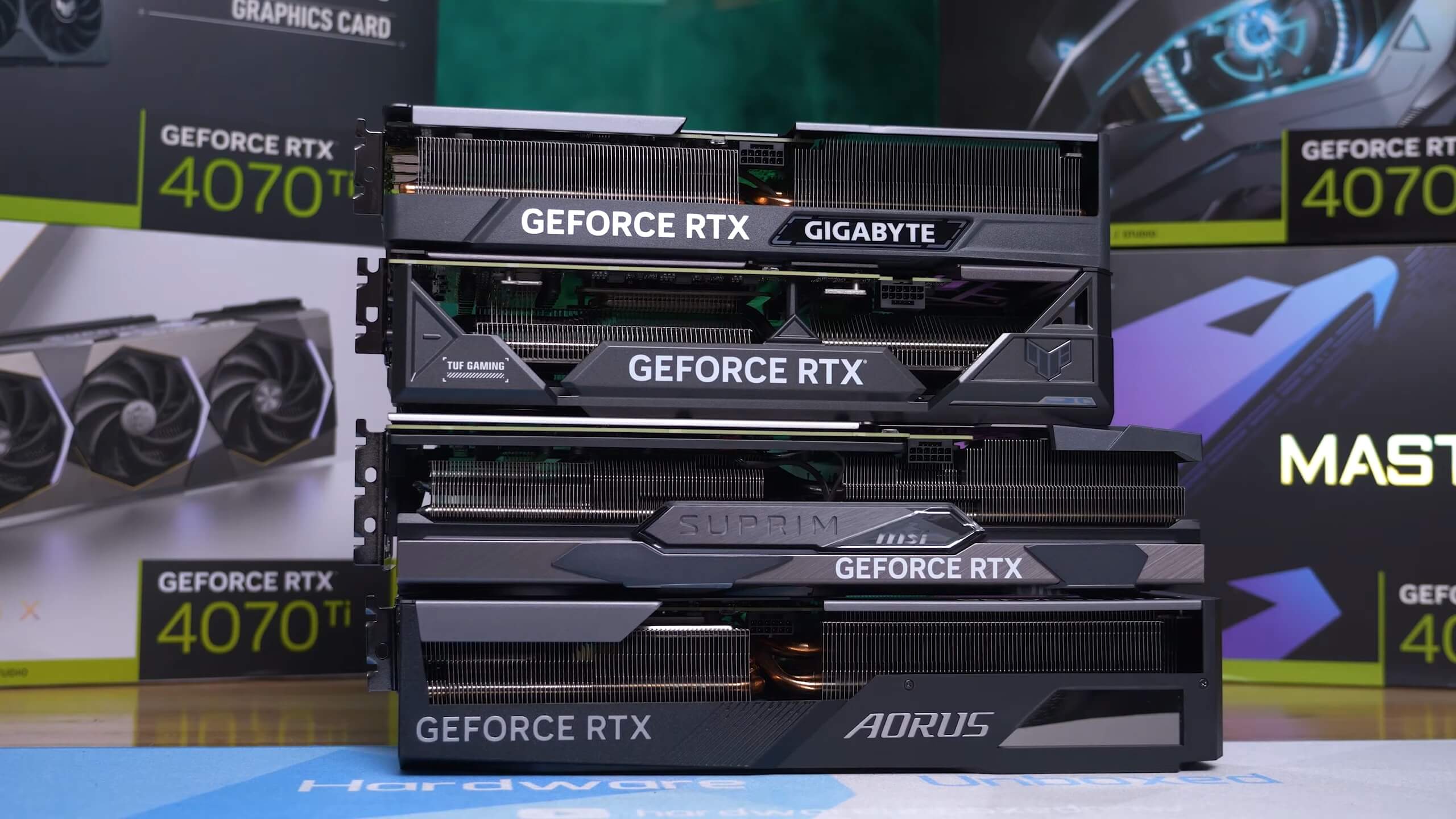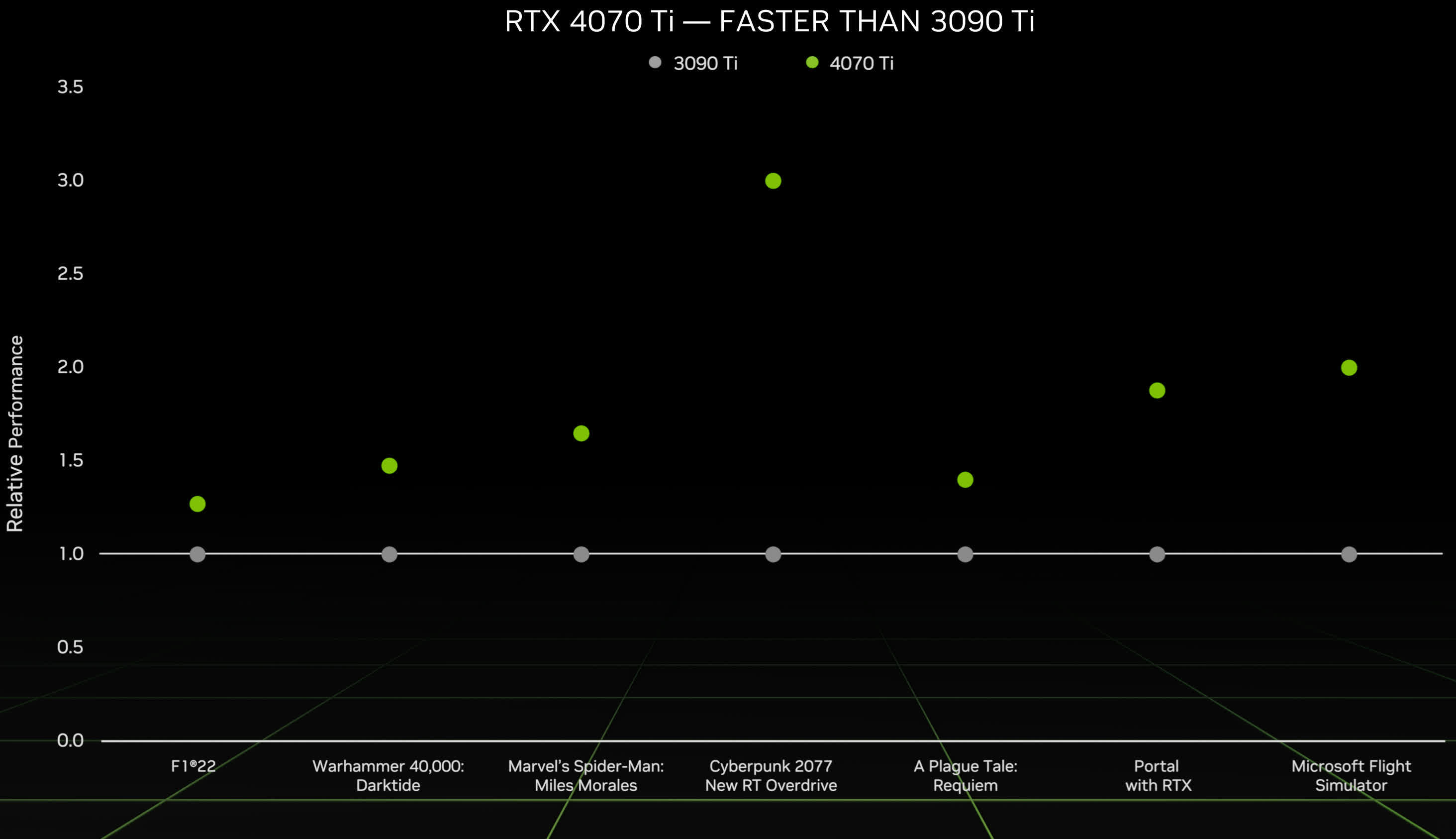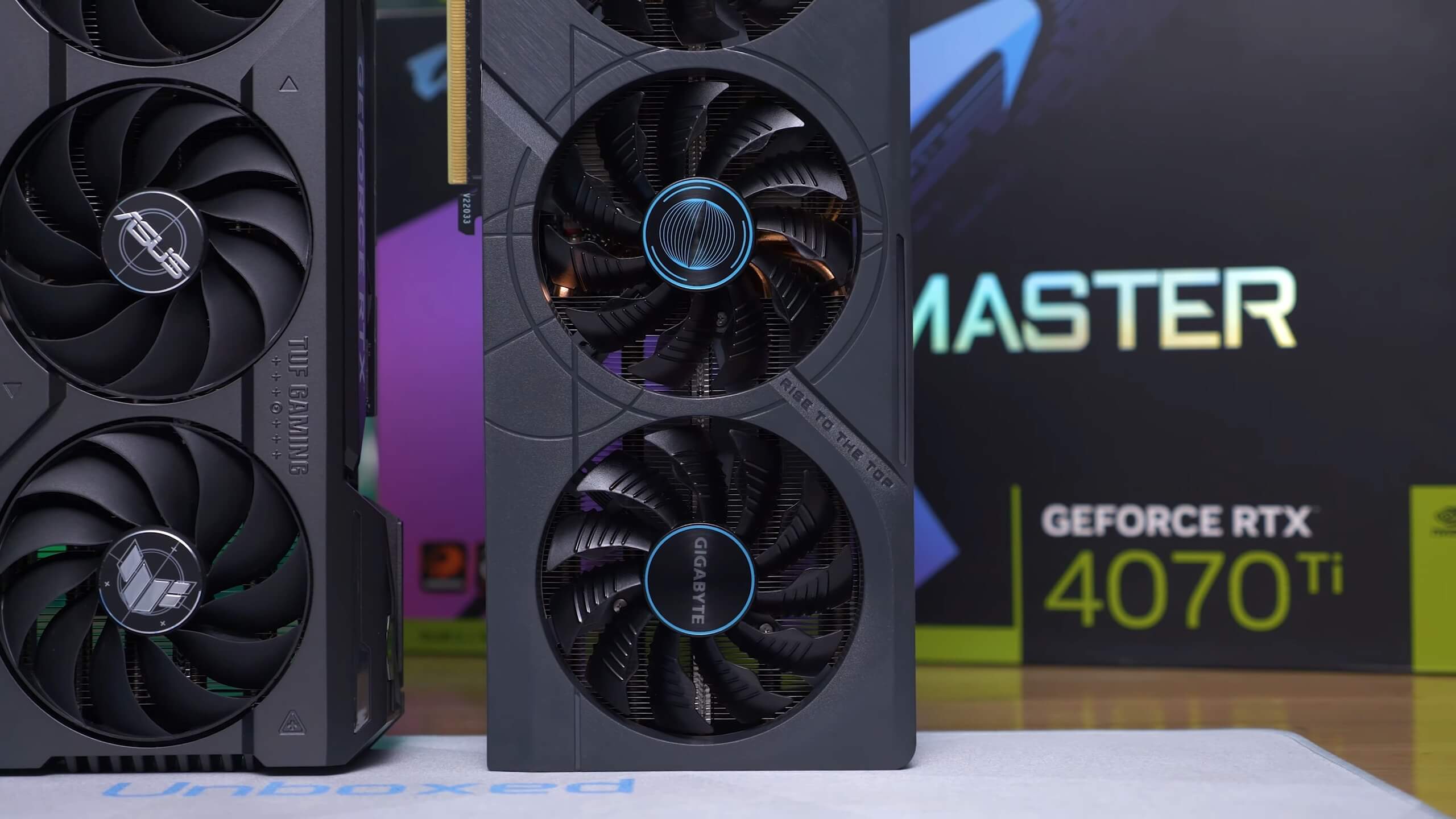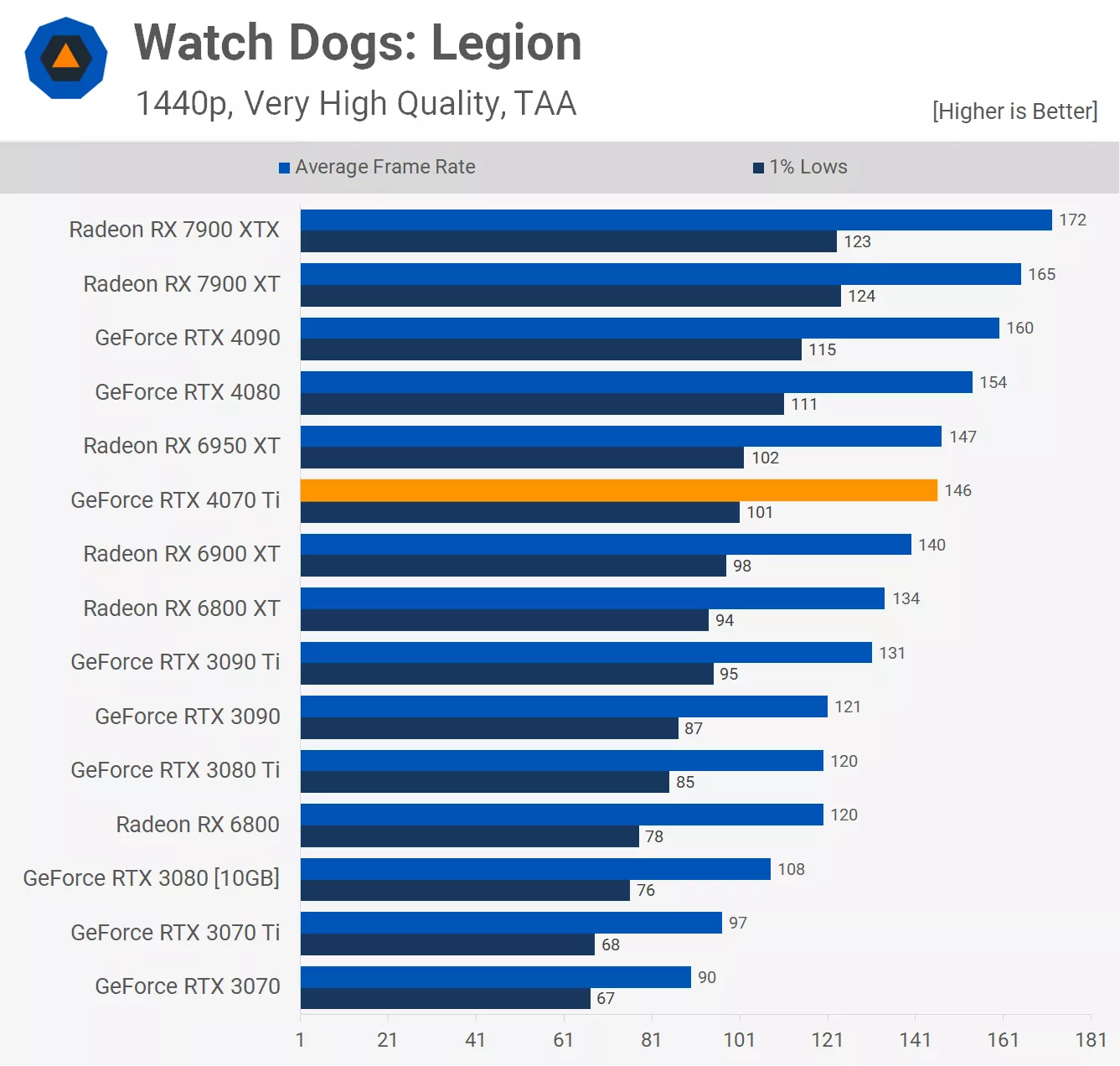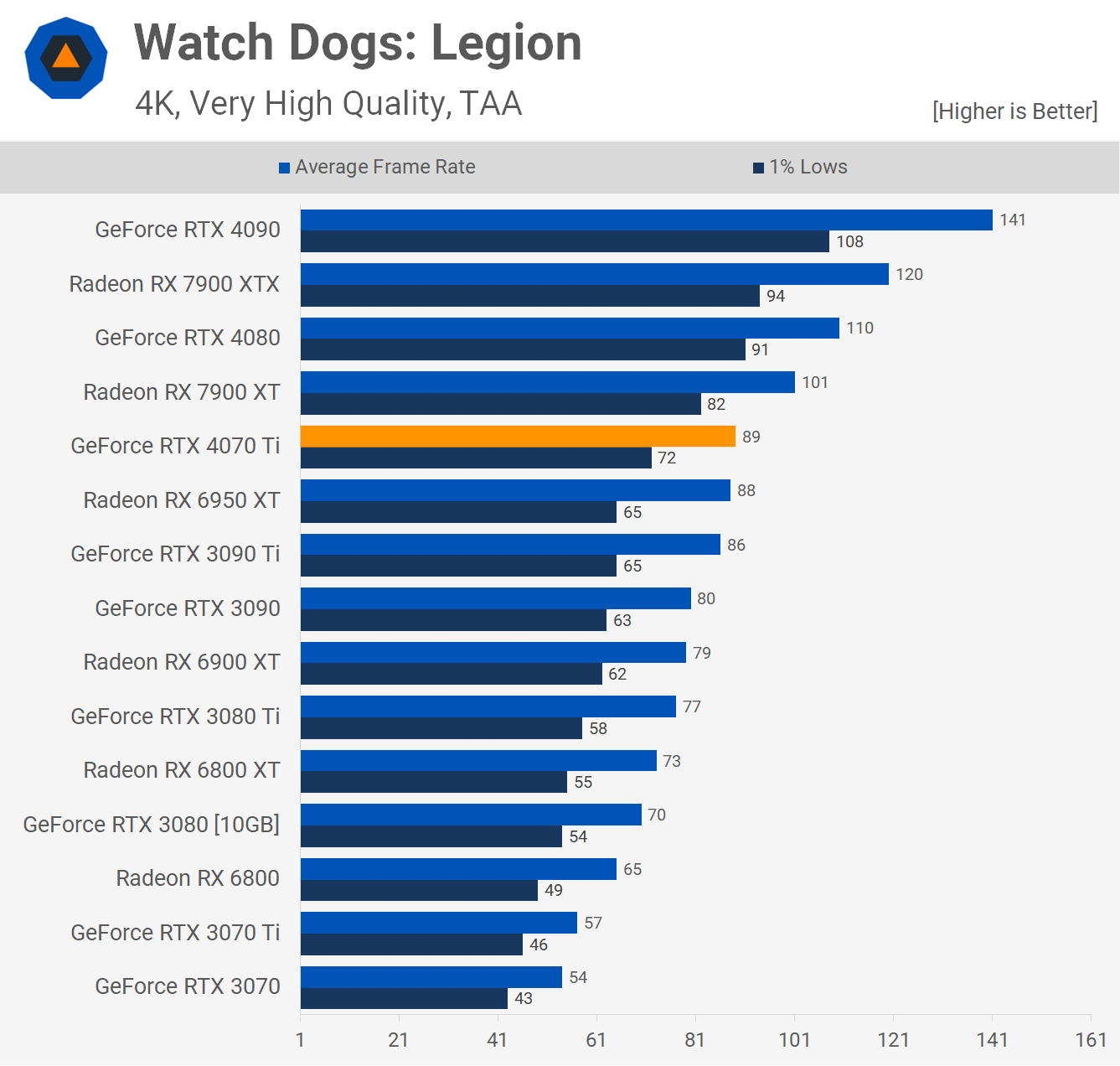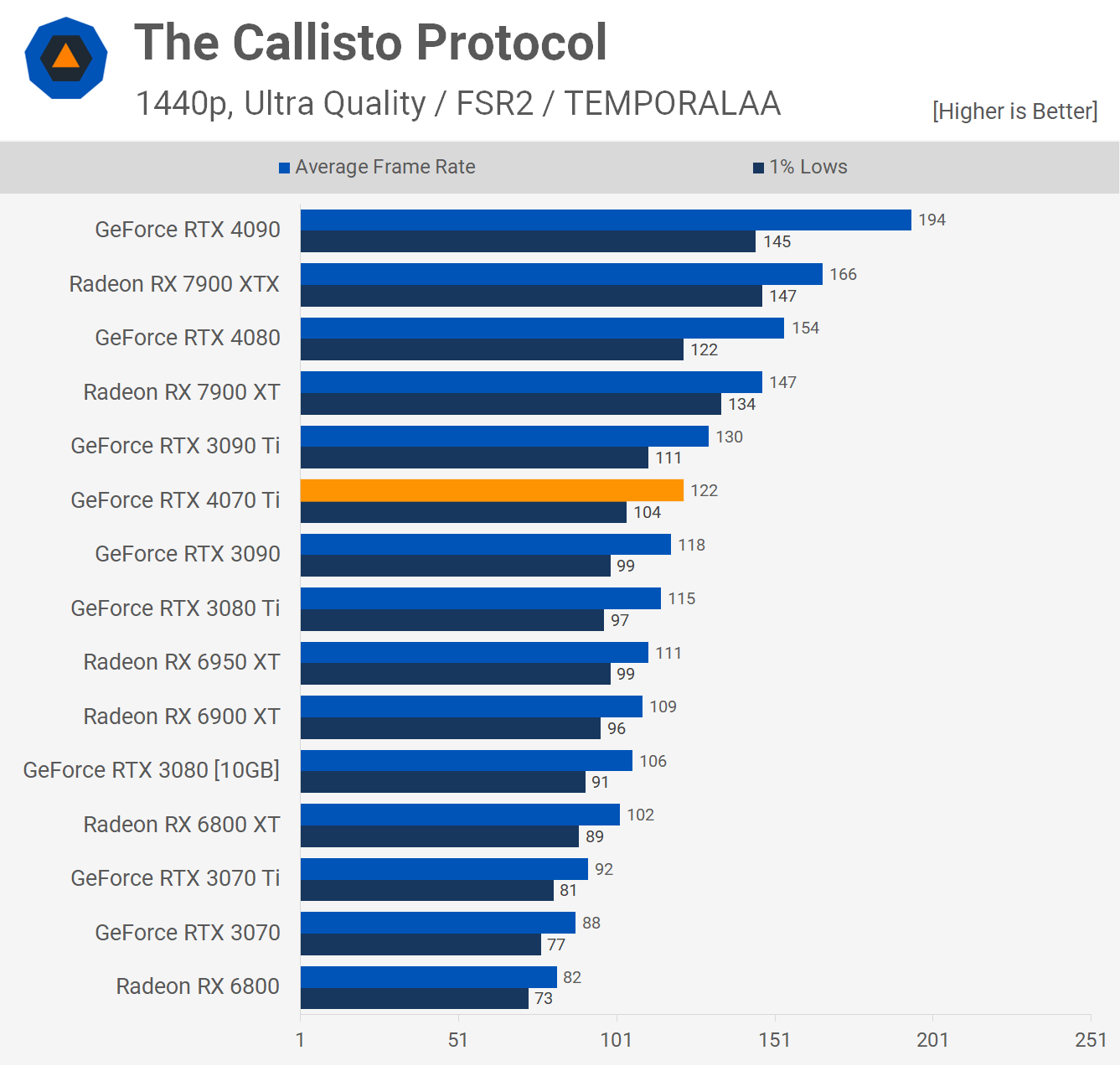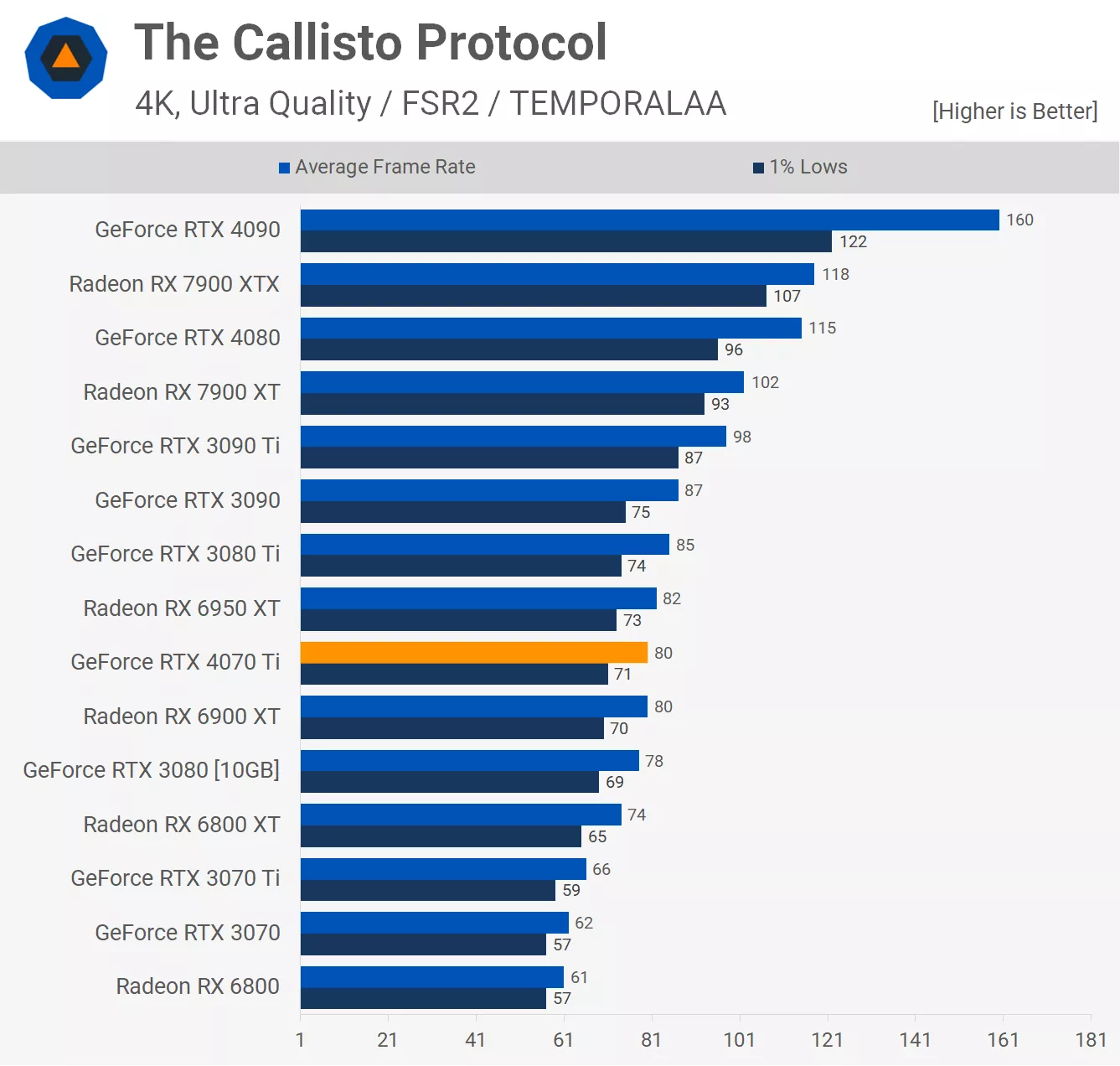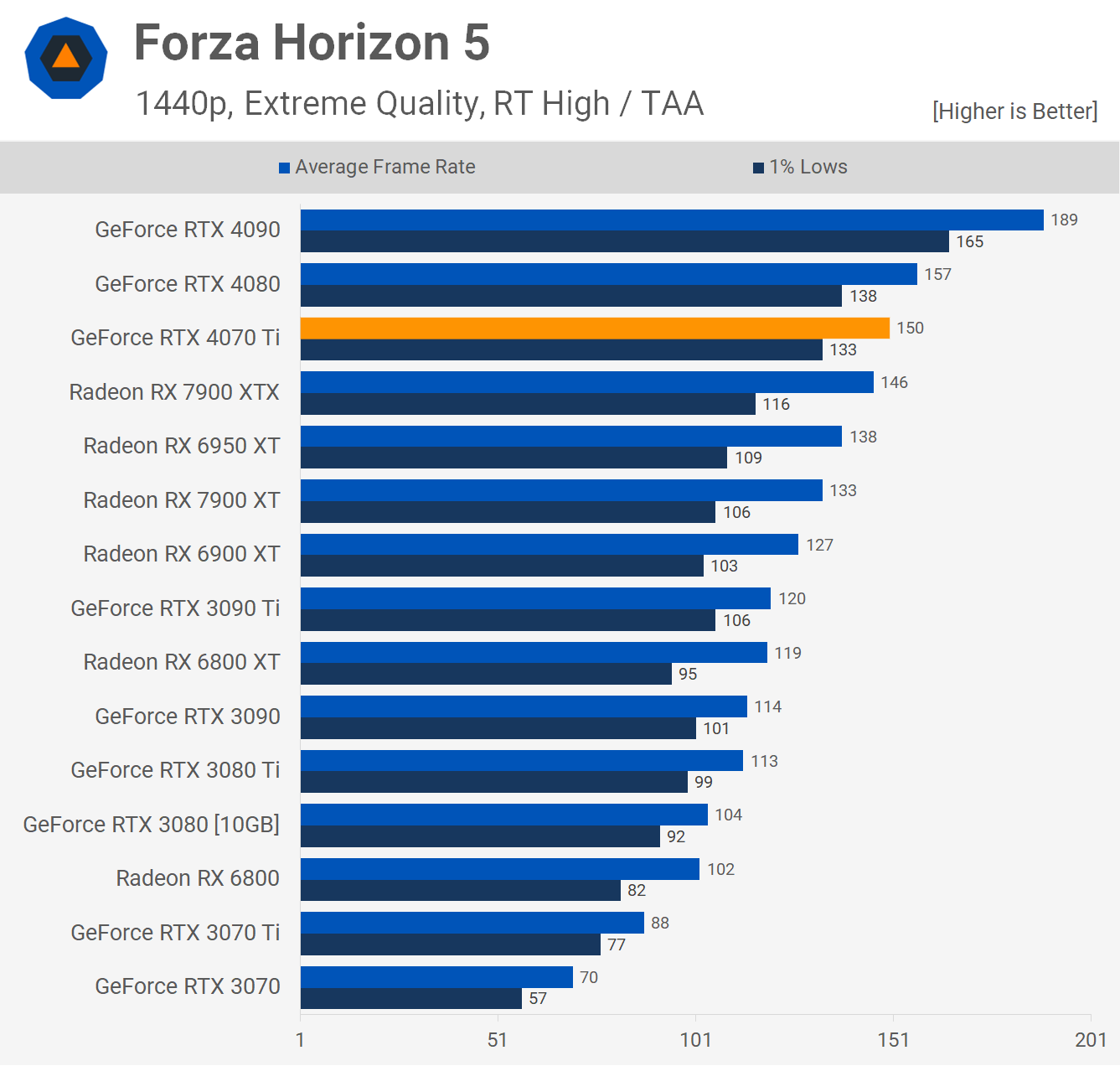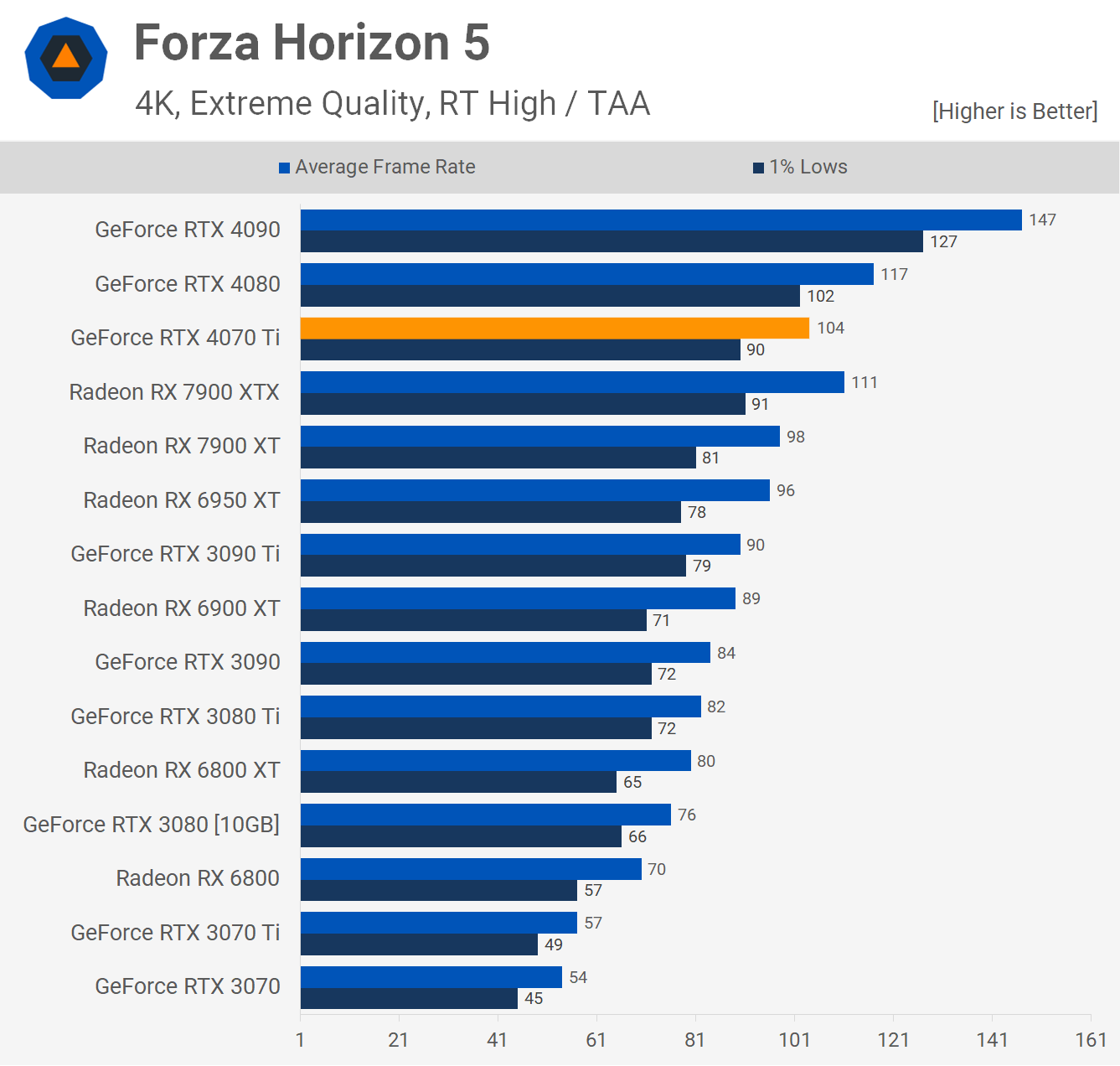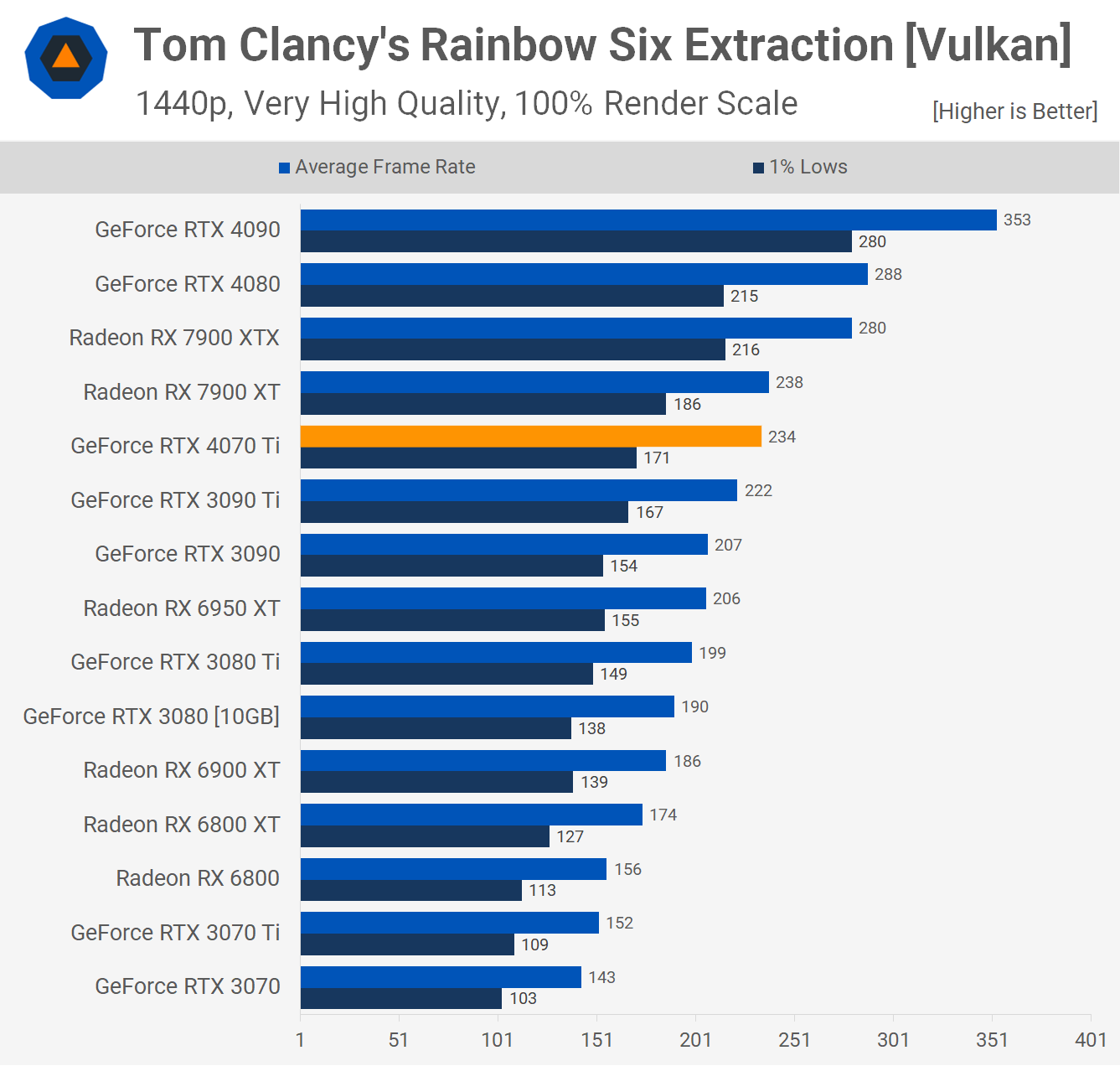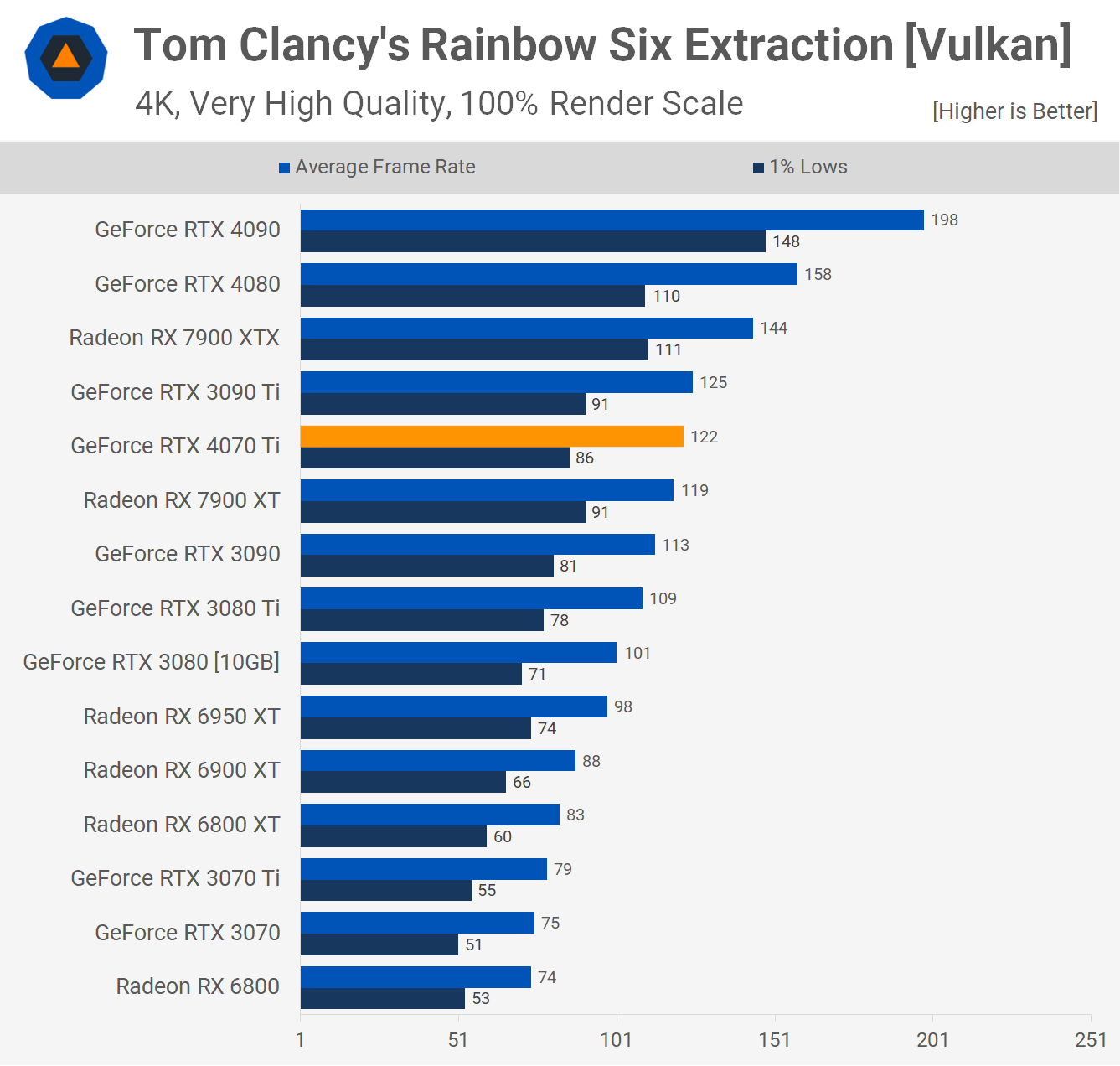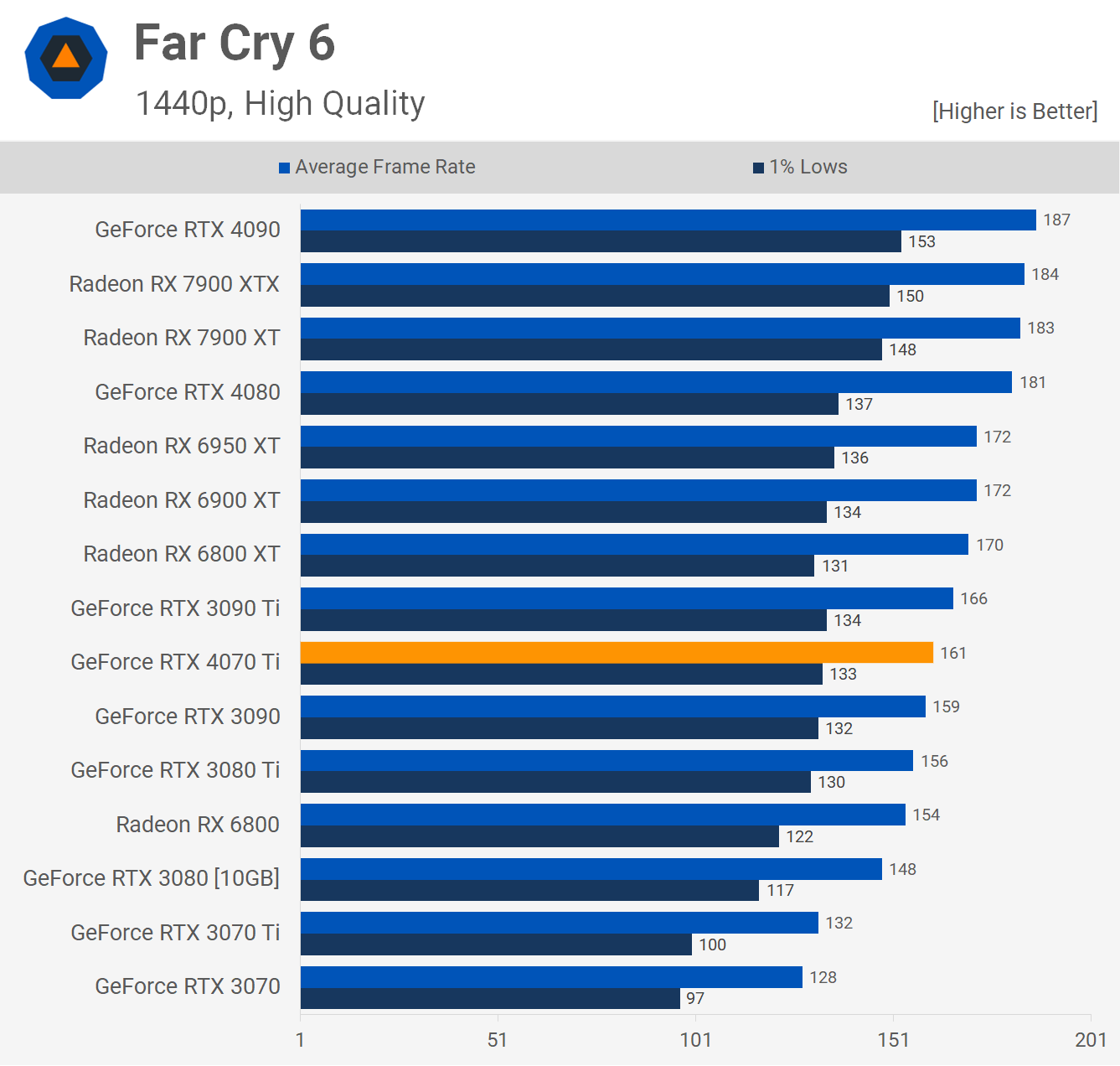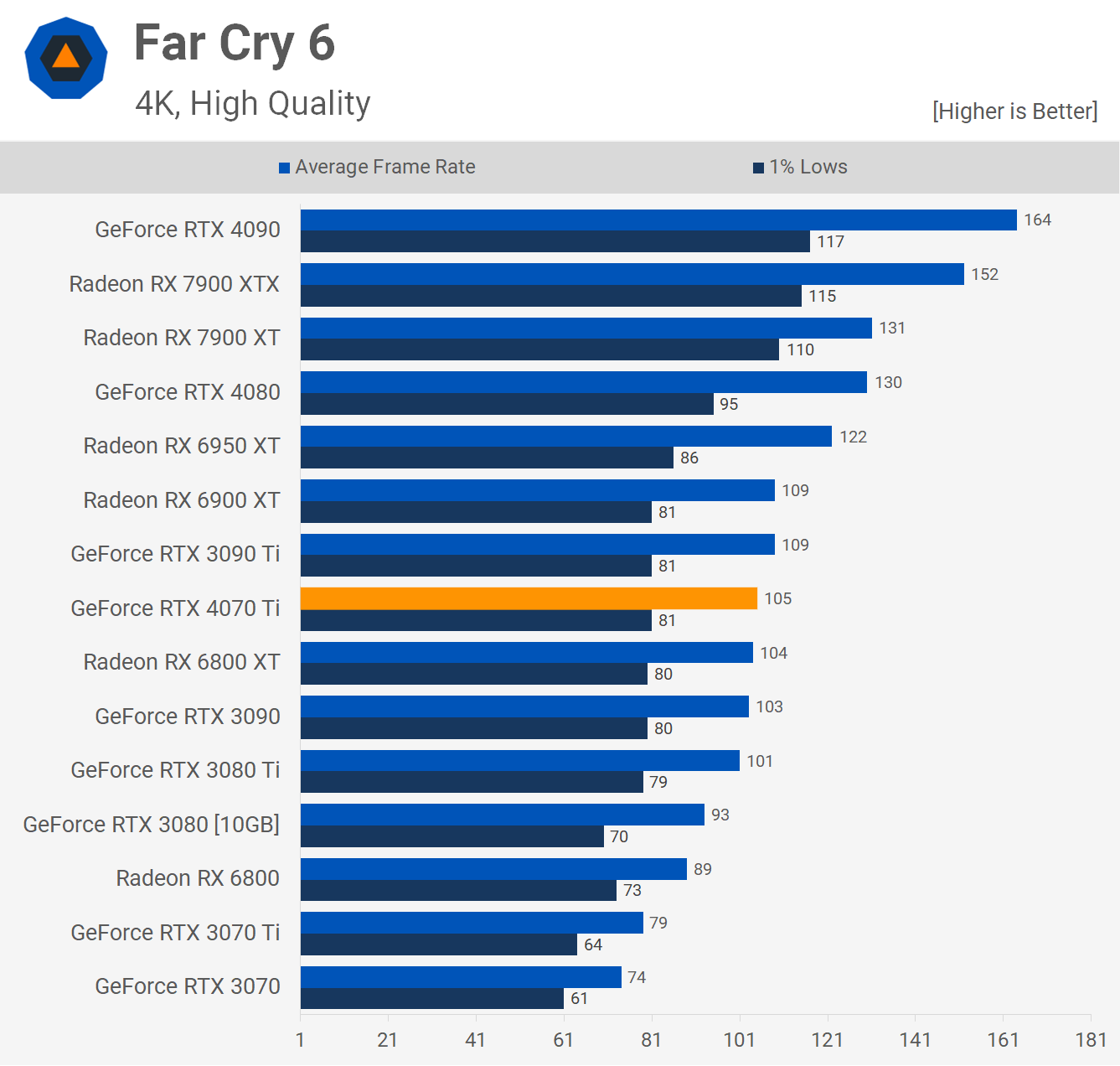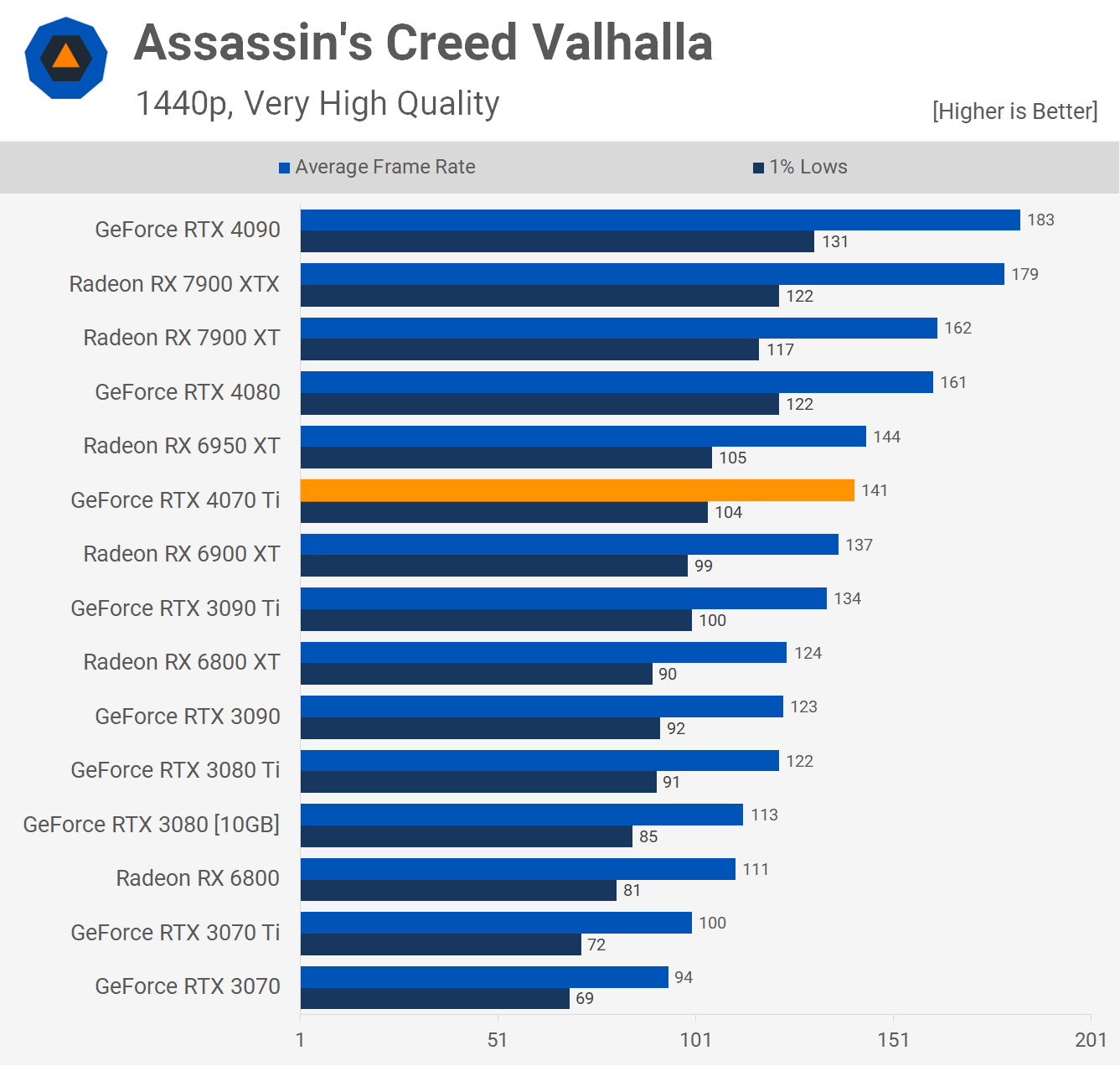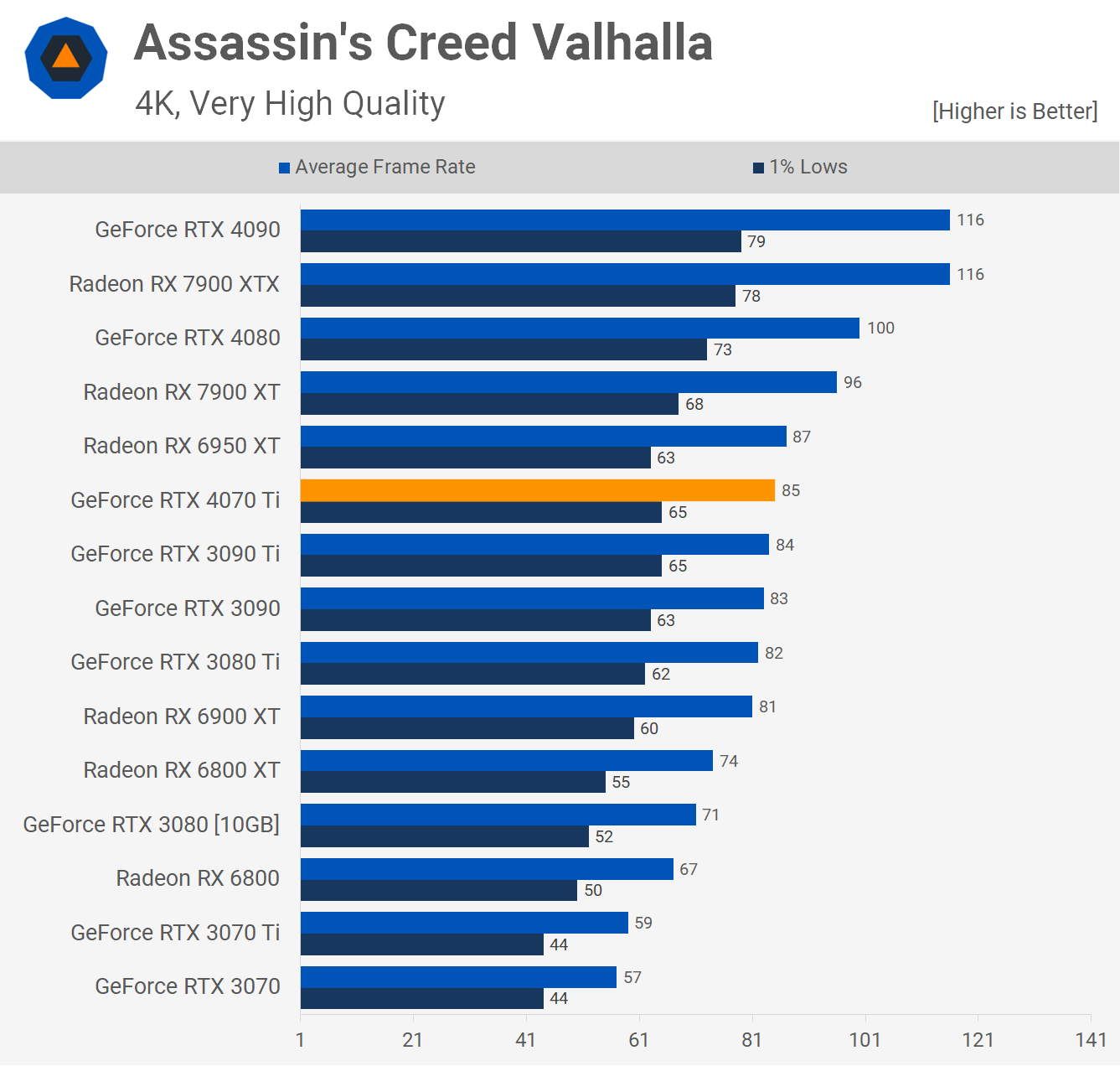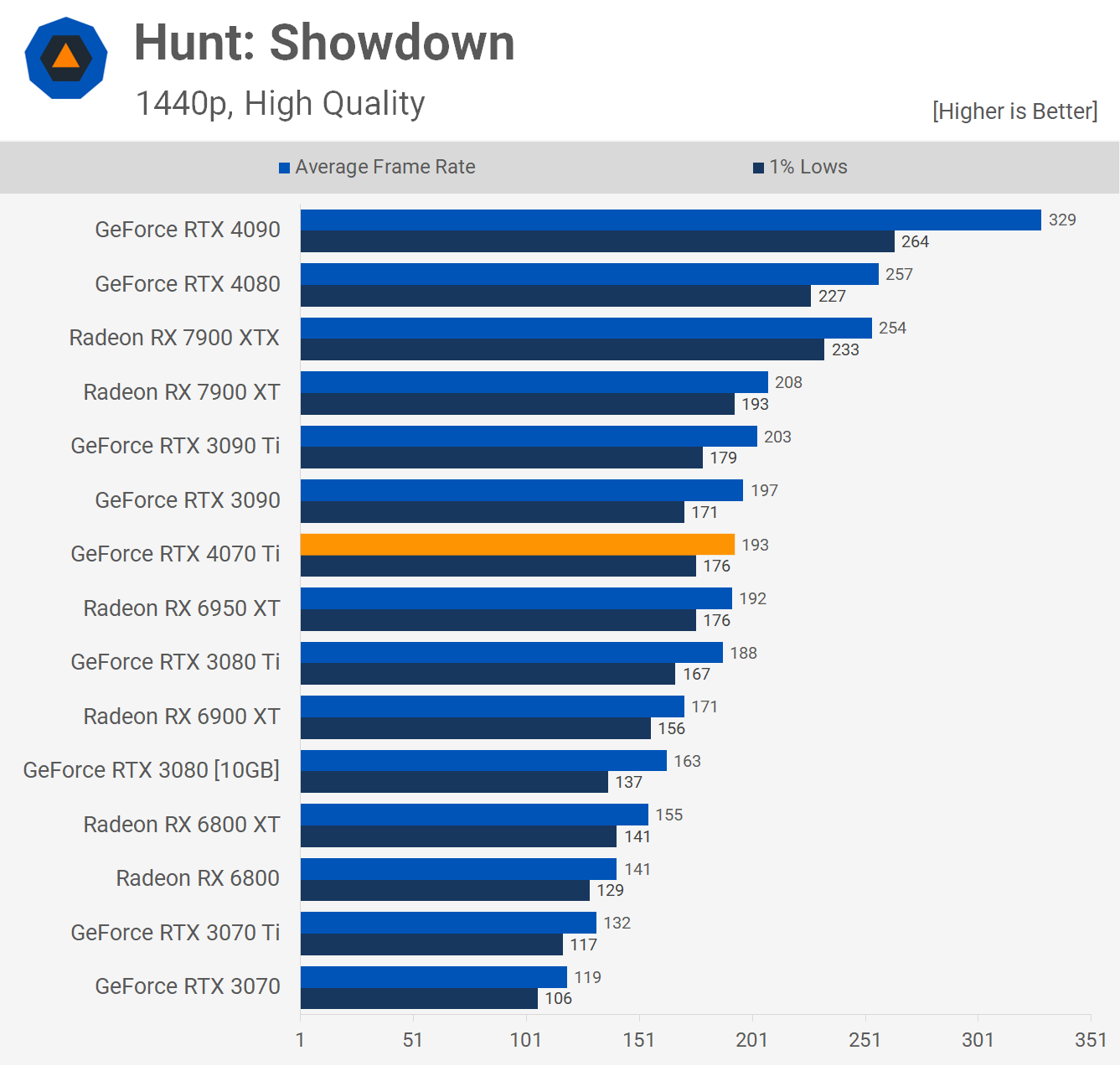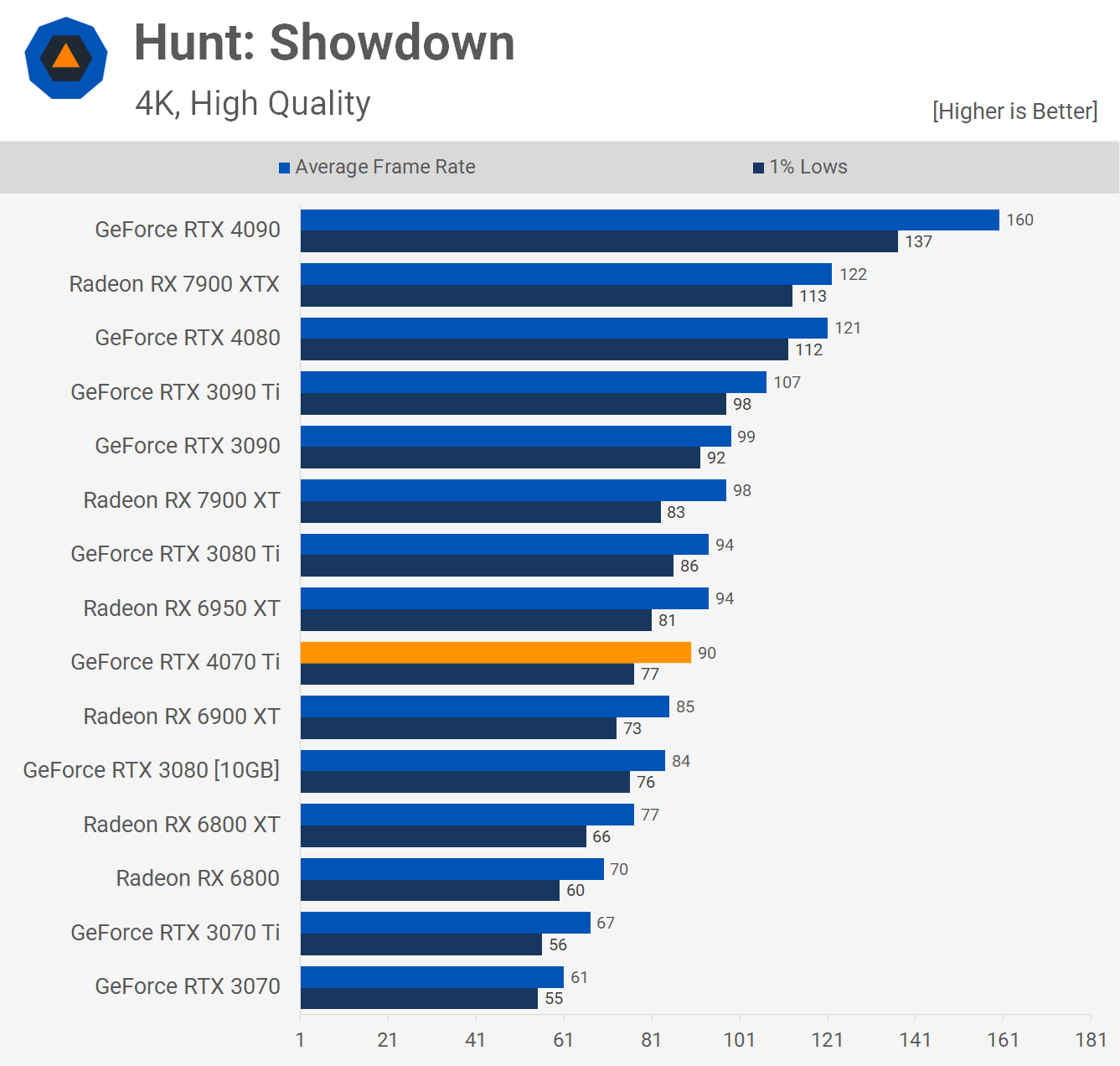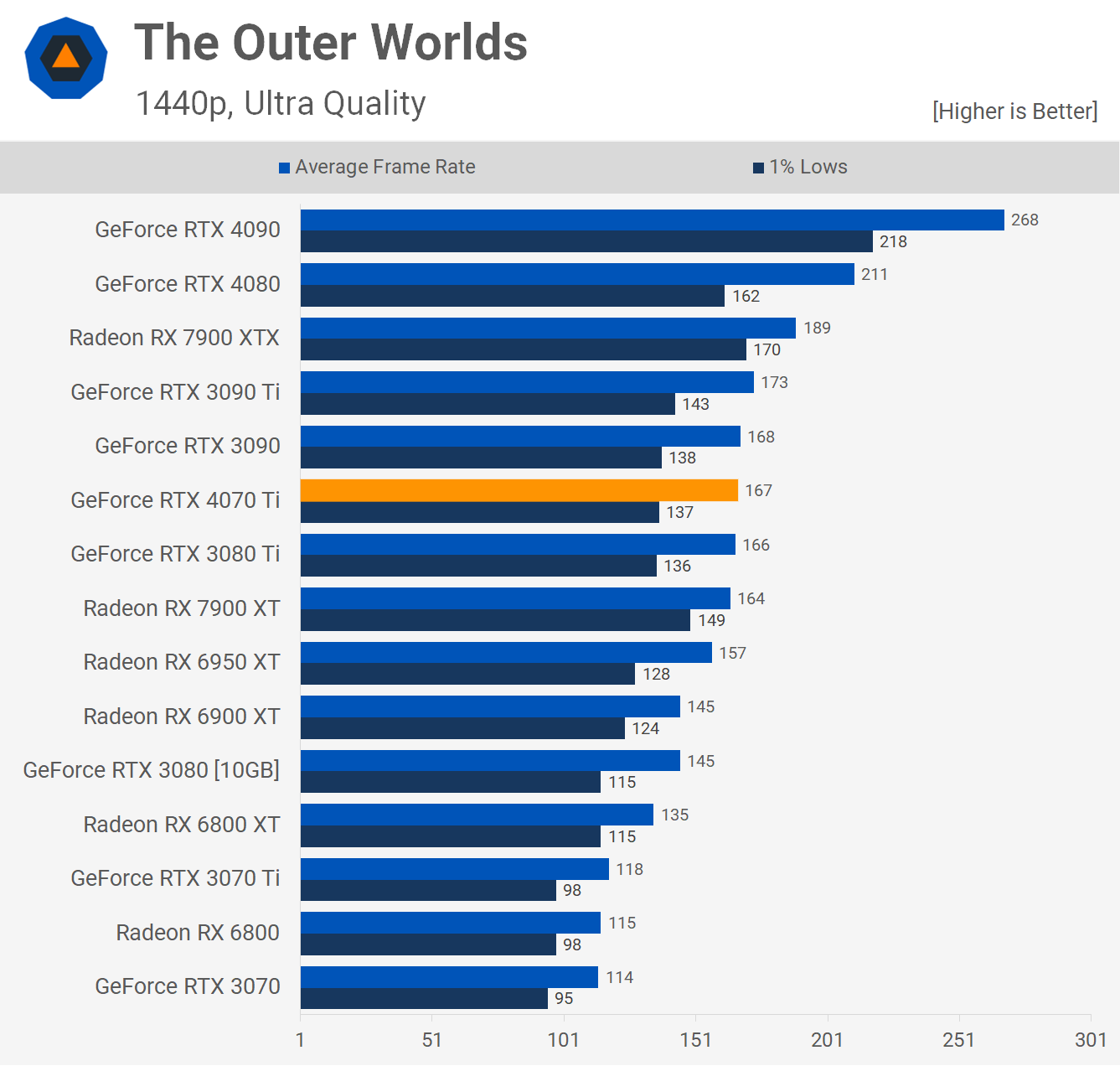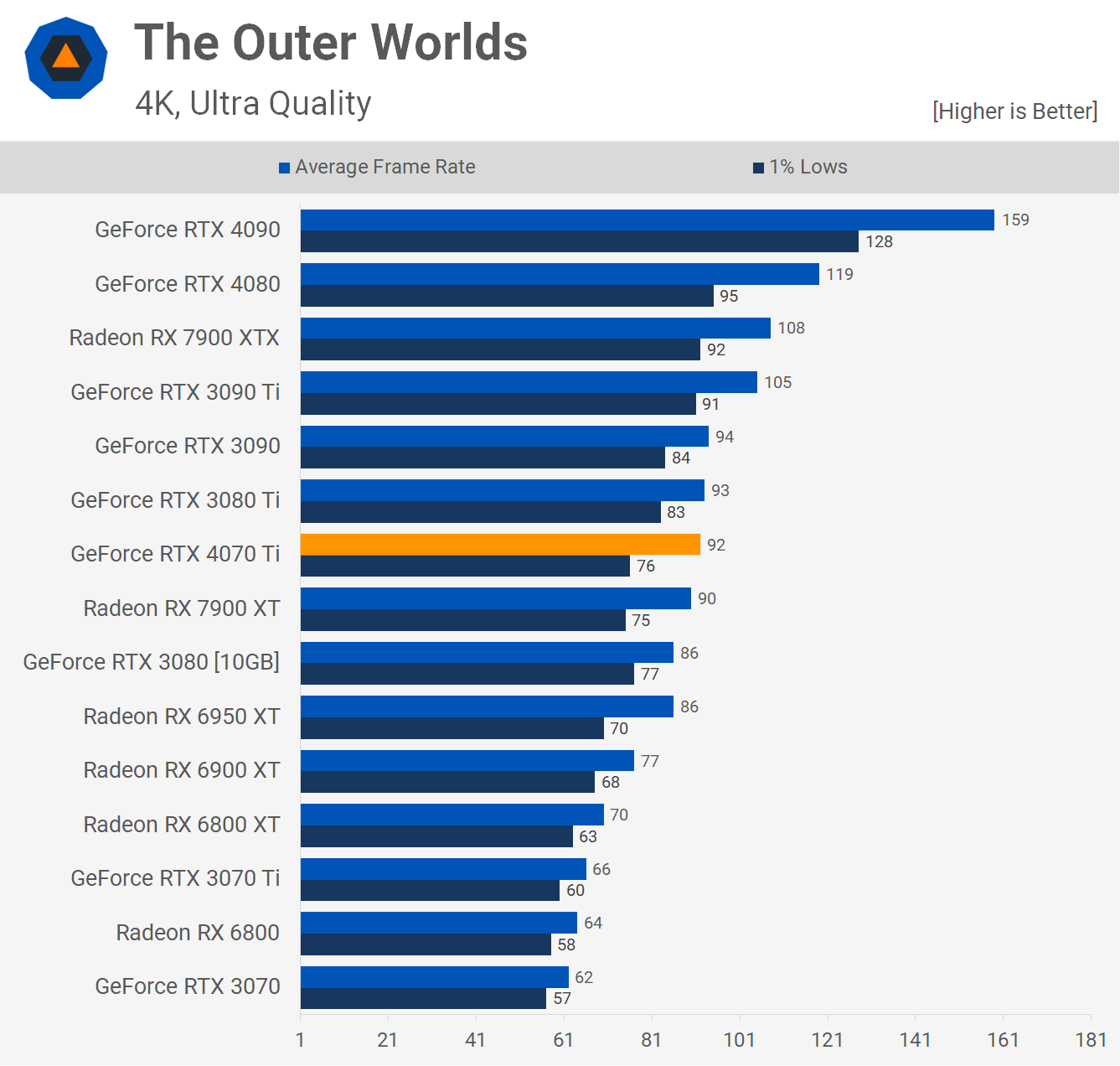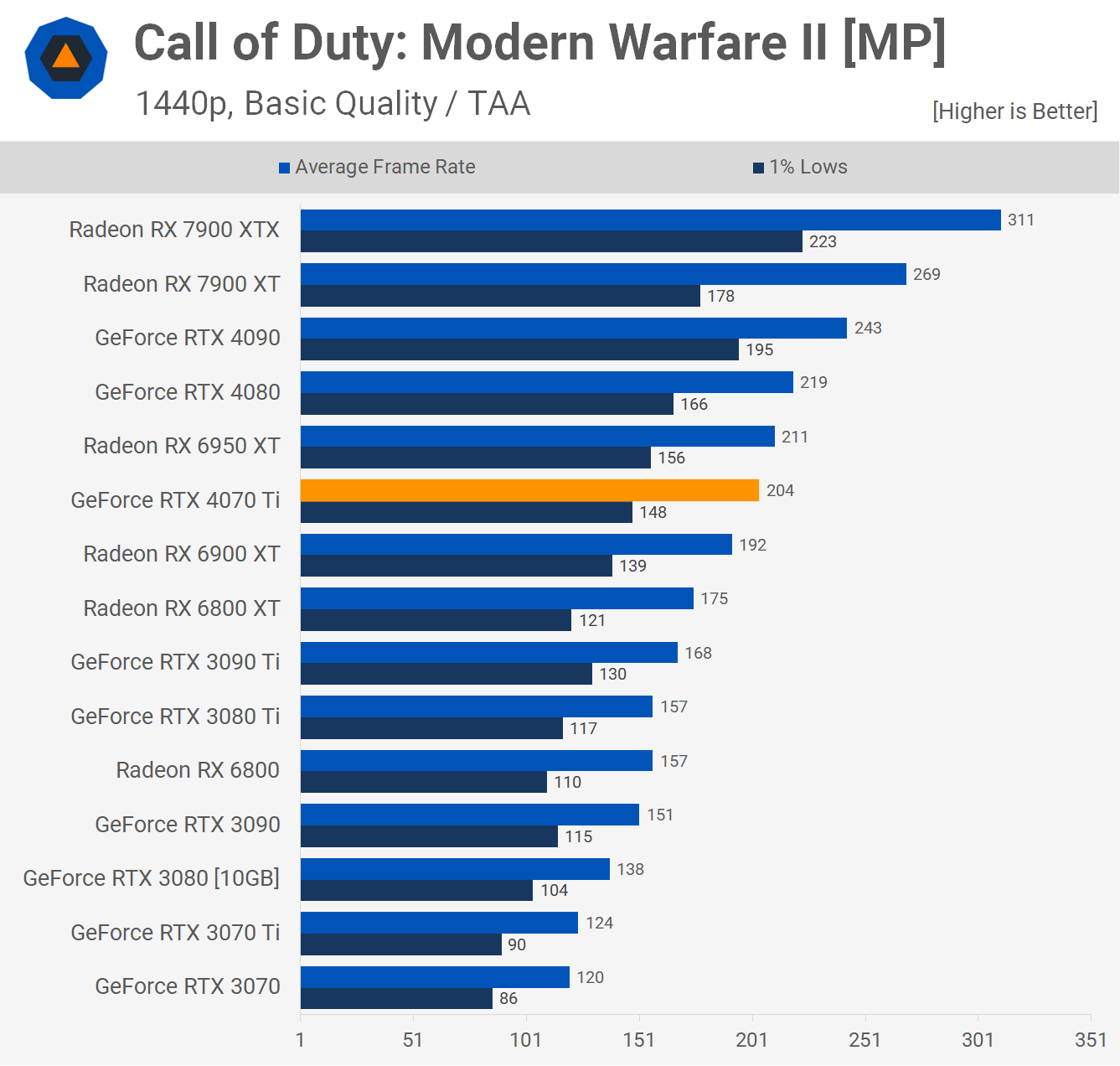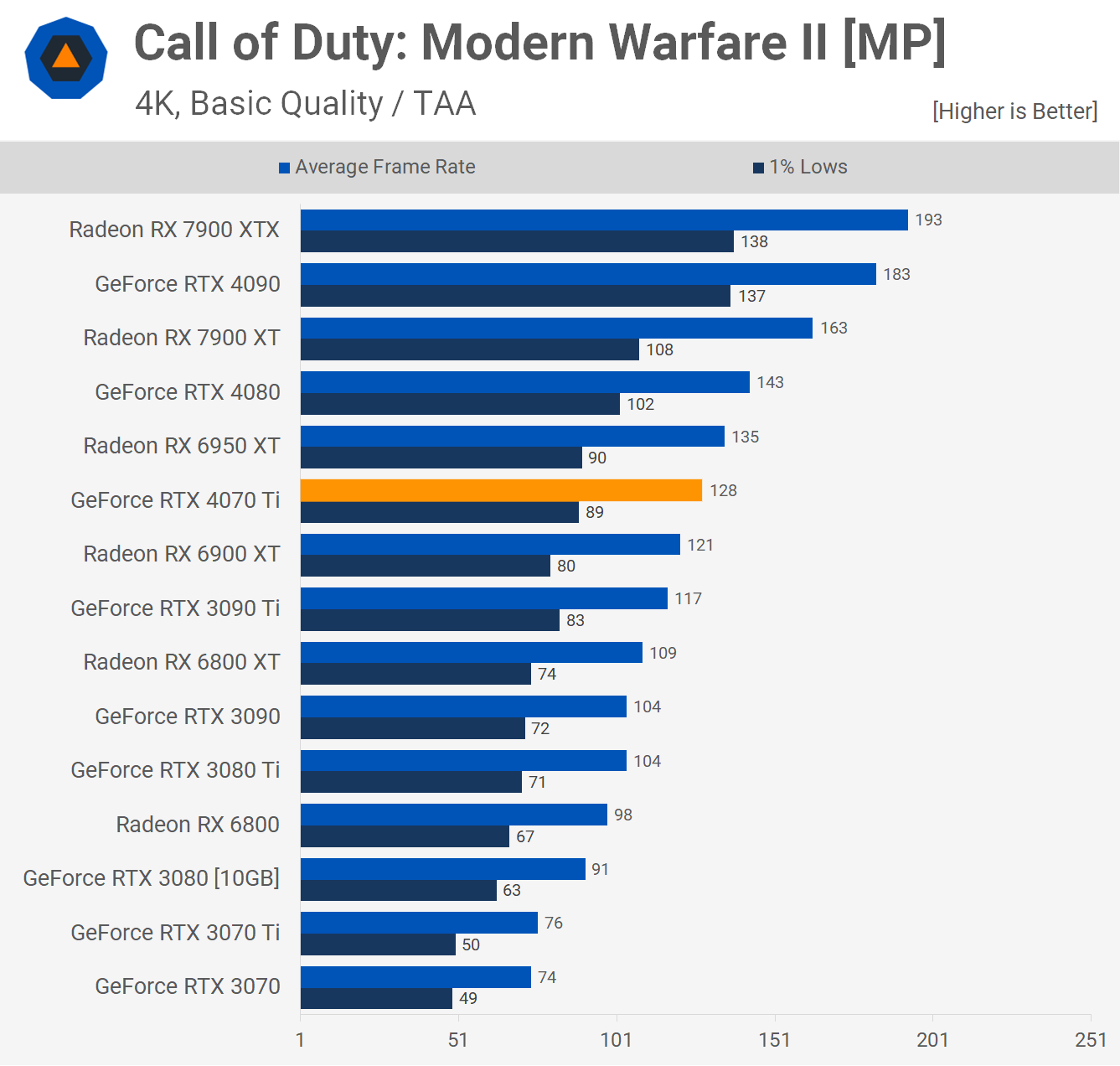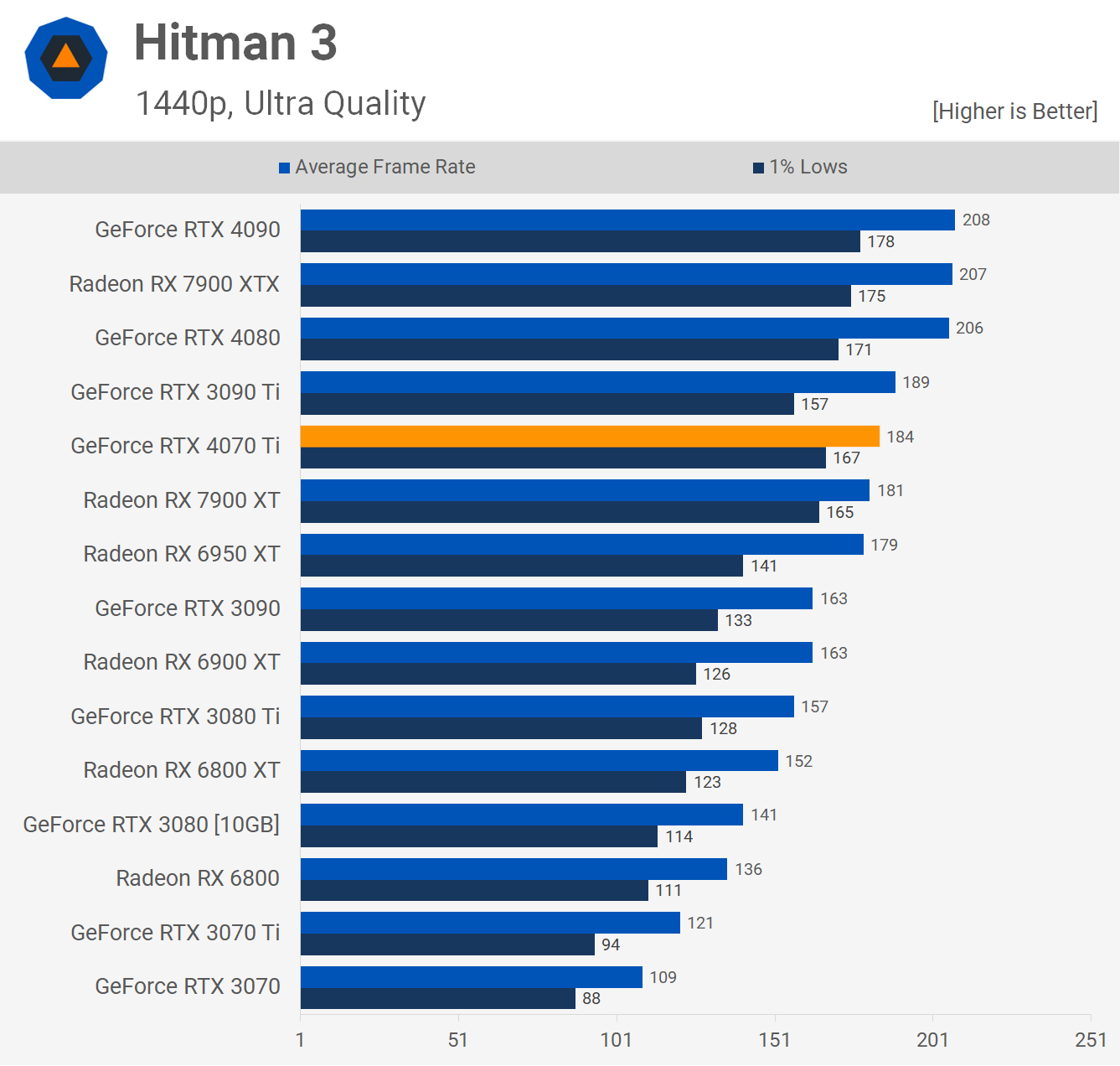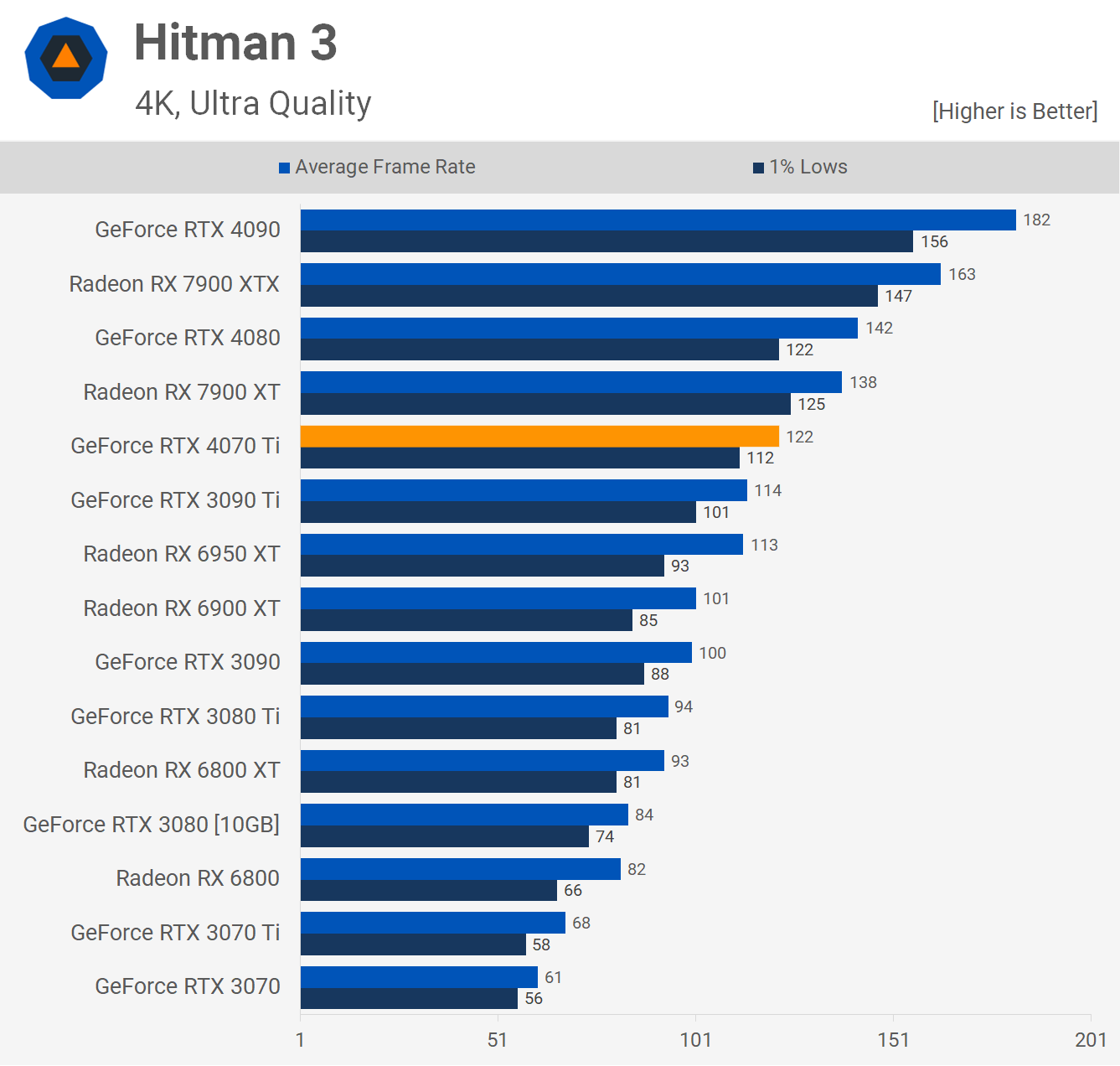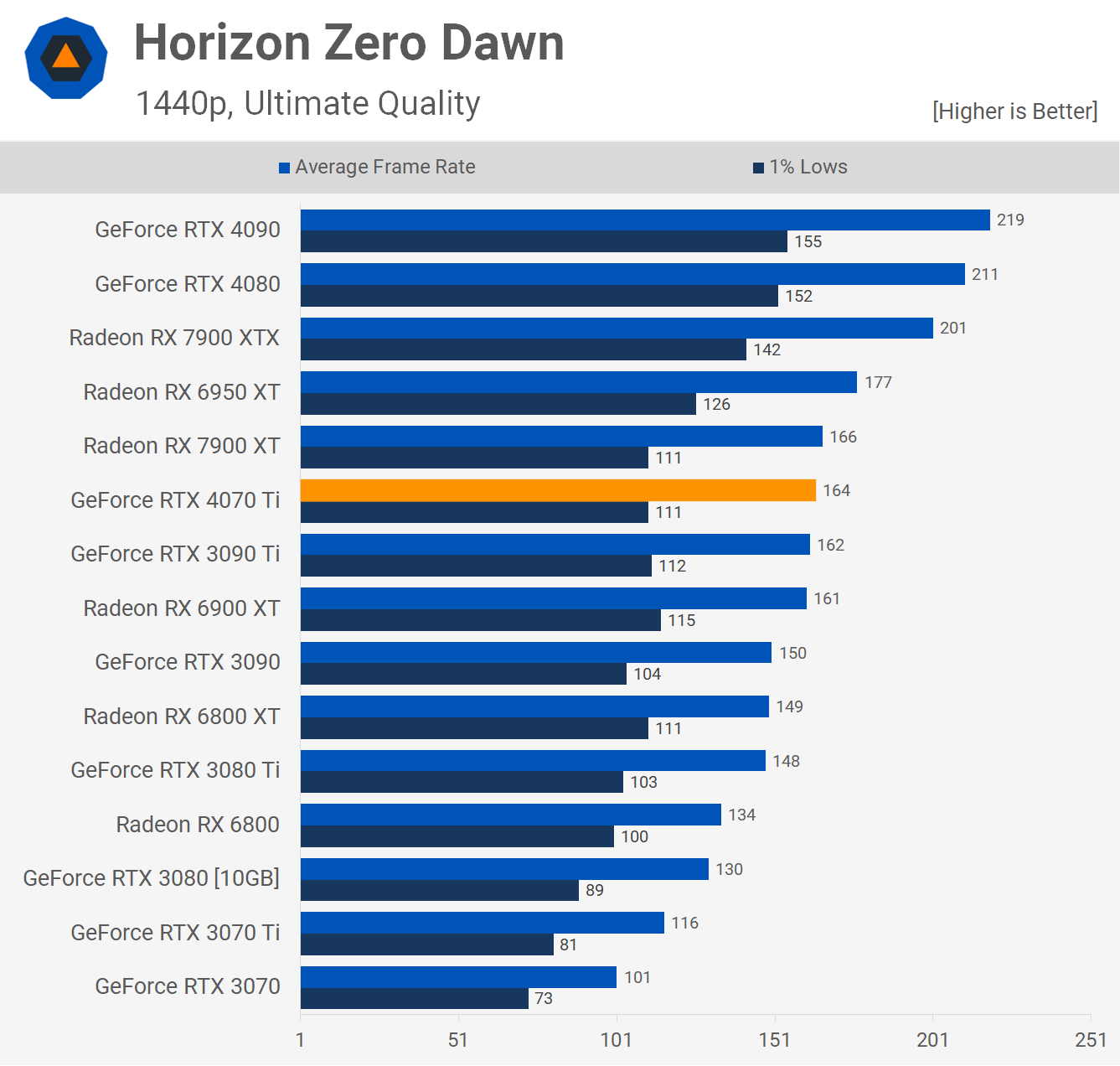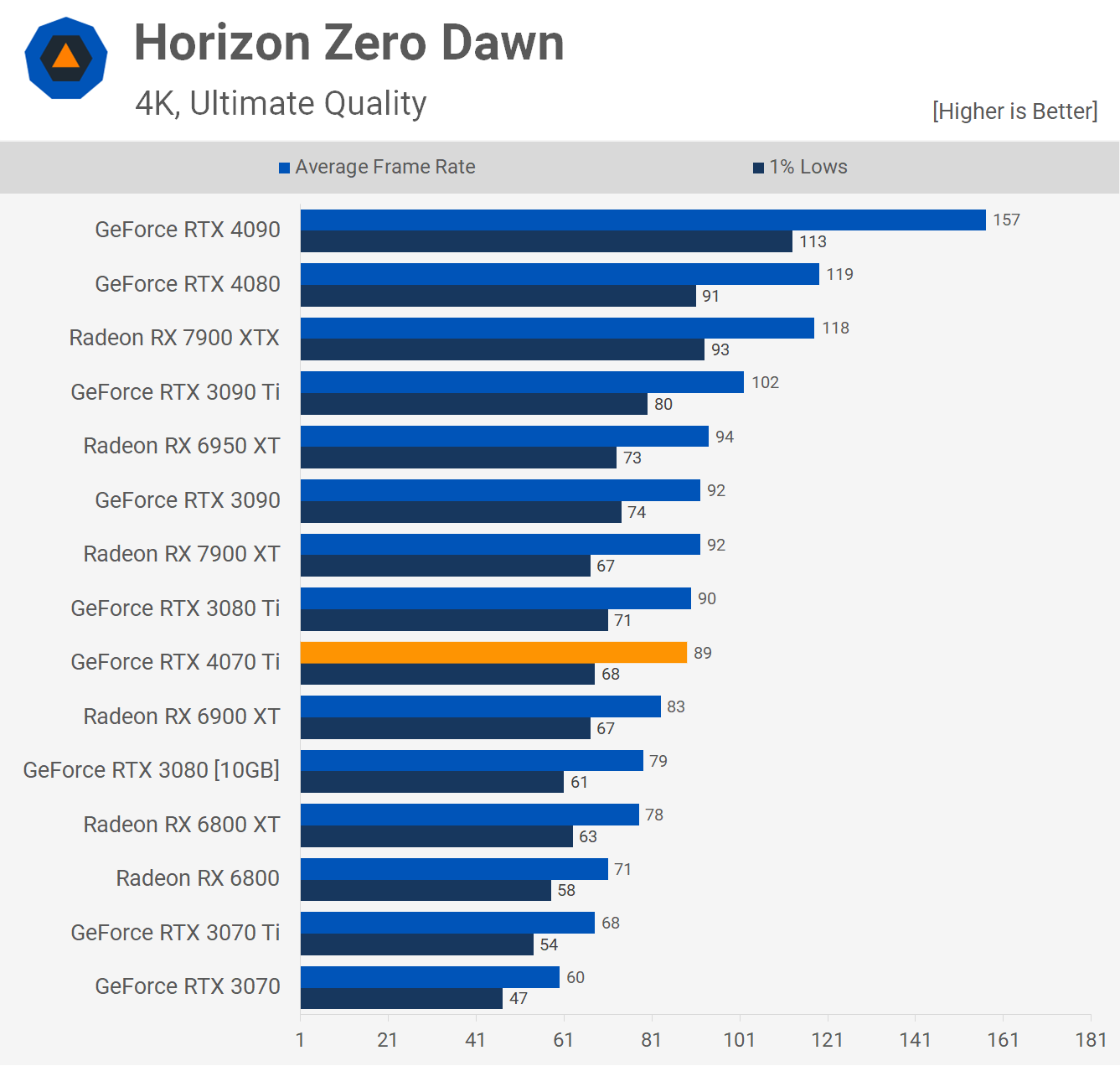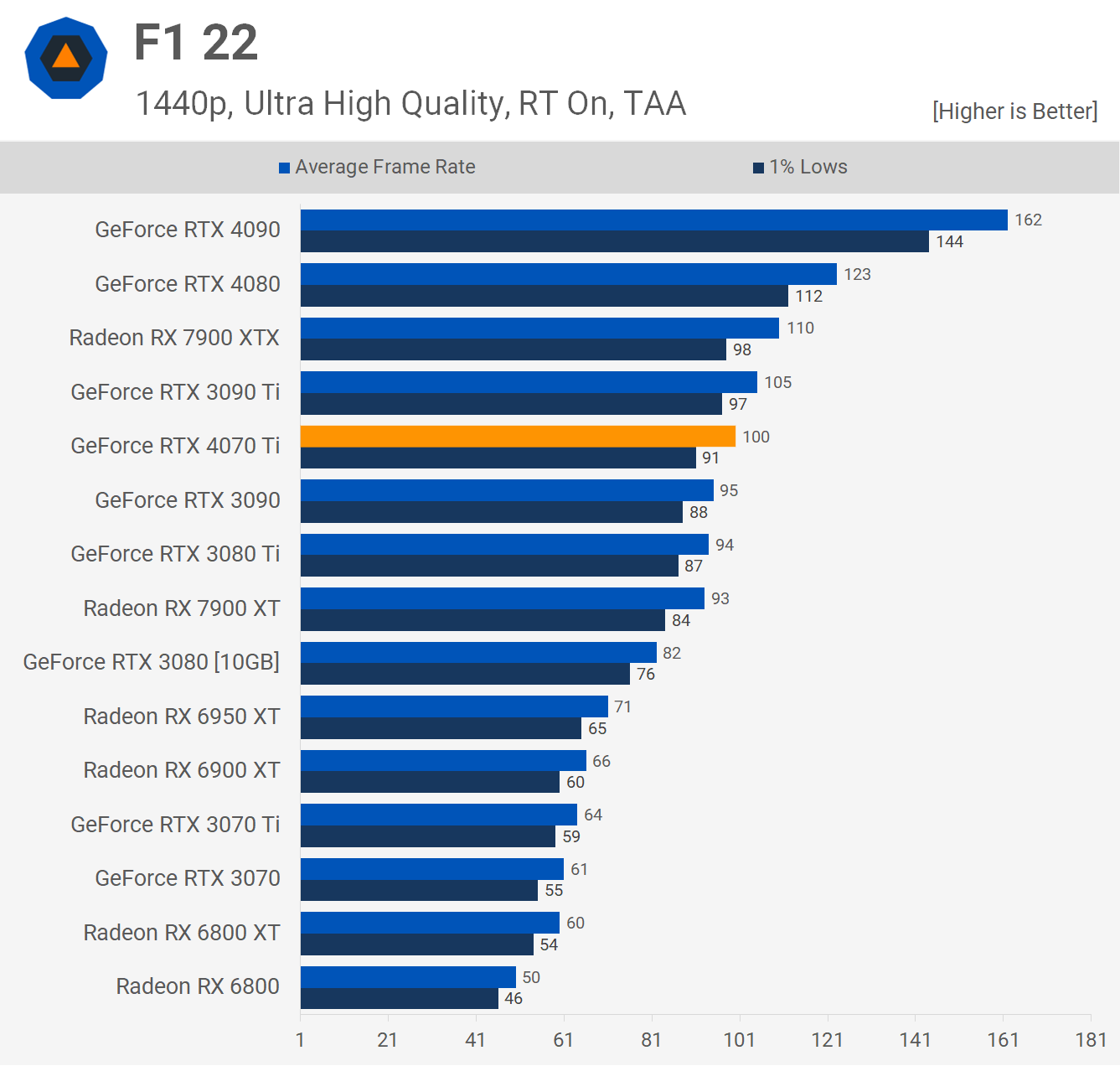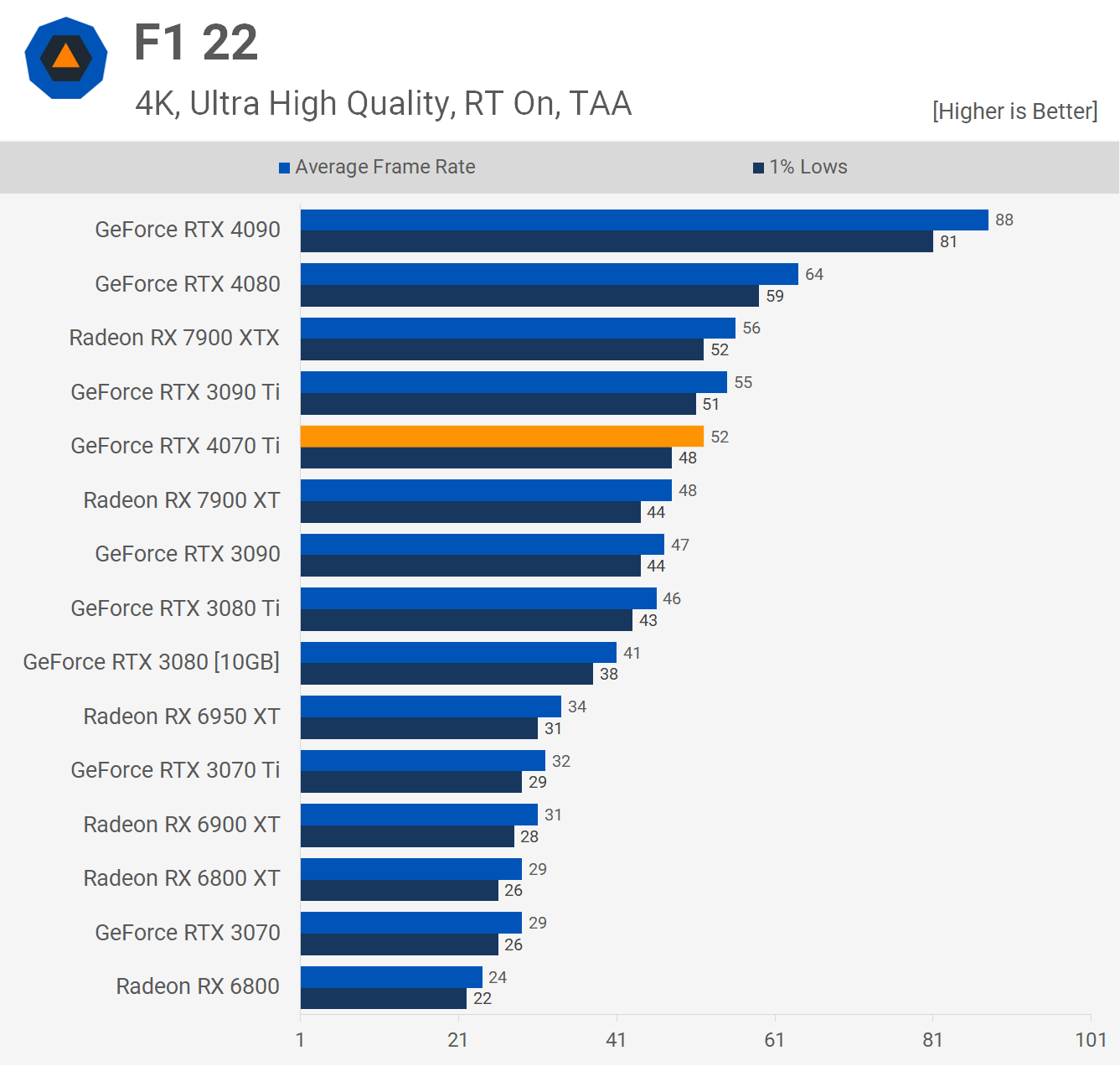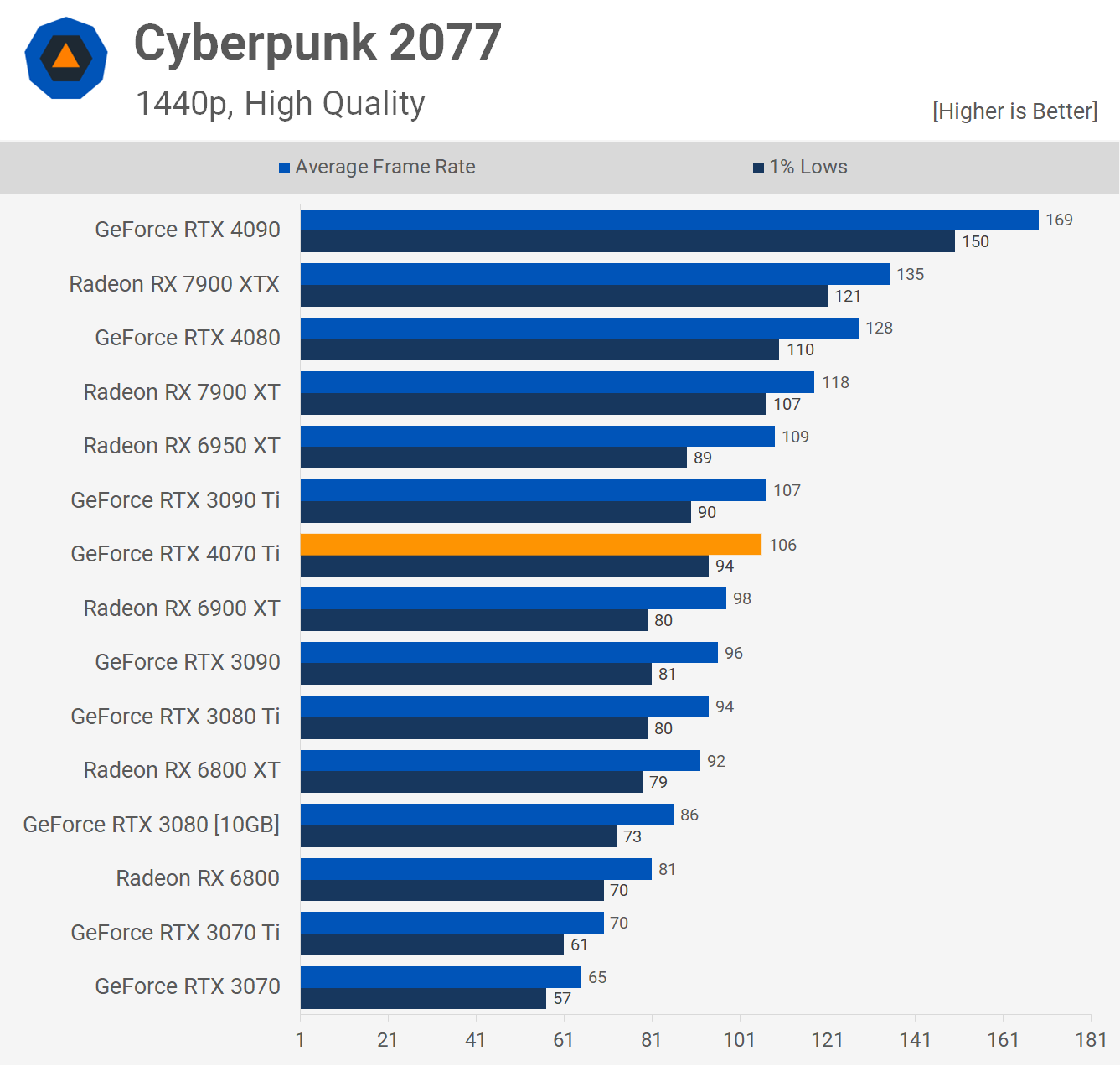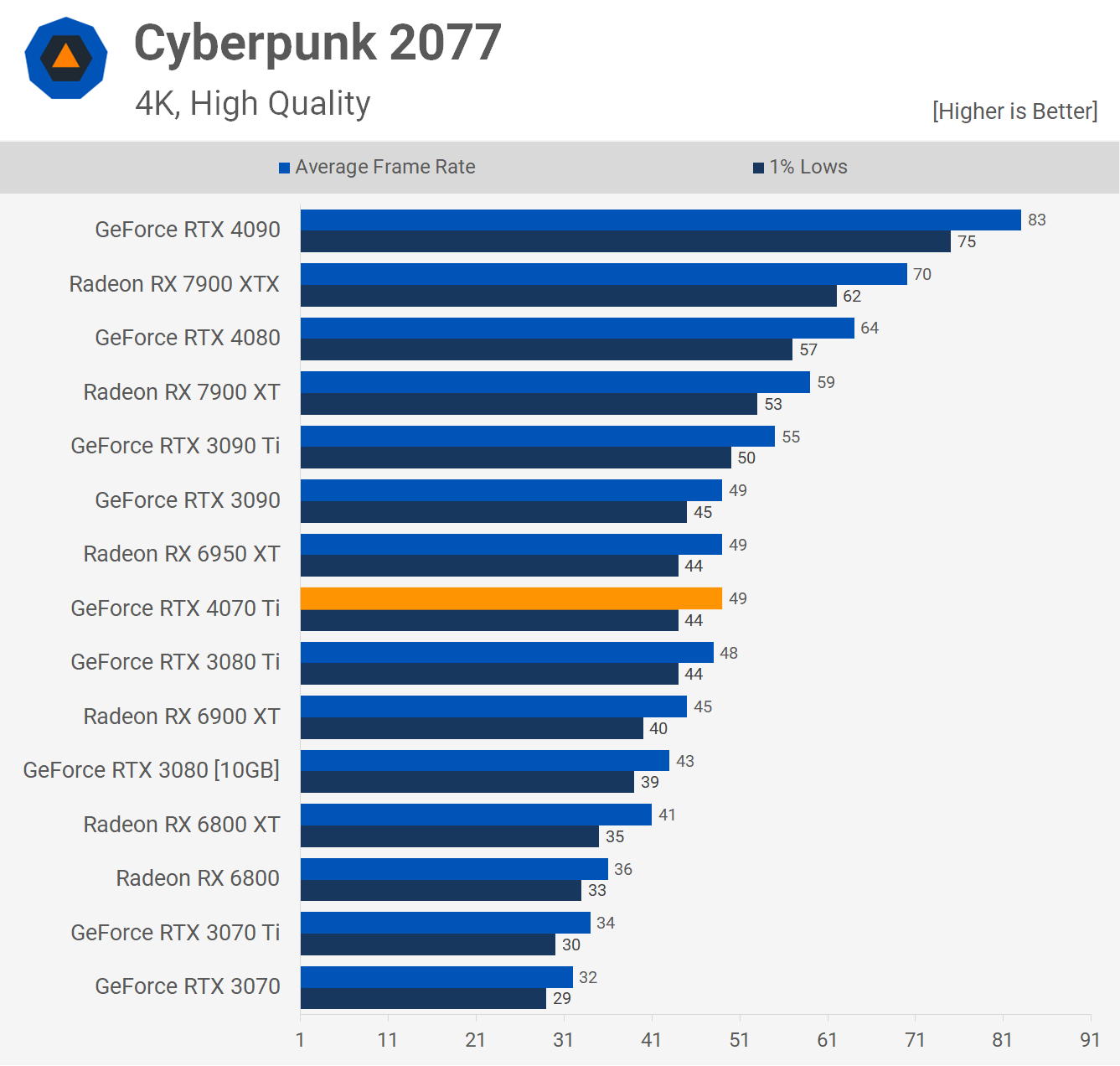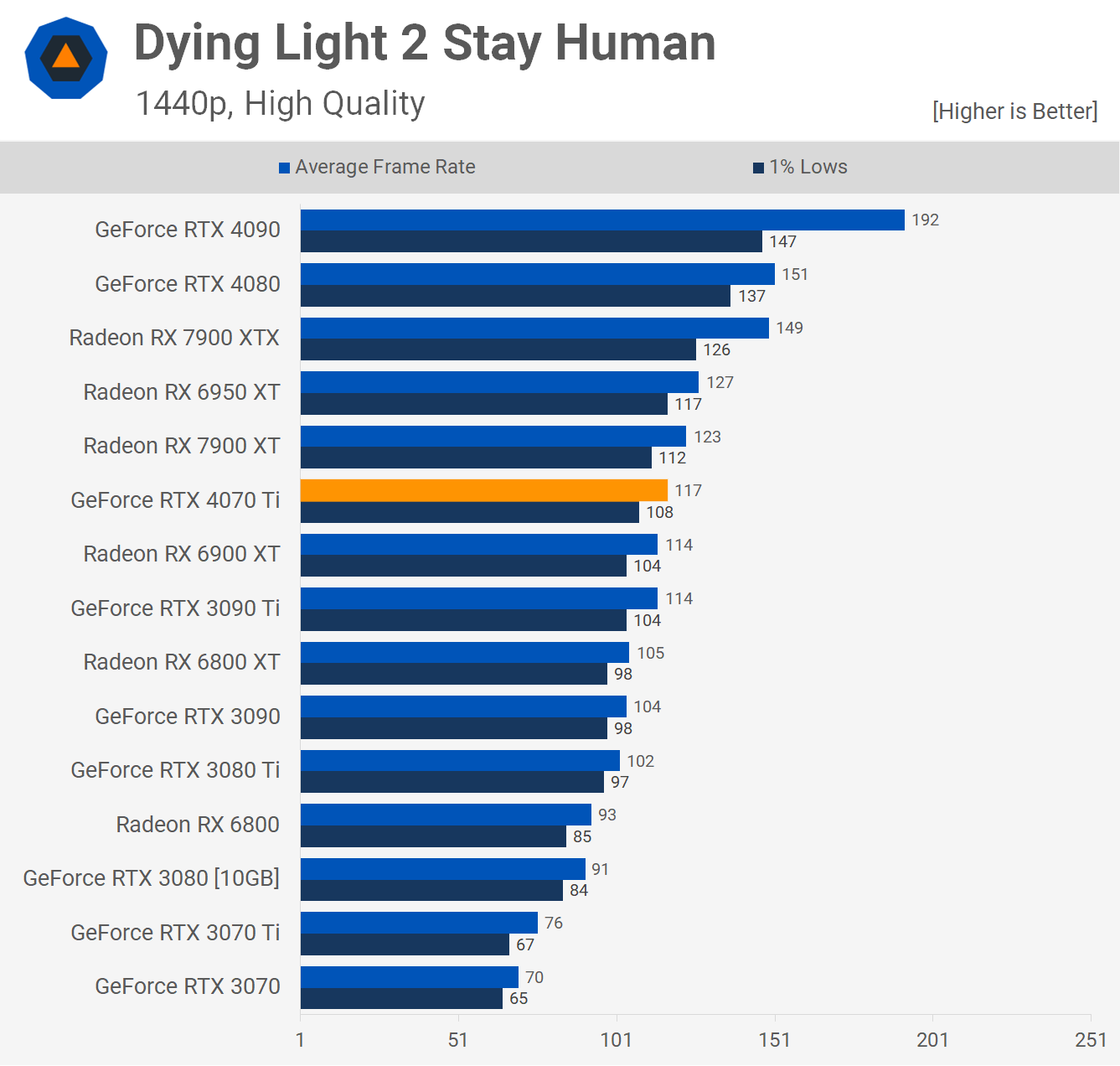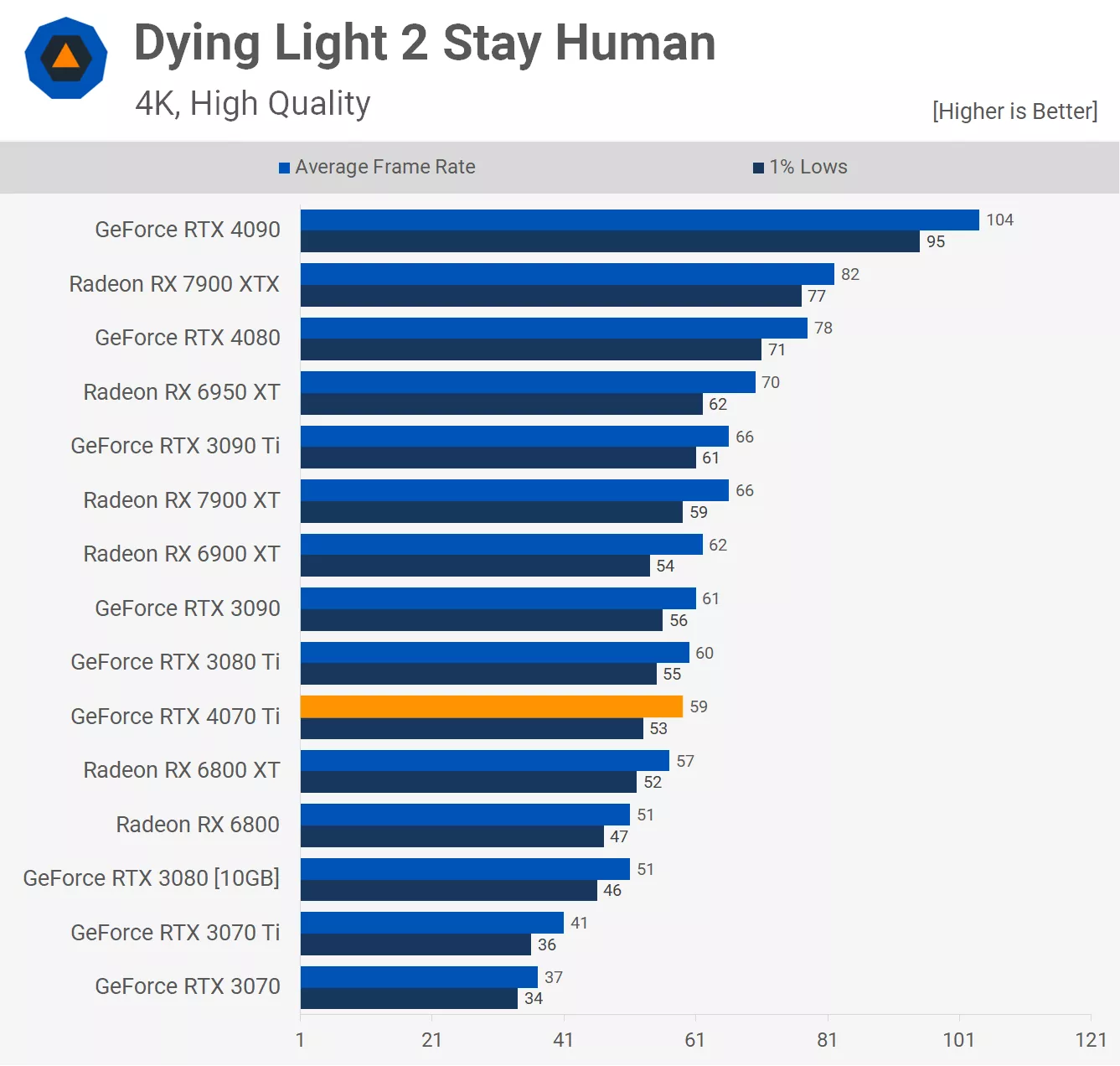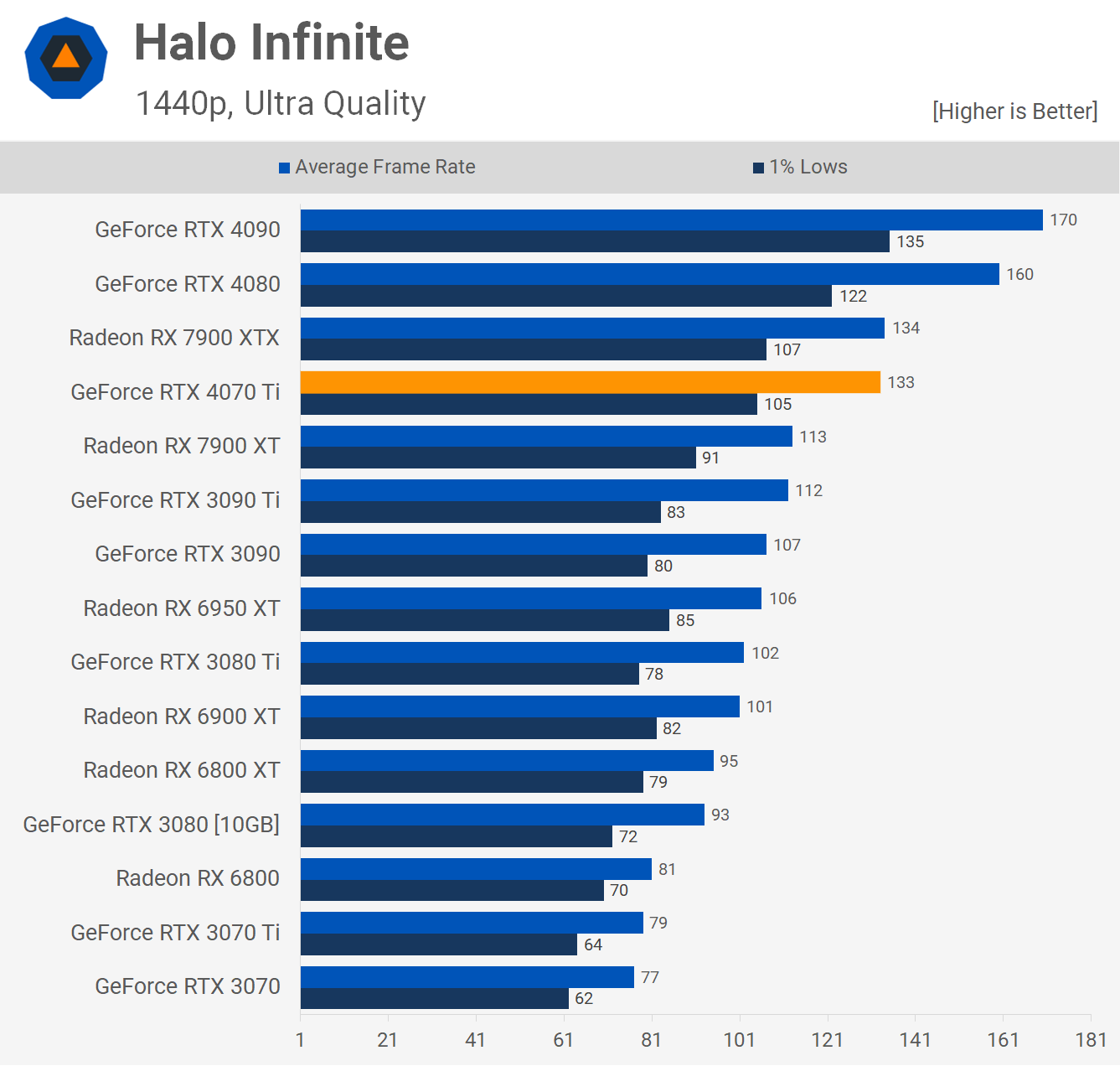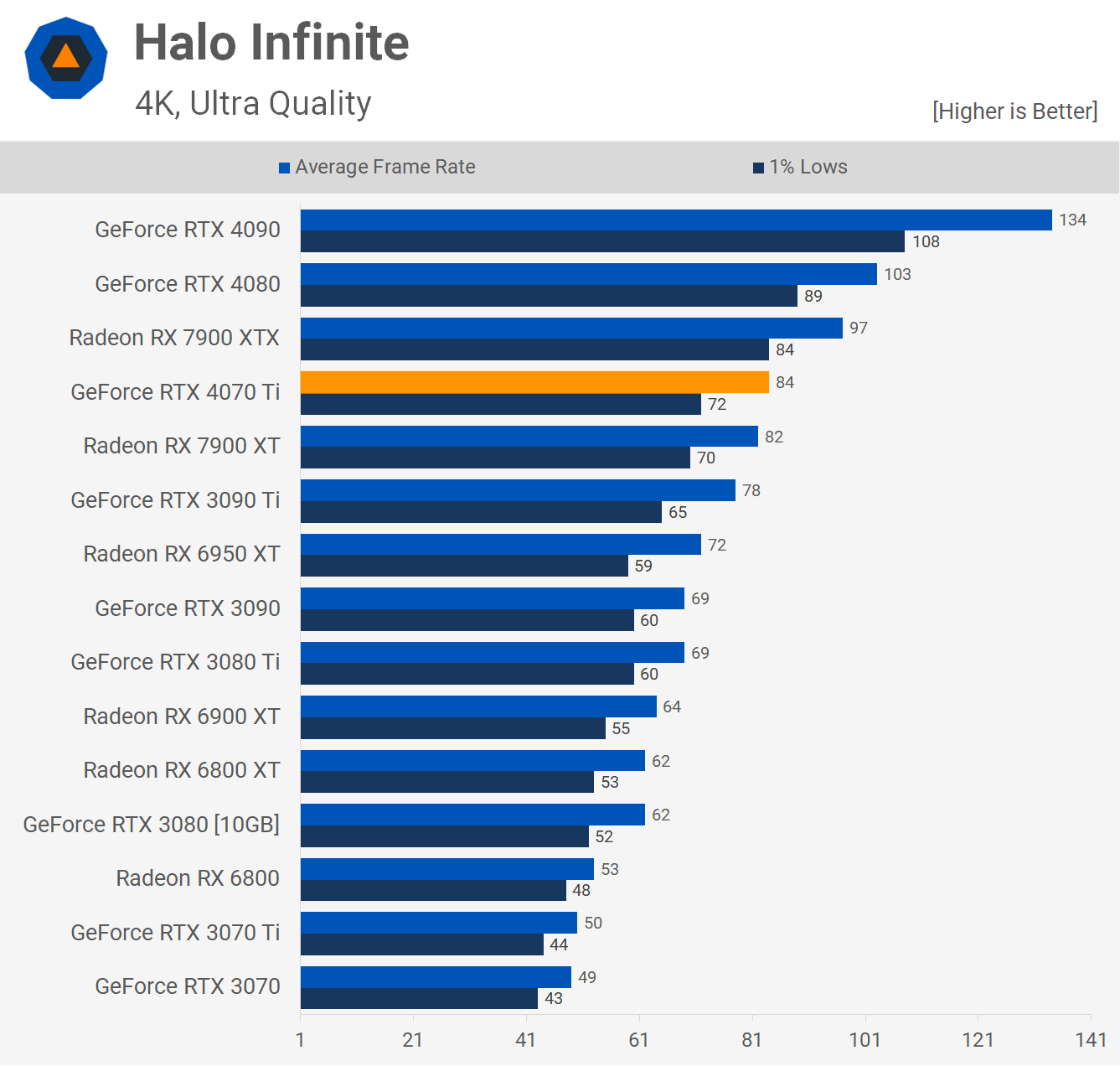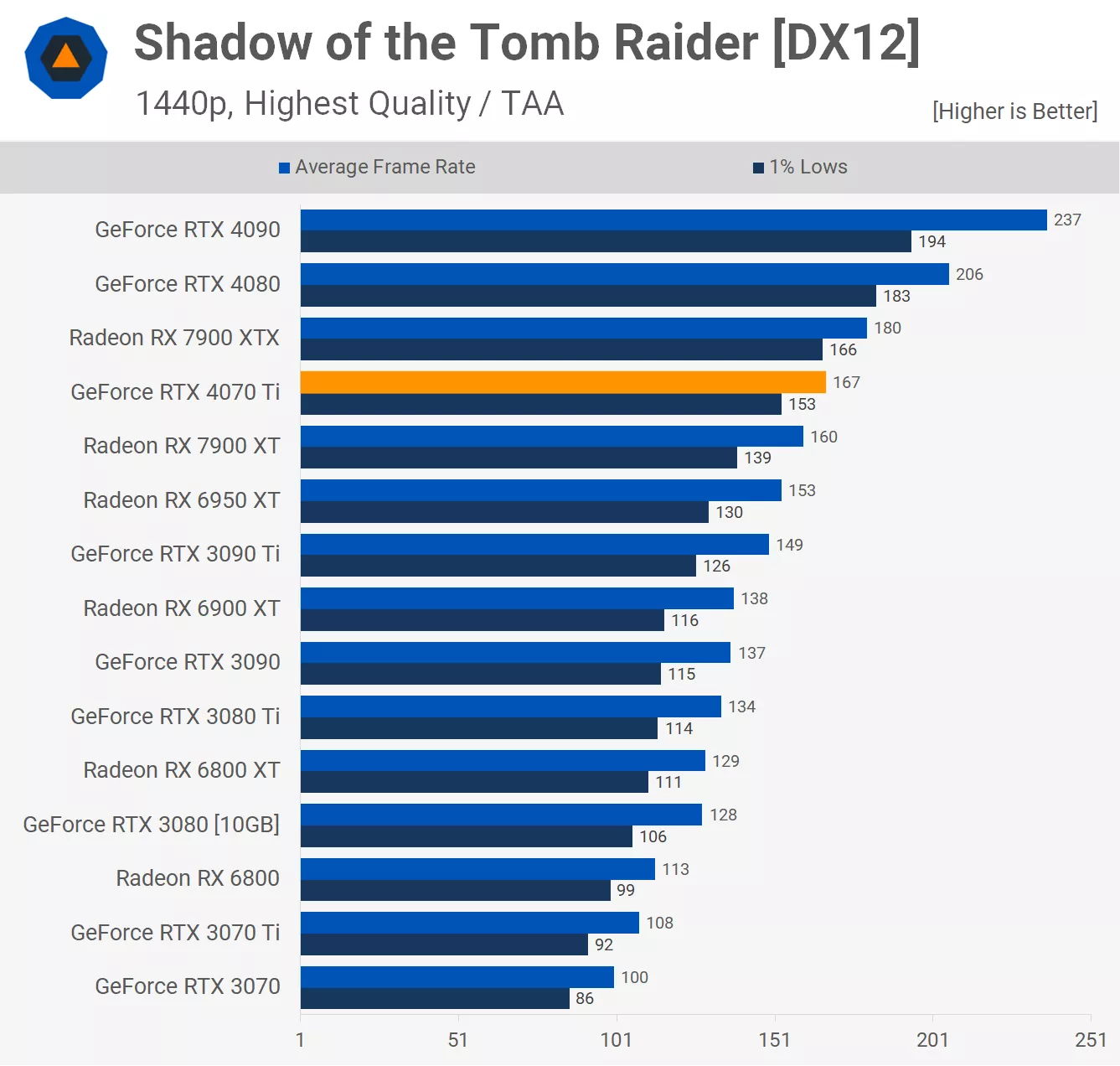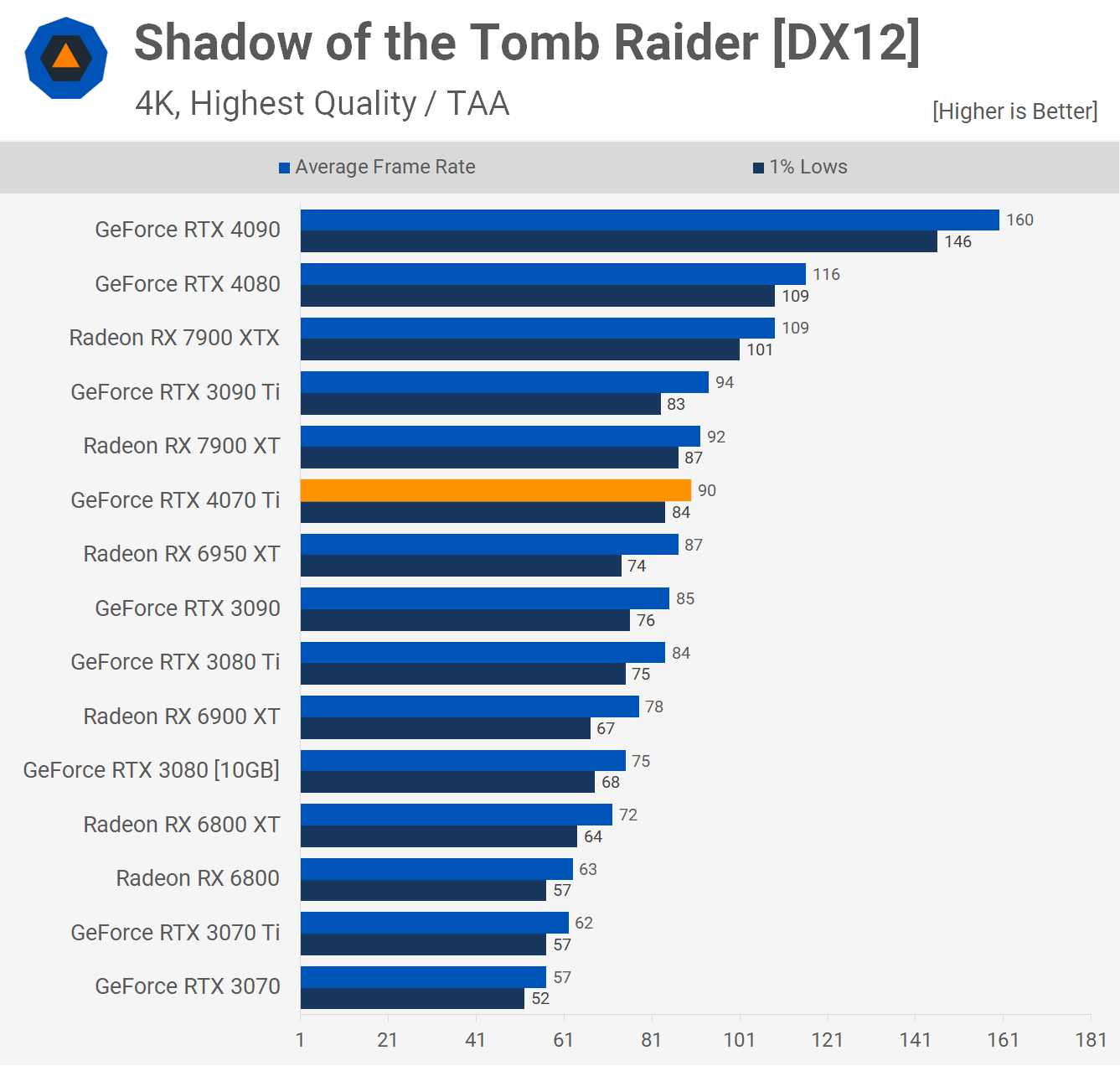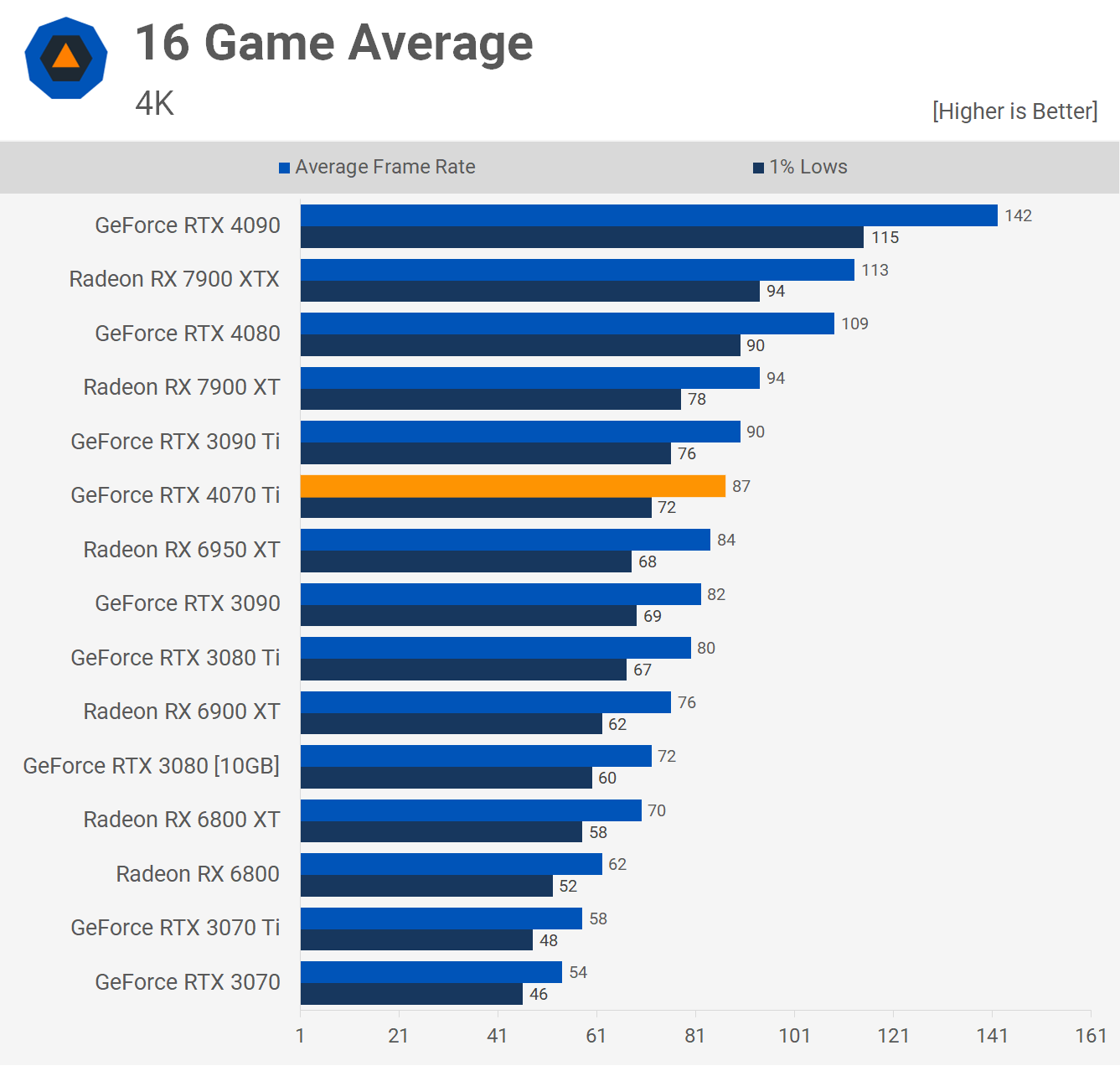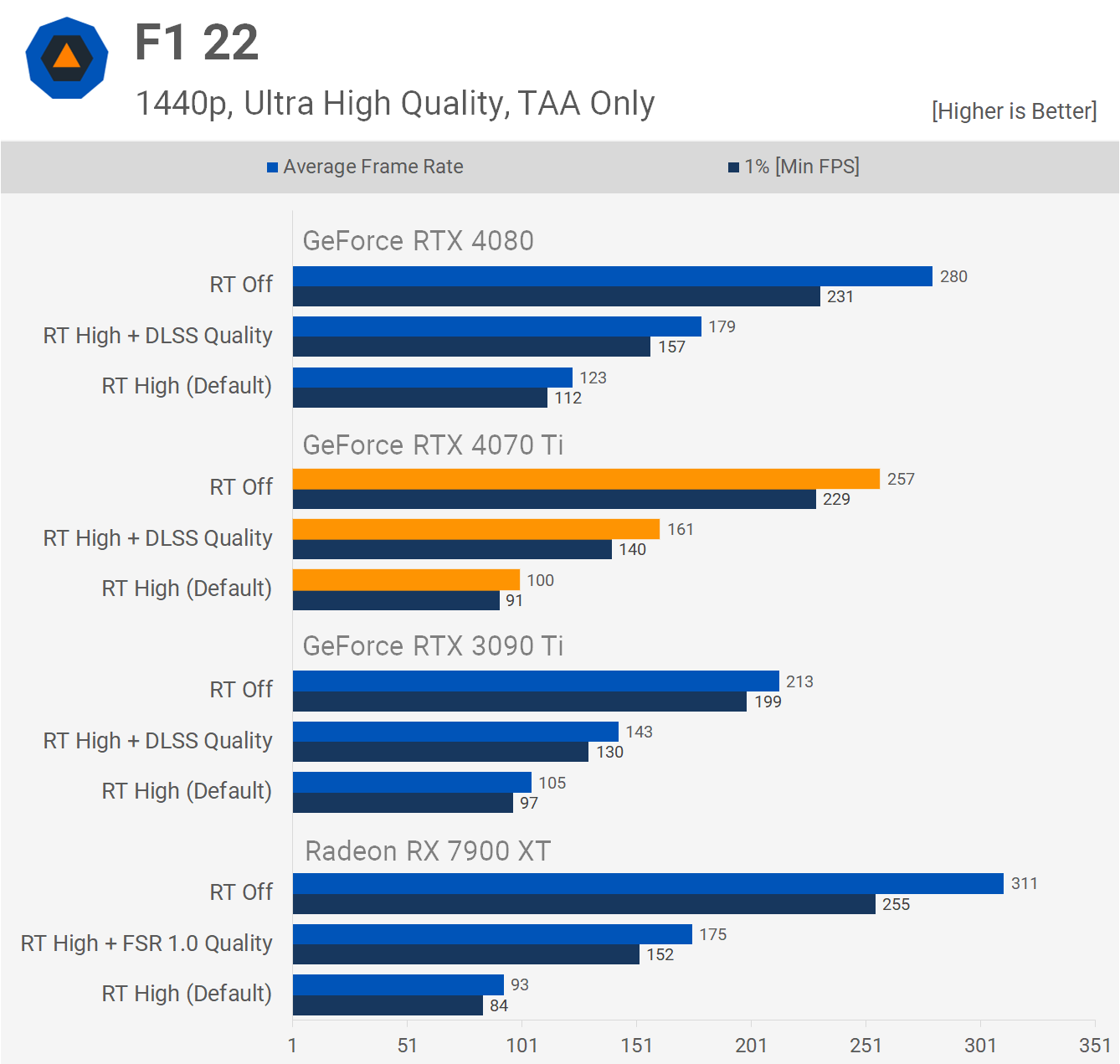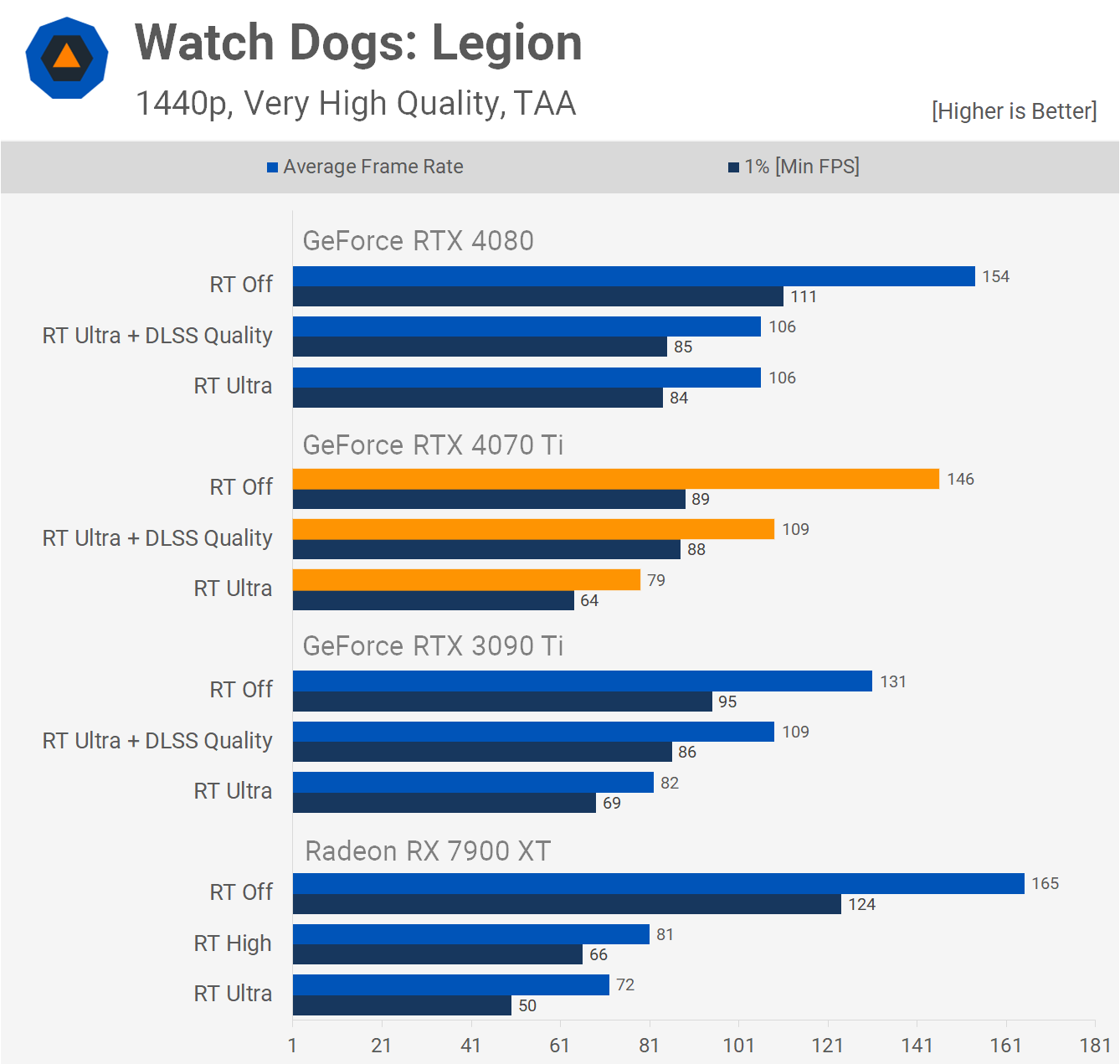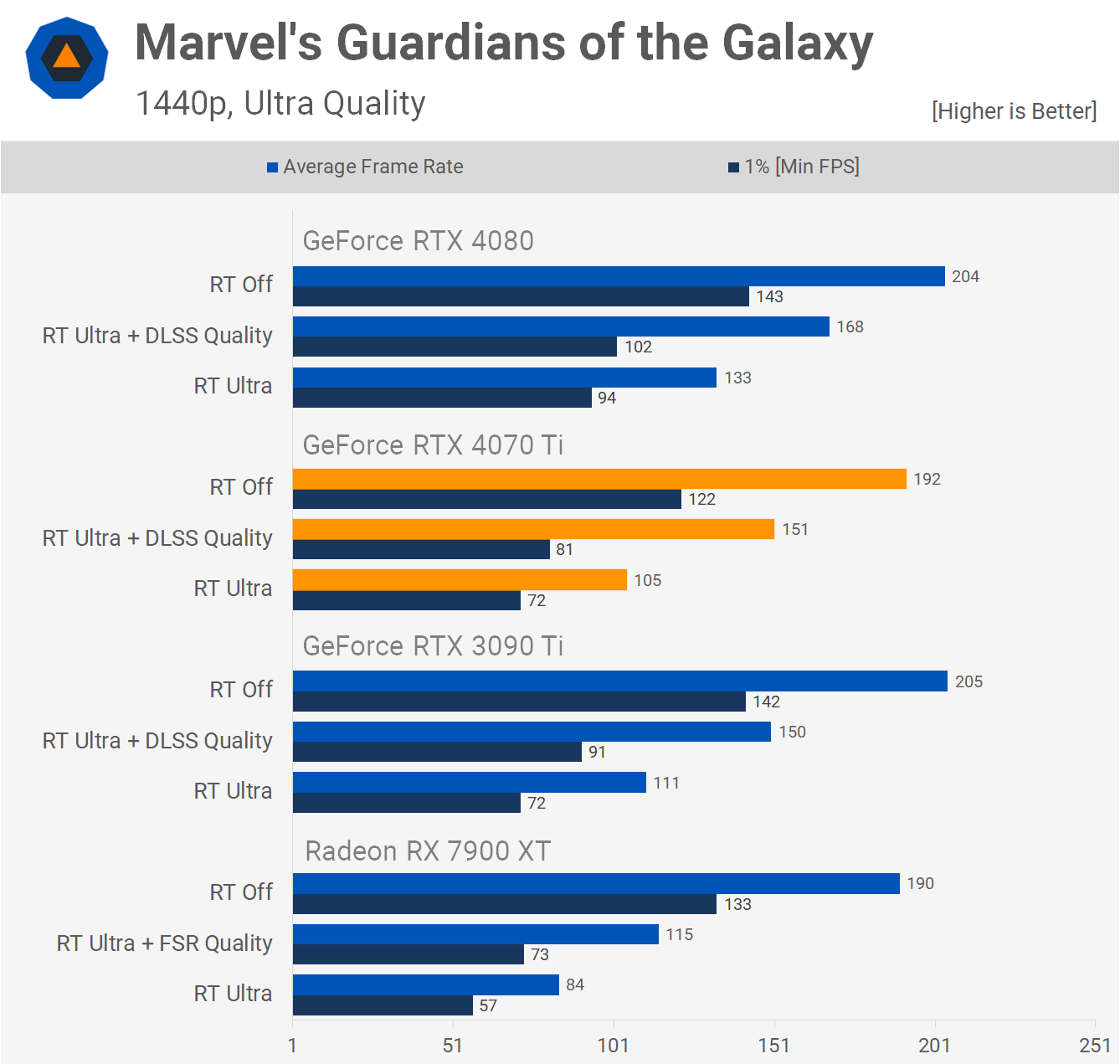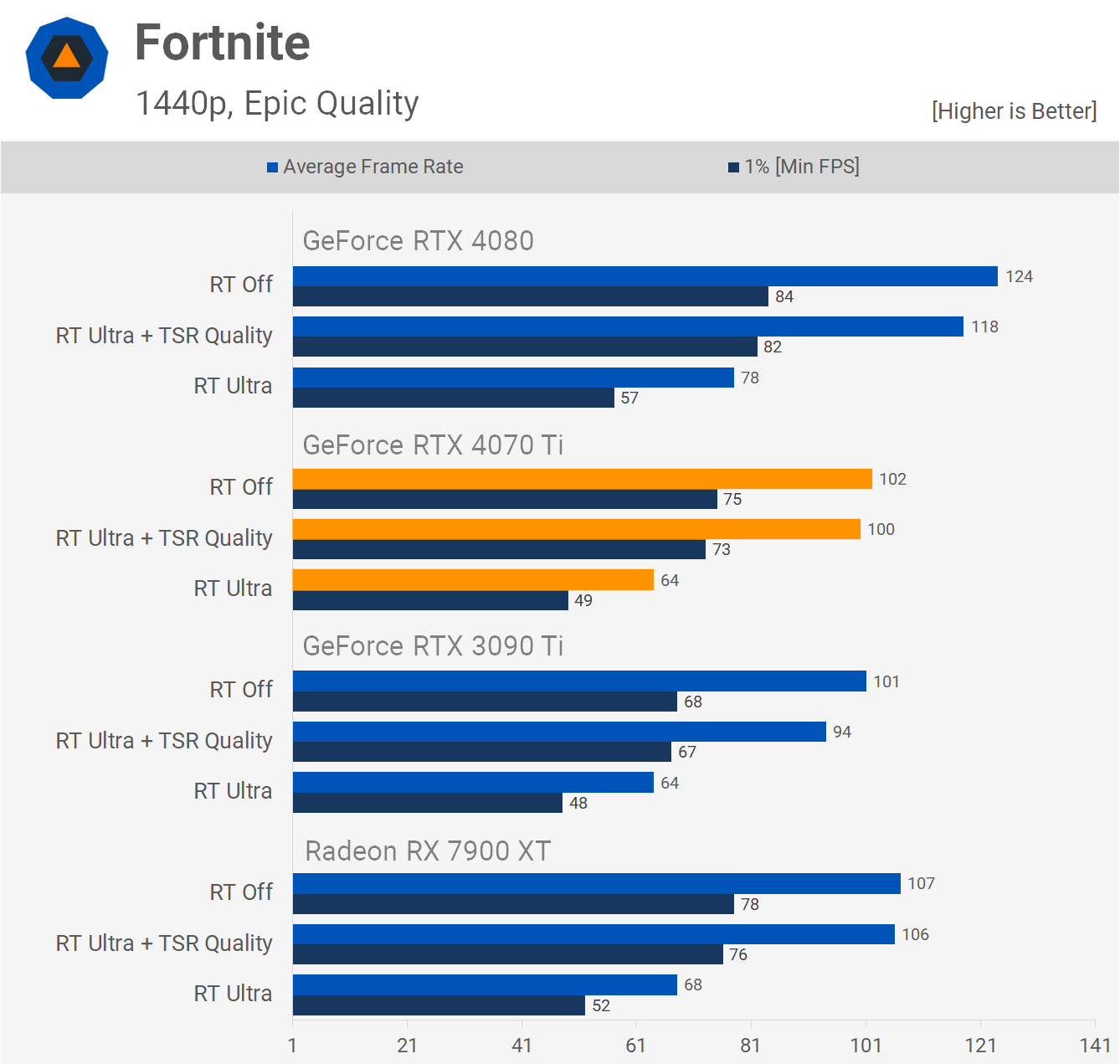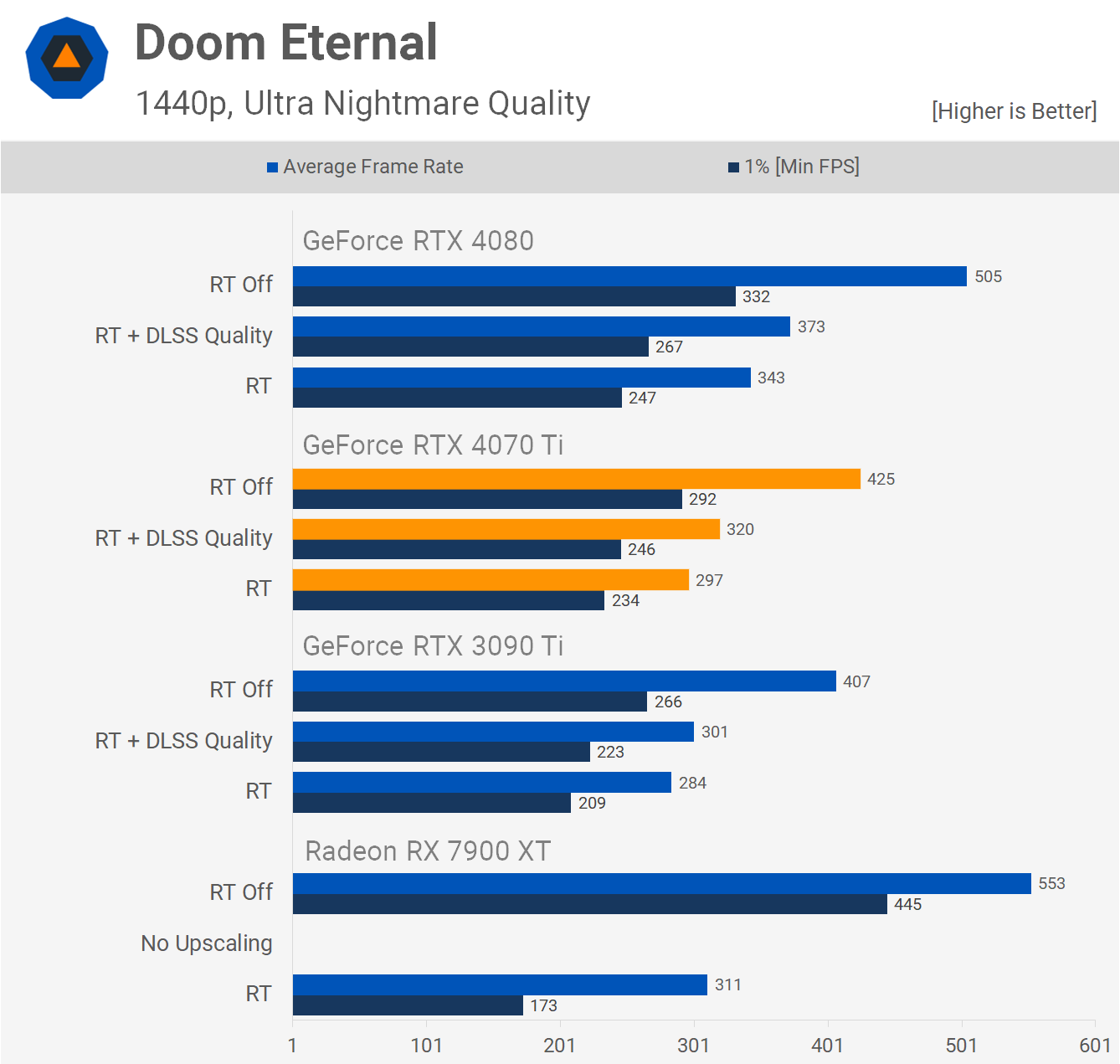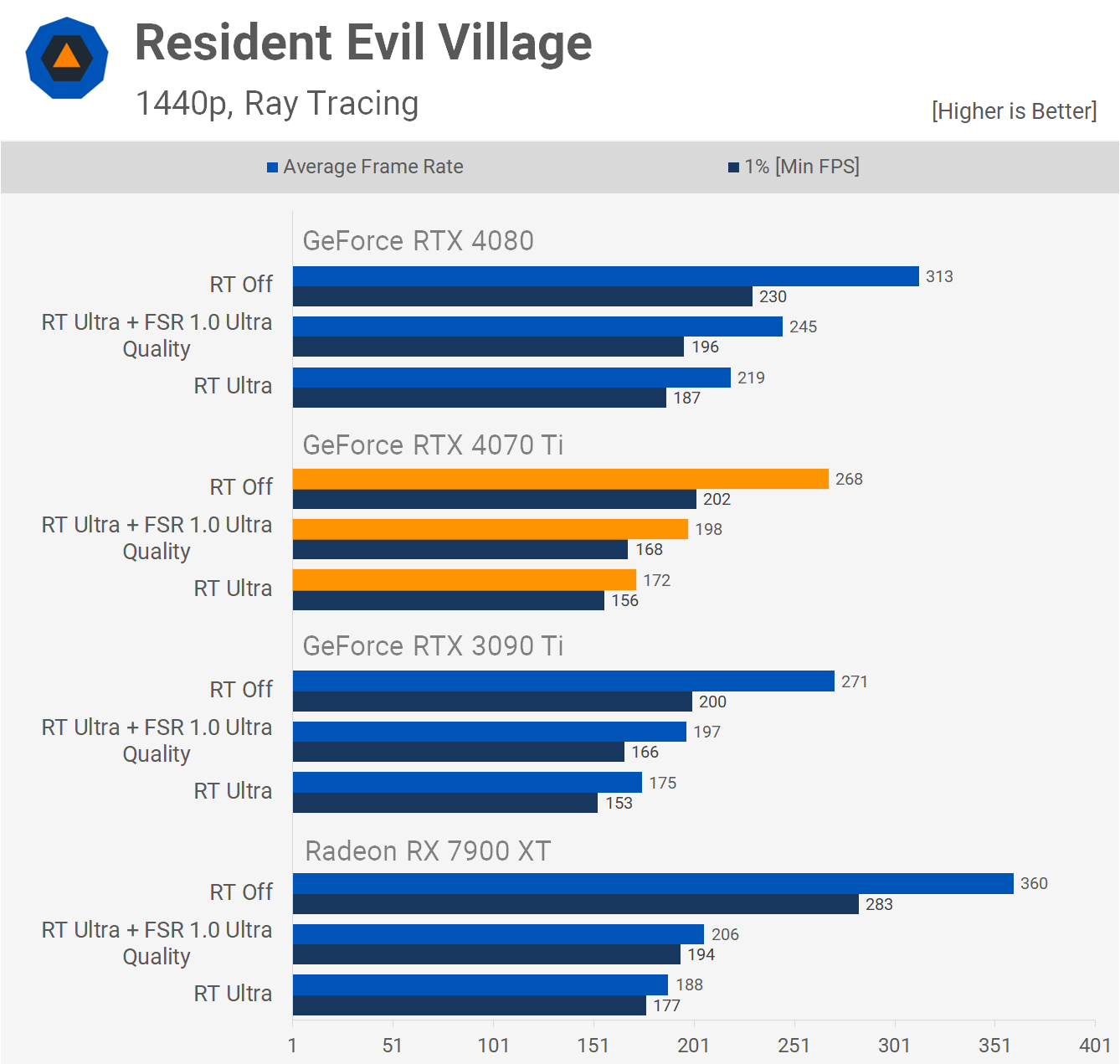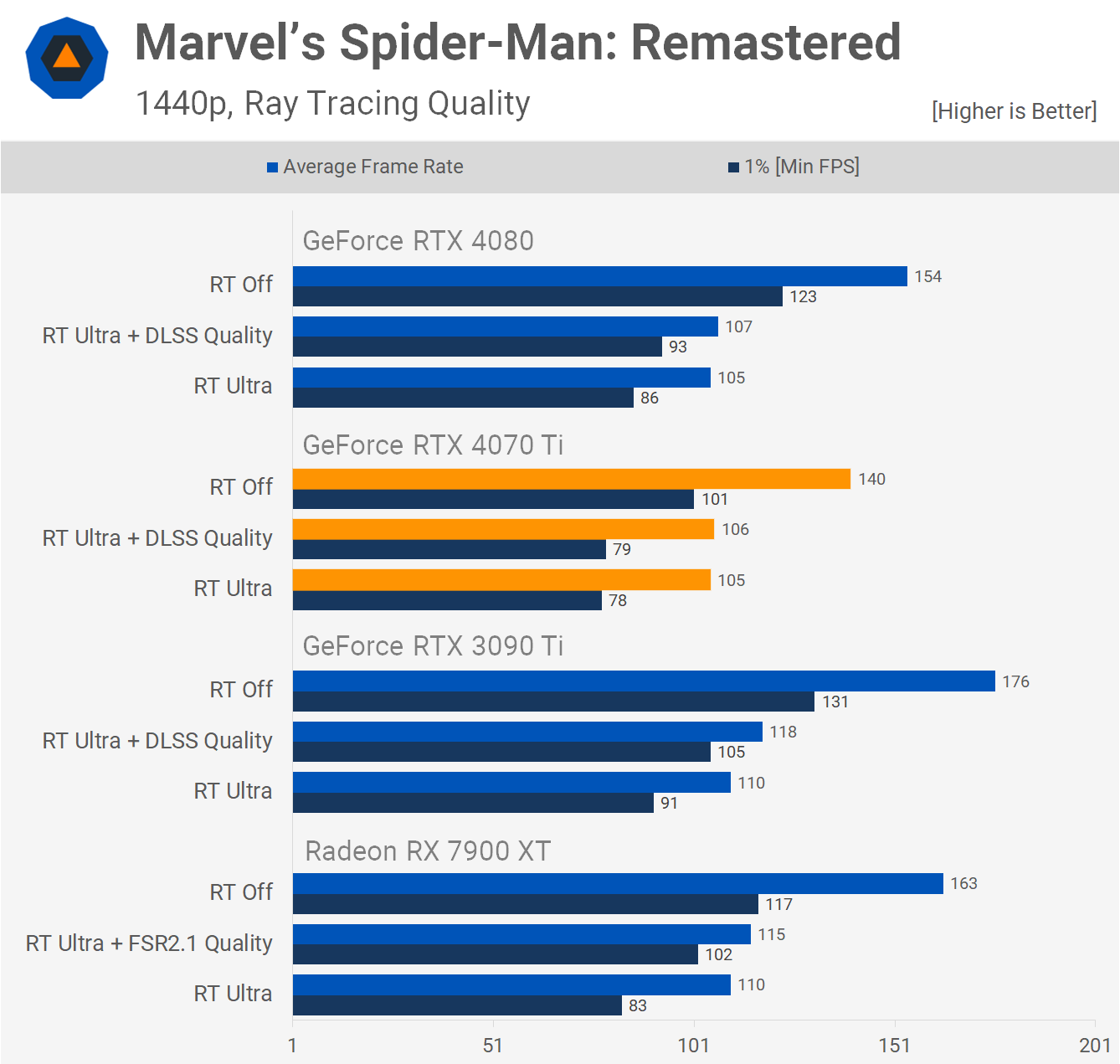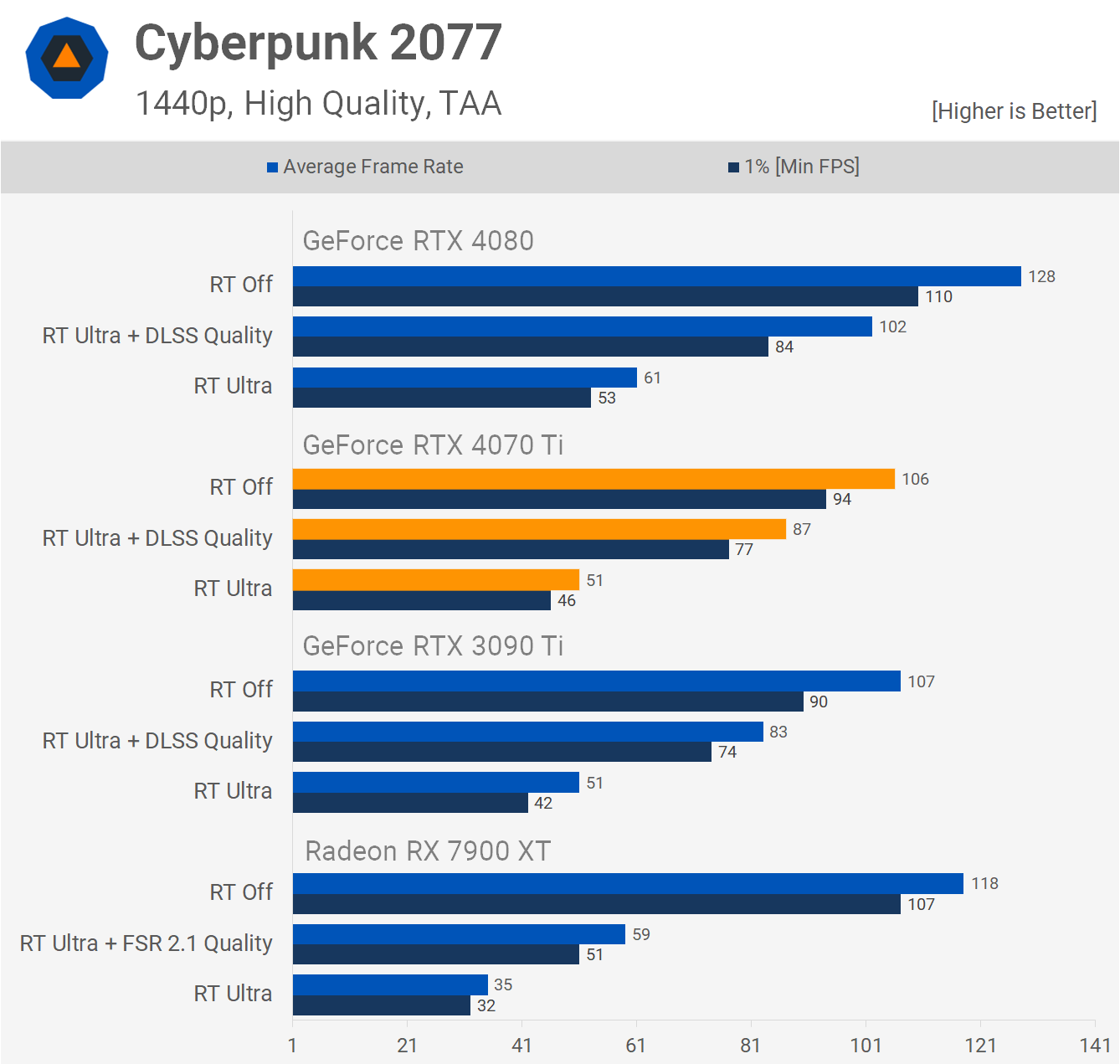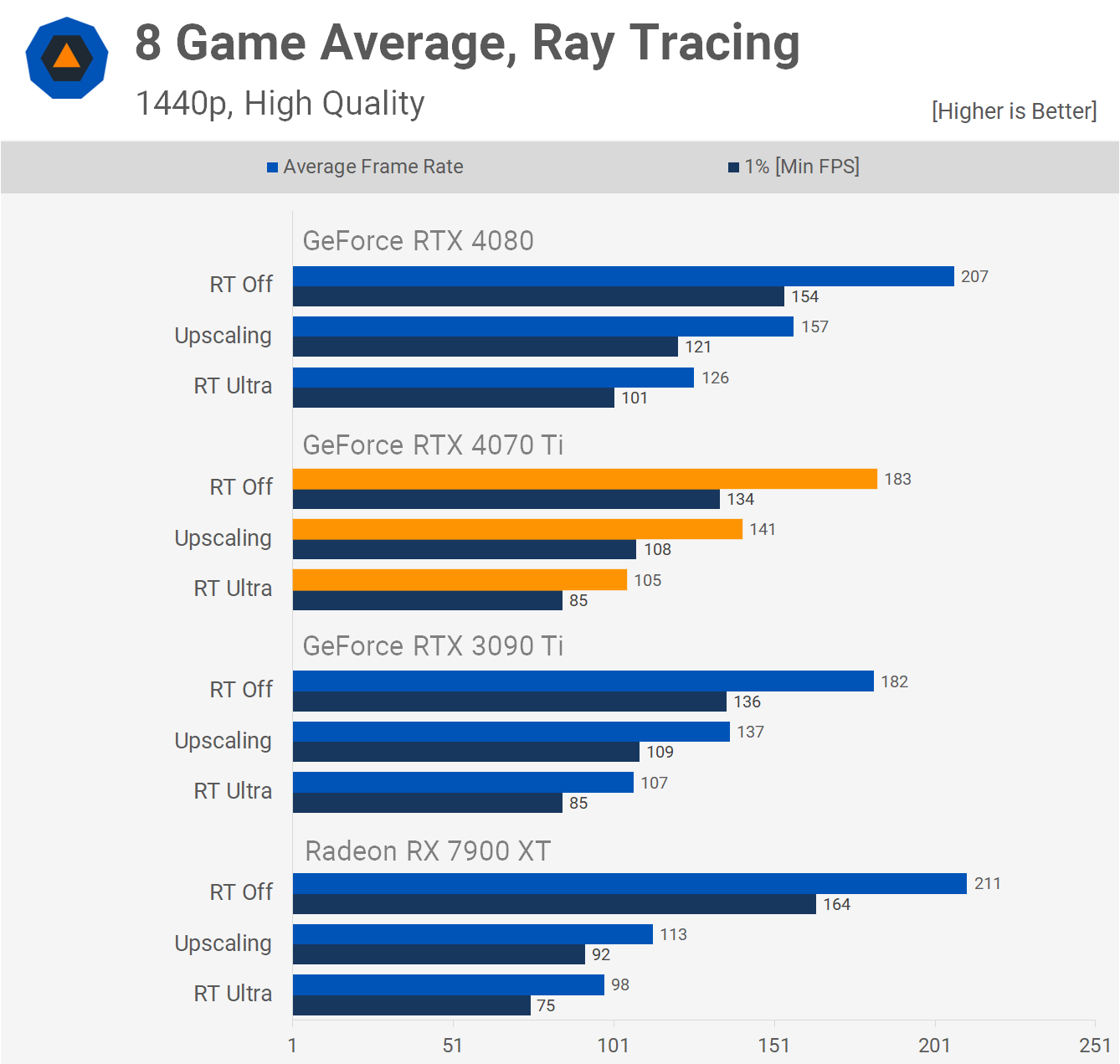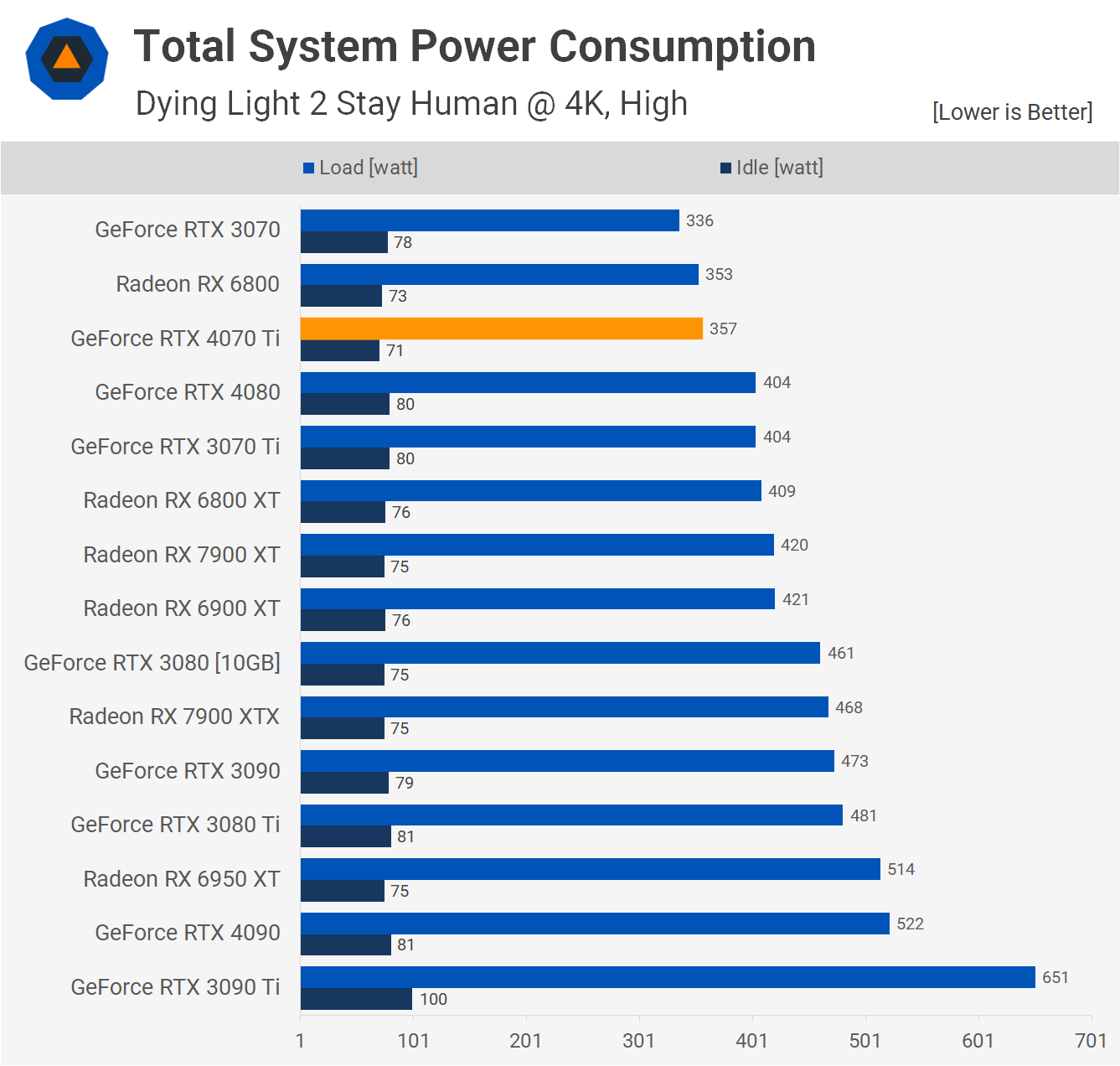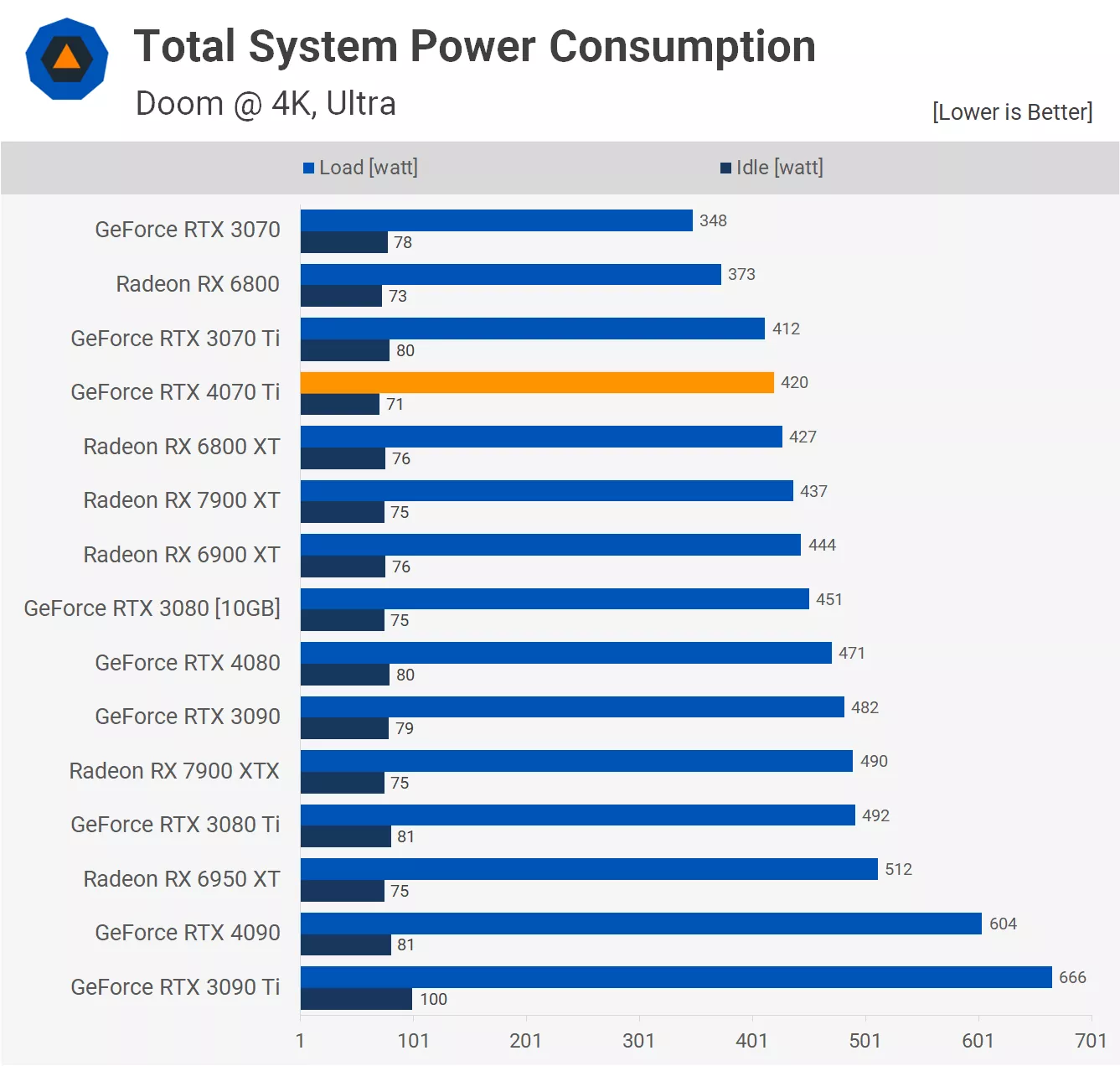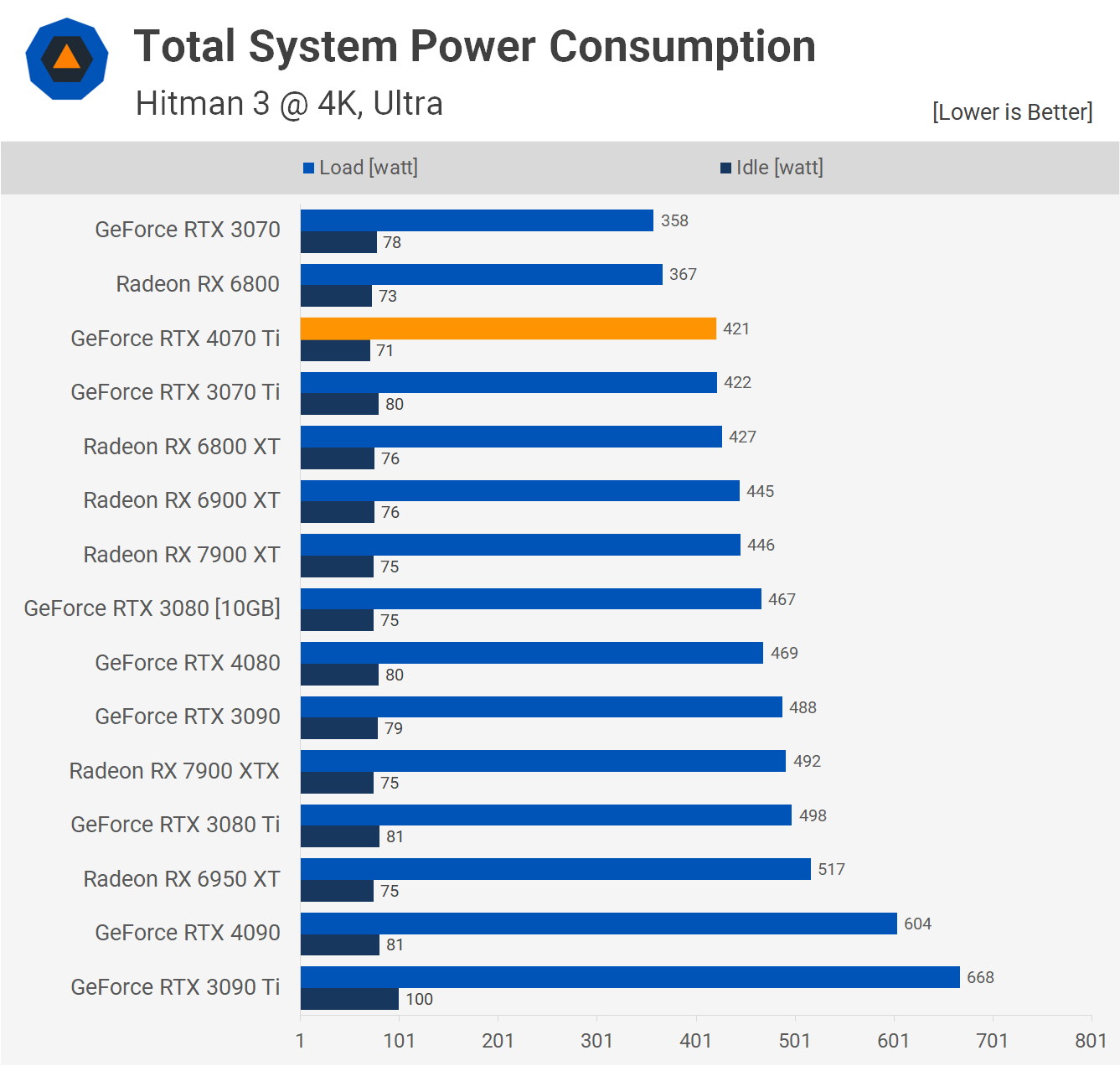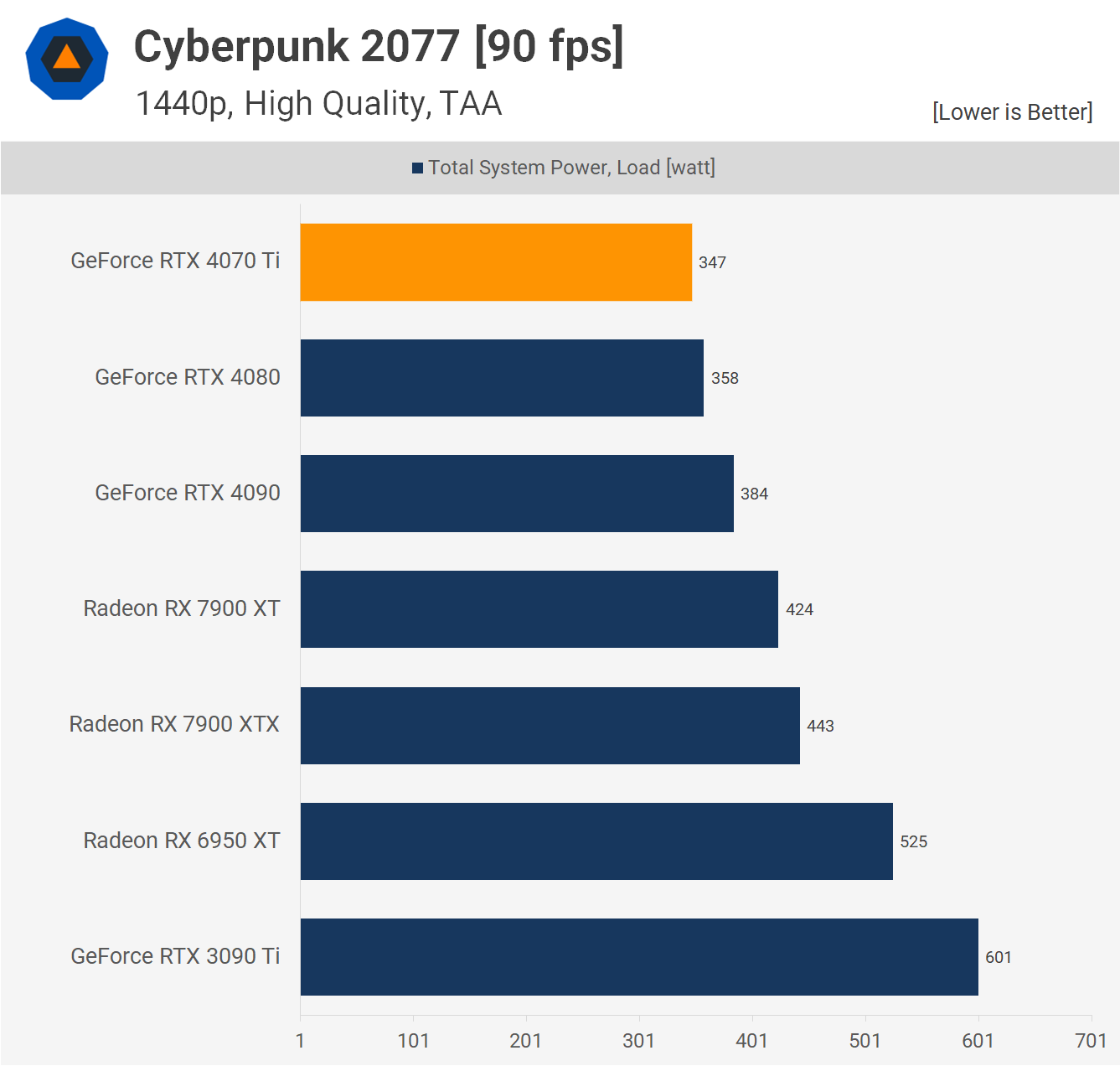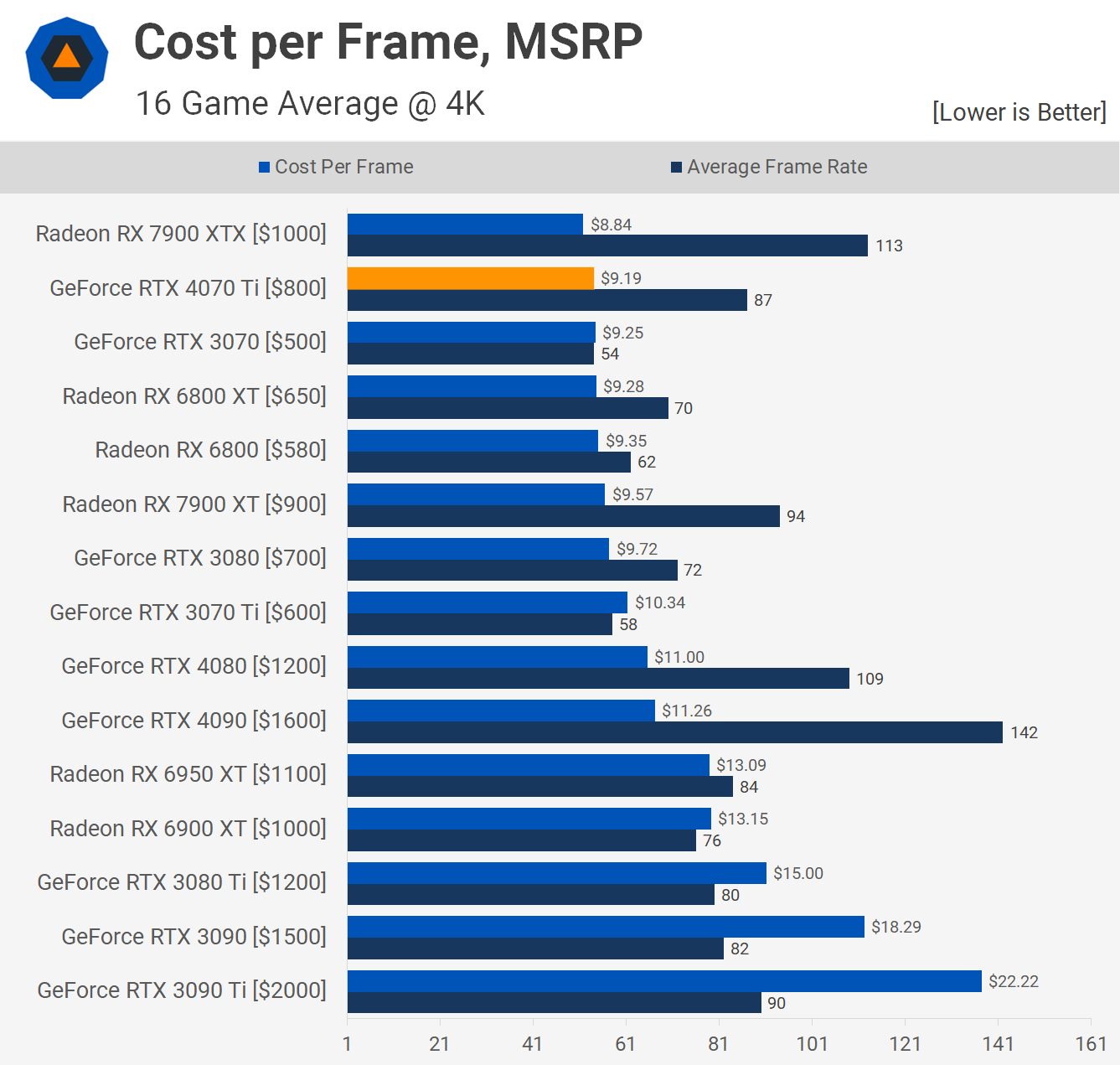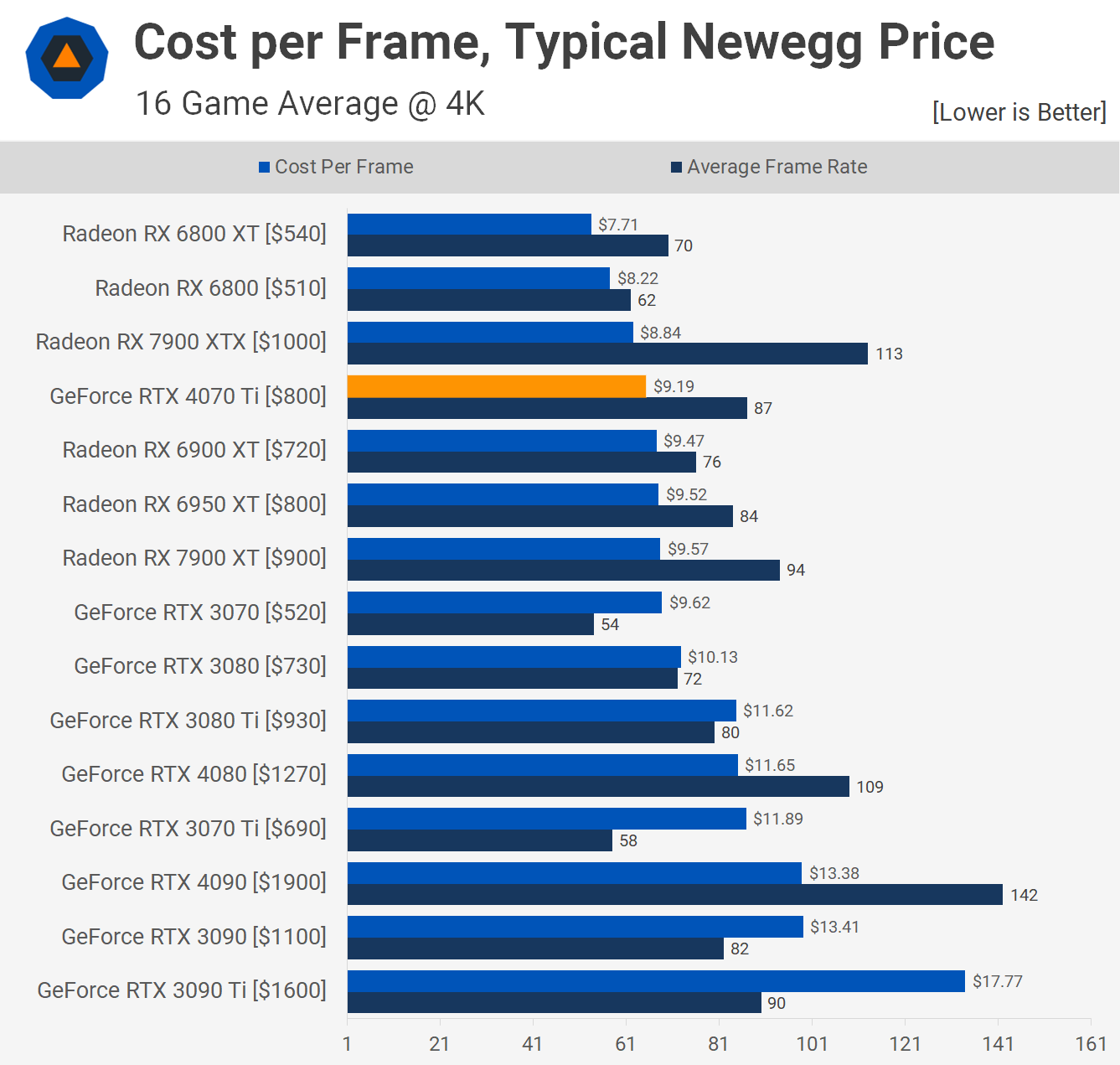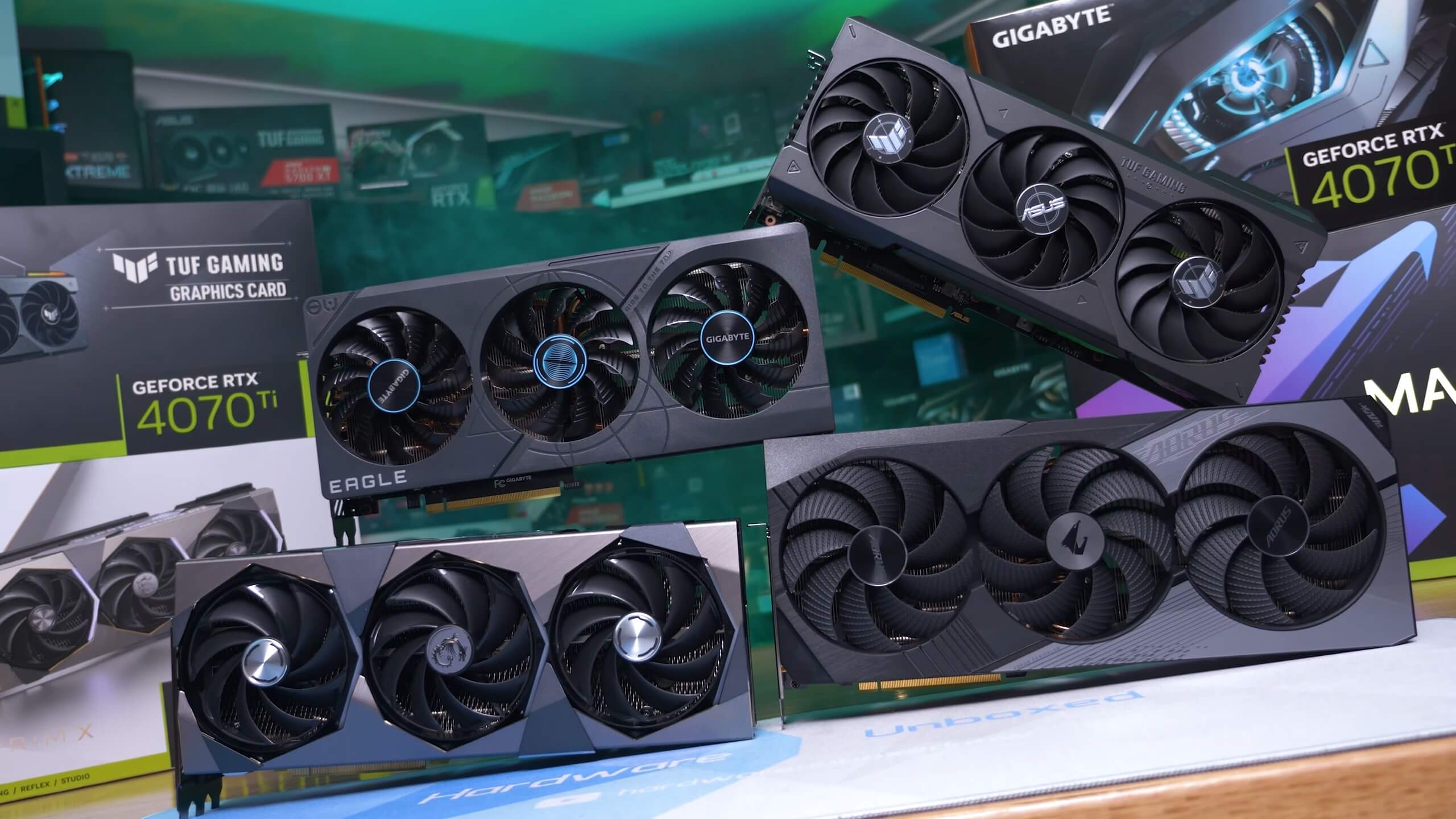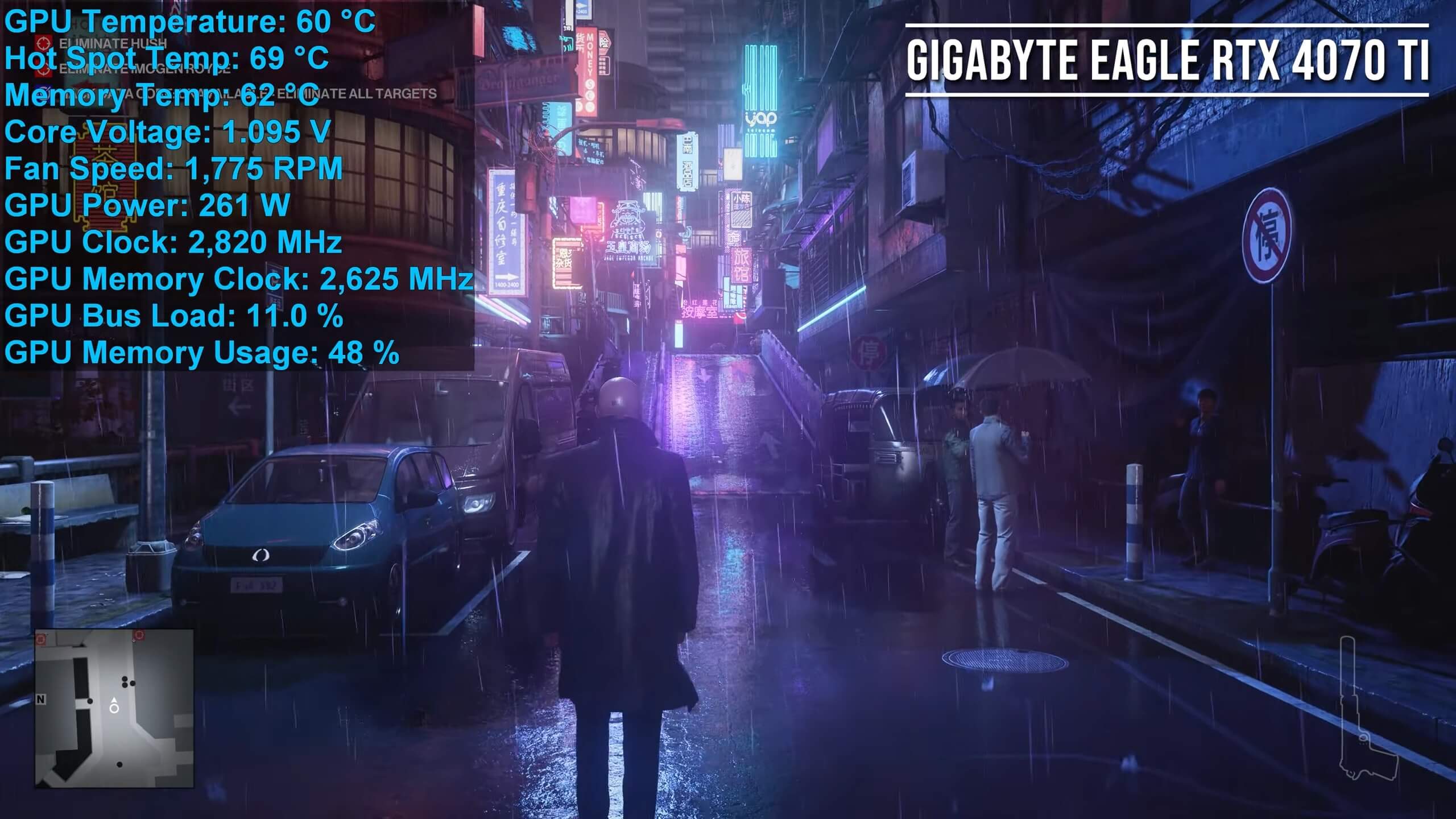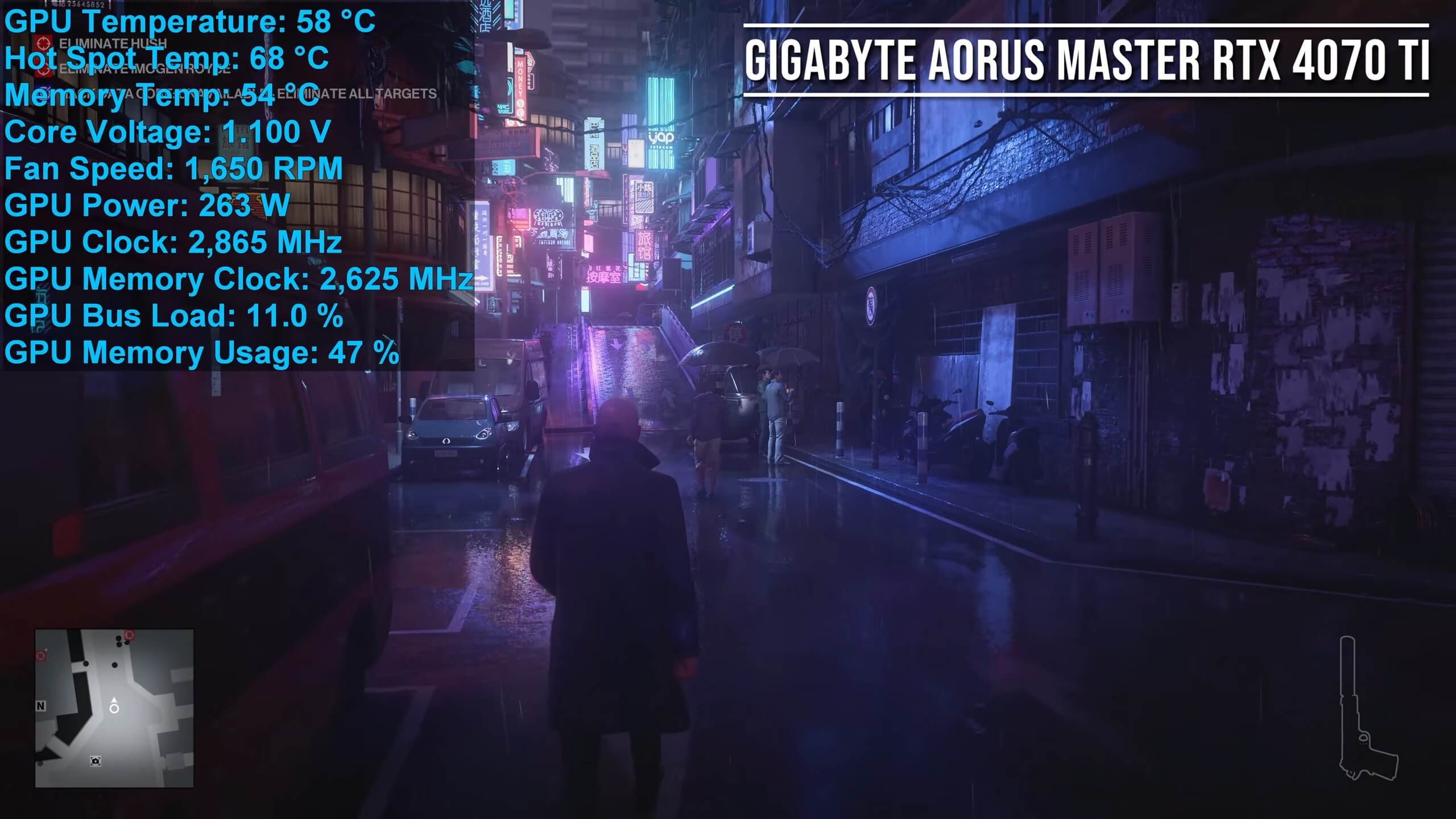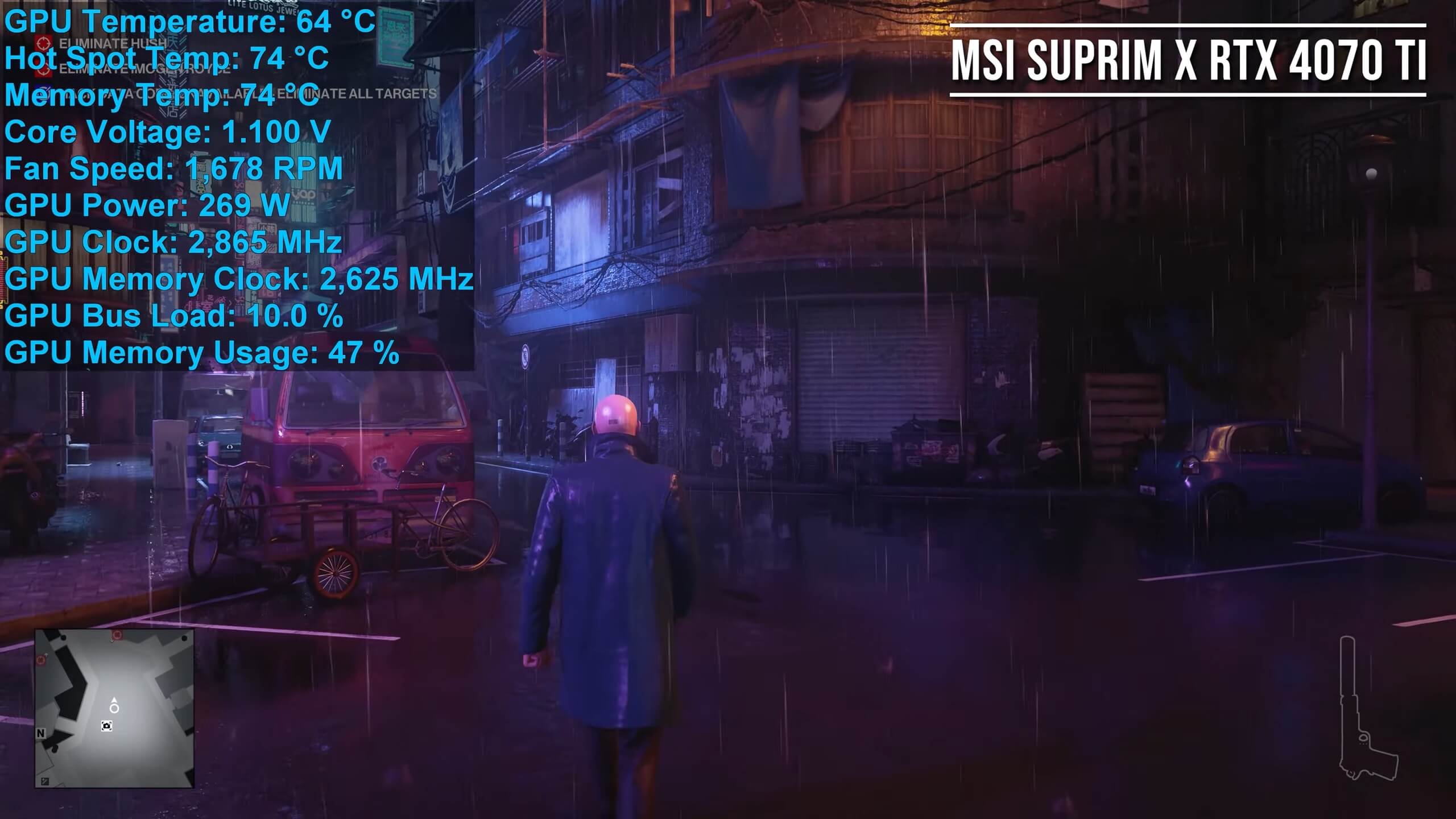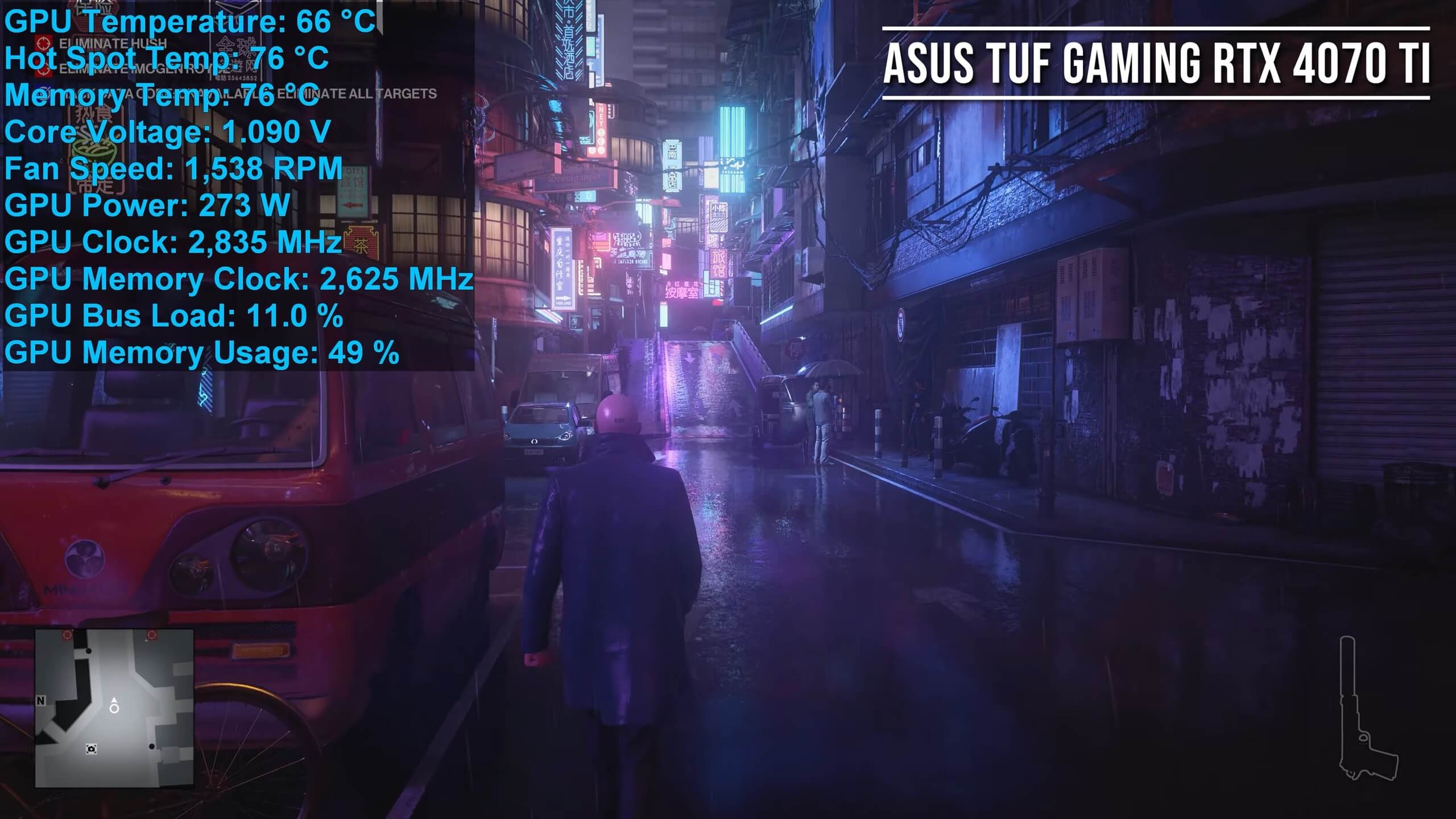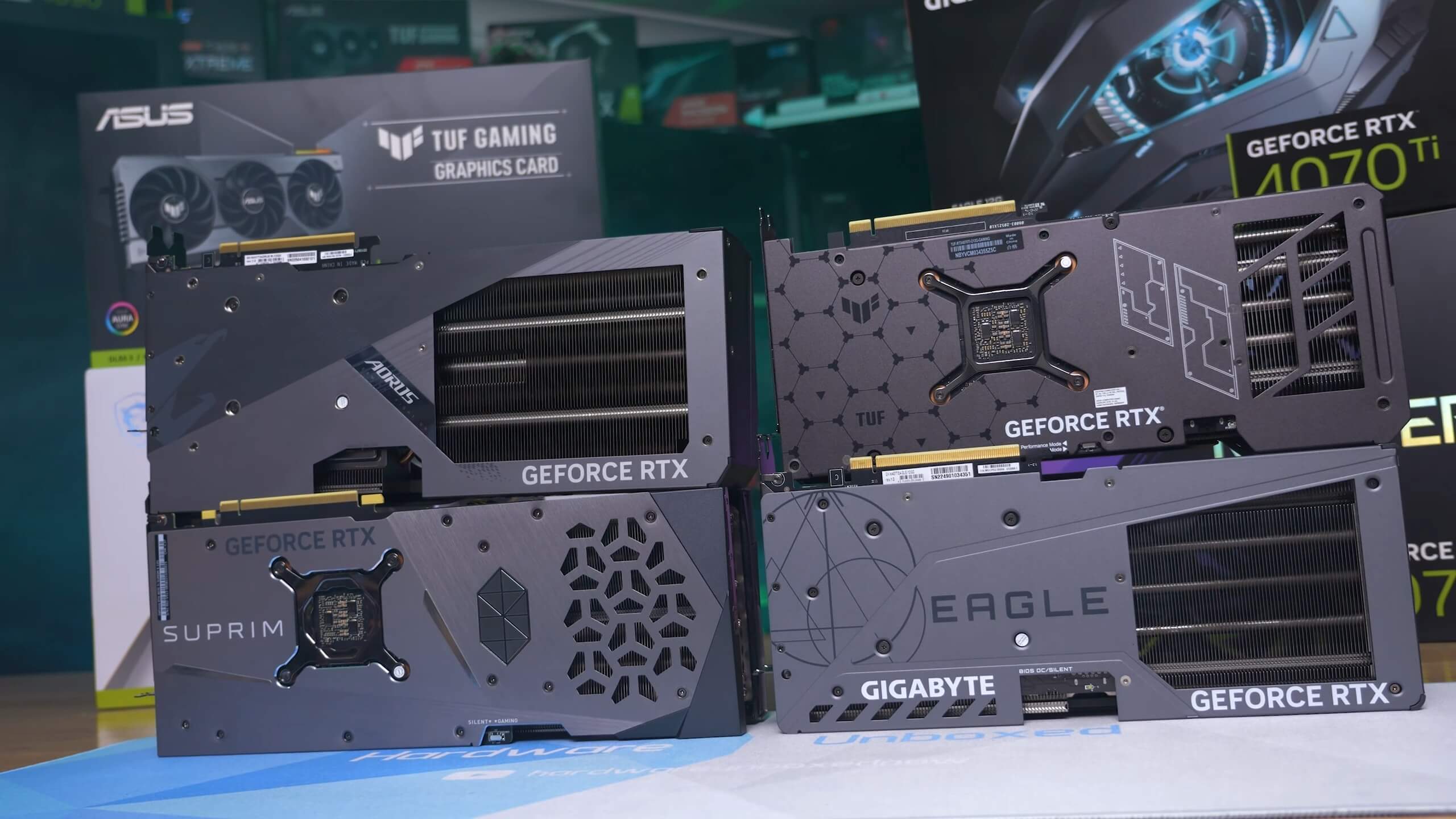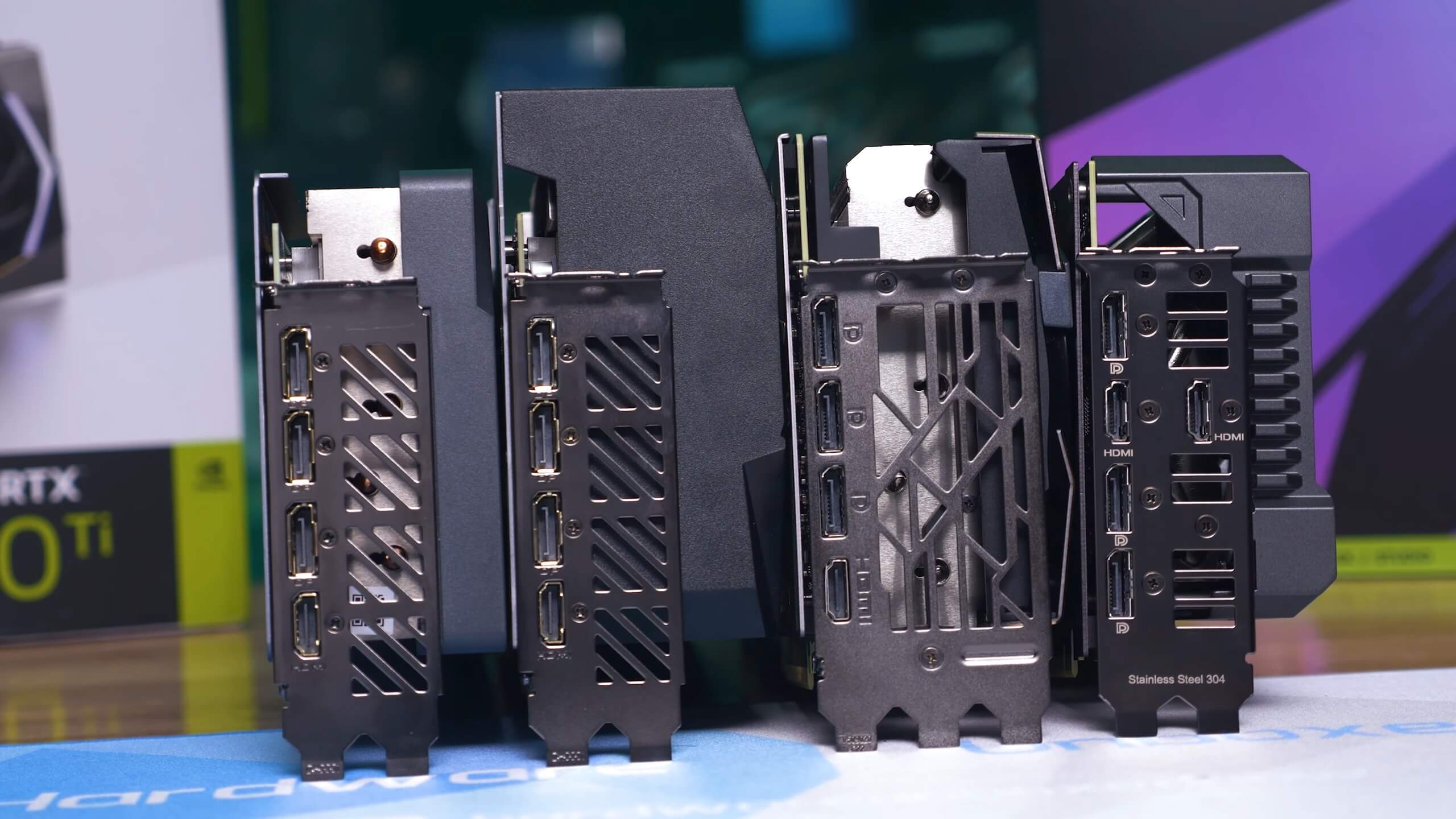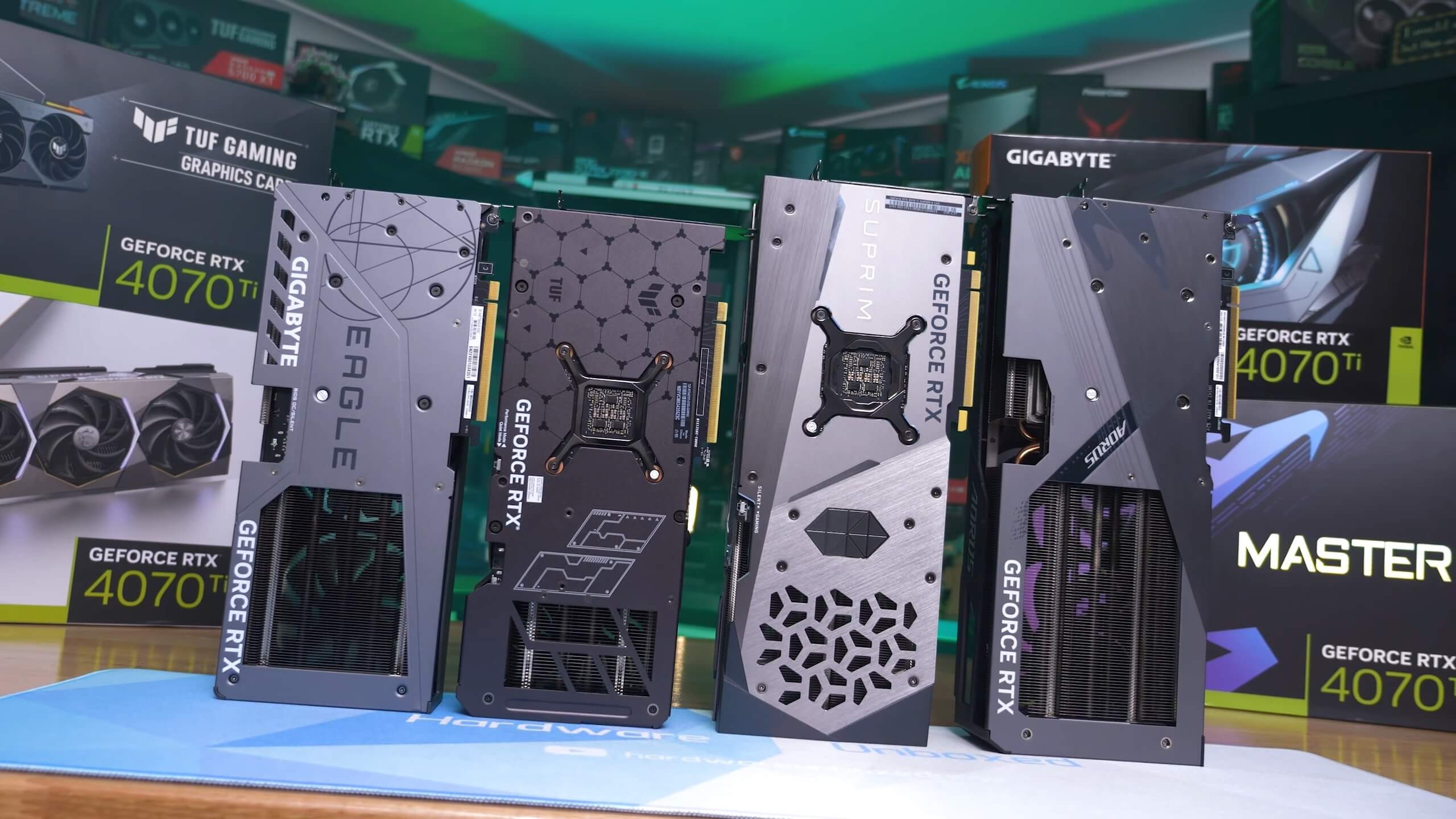The new Nvidia GeForce RTX 4070 Ti, formerly known as the 'unlaunched' 12GB RTX 4080, they are the exact same product in terms of specifications, but thankfully Nvidia hasn't simply changed the name and called it a day, we're also getting a $100 discount, dropping the price from $900 to $800.
When compared to the RTX 4080, the MSRP has been slashed by 33%, which is great news as that should make the RTX 4070 Ti the best value GeForce 40 series product release so far. Based on the AD104 silicon, there's 7680 CUDA cores, just 21% fewer cores than the 4080, but they are clocked 4% higher. Then we see a 25% reduction to the L2 cache capacity and a 25% reduction in VRAM with slightly slower 21Gbps memory used, and a 192-bit wide memory bus that has cut bandwidth by 30% down to 504 GB/s.
We're also looking at a modest 11% reduction in total board power with a rating of 285 watts. Other than that Nvidia's still using the TSMC 4N process and supports the PCIe 4.0 x16 interface.
| GeForce RTX 4090 | GeForce RTX 4080 | GeForce RTX 4070 Ti | GeForce RTX 3090 Ti | GeForce RTX 3080 Ti | |
|---|---|---|---|---|---|
| Price [$US MSRP] |
$1,600 | $1,200 | $800 | $2,000 | $1,200 |
| Release Date | October 12, 2022 | November 16, 2022 | January 5, 2023 | March 29, 2022 | June 3, 2021 |
| Codename | AD102 | AD103 | AD104 | GA102 | |
| Process | TSMC 4N | Samsung 8LPP | |||
| Cores | 16384 / 512 / 176 | 9728 / 304 / 112 | 7680 / 240 / 80 | 10752 / 336 / 112 | 10240 / 320 / 112 |
| GPU Boost Clock | 2520 MHz | 2505 MHz | 2610 MHz | 1860 MHz | 1665 MHz |
| Memory Capacity / Type | 24GB / GDDR6X | 16GB / GDDR6X | 12GB / GDDR6X | 24GB / GDDR6X | 12GB / GDDR6X |
| Memory Speed | 21 Gbps | 22.4 Gbps | 21 Gbps | 21 Gbps | 19 Gbps |
| Bus Type / Bandwidth | 384-bit / 1008 GB/s | 256-bit / 717 GB/s | 192-bit / 504 GB/s | 384-bit / 1008 GB/s | 384-bit / 912 GB/s |
| Total Board Power | 450 watts | 320 watts | 285 watts | 450 watts | 350 watts |
There is no Founders Edition model for the 4070 Ti, instead Nvidia is letting their partners handle the board designs and on hand for testing we have a number of graphics cards from Gigabyte, MSI and Asus, which we'll look at later on. For now, let's go straight to our test system specs and jump into the blue bar graphs.
For testing we powered our system using the Ryzen 7 5800X3D with 32GB of dual-rank, dual-channel DDR4-3200 CL14 memory on the MSI MPG X570S Carbon Max Wi-Fi motherboard. In total we've tested 16 games at 1440p and 4K, so let's get into the data...
Benchmarks
Starting with Watch Dogs: Legion results, we see that the RTX 4070 Ti is comparable to the 6950 XT with 146 fps on average at 1440p. That's certainly not a bad result as it does make it 11% faster than the RTX 3090 Ti and just 5% slower than the RTX 4080, though we are CPU limited here.
Moving to 4K sees the RTX 4070 Ti trailing the 7900 XT by 12% for what's once again 6950 XT-like performance, and RTX 3090 Ti-like as well. Perhaps more importantly, it was just 19% slower than the RTX 4080 which is nice given it's 33% more affordable.
Moving on to The Callisto Protocol, here the RTX 4070 Ti pumped out 122 fps which did make it quite a bit slower than the 7900 XT, 17% slower at 1440p. We should also note that this game enables FSR2 by default with the ultra quality preset, so that's why it's enabled here, this isn't something we've manually changed.
Moving to 4K sees the 4070 Ti delivering 6900 XT class performance, making it just 8% slower than the 6800 XT, which is a bit rough given that GPU can be had for under $600 right now.
It was also interesting to see the RTX 4070 Ti trailing the 4080 by a 30% margin, so these test conditions were not at all favorable for Nvidia's new "$800" GPU.
Next we have Forza Horizon 5 and here the 4070 Ti performed exceptionally well at 1440p, trailing the 4080 by a mere 4% margin to come in ahead of the 7900 XT by a 13% margin. This also made it 25% faster than Nvidia's previous generation flagship the RTX 3090 Ti, so that's a great result.
Performance at 4K became more competitive with the 7900 XT closing in, but even so the 4070 Ti was still 6% faster with 104 fps and just 11% slower than the RTX 4080.
Rainbow Six Extraction has some competitive results for us with the Radeon 7900 XT and RTX 4070 Ti delivering almost identical results.
We'd say this is a good result for the 4070 Ti as it not only matched its Radeon competition, but it also beat the previous generation's flagship by a 5% margin, and was just 19% slower than the 4080.
The 3090 Ti did nudge ahead at the 4K resolution, but even so the 4070 Ti still matched the 7900 XT and even at 23% slower than the 4080, that's a good result.
The Far Cry 6 performance isn't amazing, at least at 1440p, here we're looking at 3090-like performance, so a little slower than the 3090 Ti. Still we are quite heavily CPU-limited here, so these results aren't terribly useful for high-end GPUs.
Jumping up to 4K shows just how system limited the 1440p data was.
The RTX 4070 Ti is still demonstrating 3090 / 3090 Ti levels of performance making it 20% slower than the Radeon 7900 XT and RTX 4080.
The Assassin's Creed Valhalla results are more of the same, at 1440p we're faced with previous-gen flagship performance, just 2% slower than the 6950 XT and 5% faster than the 3090 Ti.
Although it was just 12% slower than the RTX 4080, it was also 13% slower than the 7900 XT.
Even at the 4K resolution the RTX 4070 Ti trailed the 7900 XT by an 11% margin with 85 fps opposed to 96 fps. Still that meant it was just 15% slower than the RTX 4080 thanks to 3090 Ti-like performance.
The 4070 Ti spat out 193 fps at 1440p in Hunt: Showdown, which surprise, surprise meant it was delivering previous generation flagship performance.
It was also just 7% slower than the 7900 XT – pretty good given it's 11% cheaper at MSRP.
We're looking at similar margins at the 4K resolution, here it was 8% slower than the 7900 XT. Again we're looking at similar performance to the RTX 3090, and that meant it was 26% slower than the RTX 4080.
The Outer Worlds uses the Unreal Engine 4 and this tends to heavily favor Nvidia GPUs, so unsurprisingly the RTX 4070 Ti was able to nudge ahead of the 7900 XT with 167 fps on average, and that also placed it alongside the RTX 3090.
It's a similar story at 4K, where the RTX 4070 Ti was a mere 2% faster than the 7900 XT and just 2% slower than the RTX 3090, while it trailed the RTX 4080 by a 23% margin.
Unlike The Outer Worlds, Call of Duty: Modern Warfare II doesn't favor GeForce GPUs but quite the opposite. Here the Radeon 7900 XT is a massive 32% faster than the 4070 Ti at 1440p, despite the 4070 Ti being just 7% slower than the 4080.
Interestingly, even at 4K the RTX 4070 Ti is just 10% slower than the 4080, but also 21% slower than the 7900 XT. As you'd expect we're looking at previous generation flagship performance, so given the price, we'd say that's a decent result.
The Hitman 3 performance is similar between the Radeon 7900 XT and RTX 4070 Ti at 1440p, placing both just behind the 3090 Ti and just 11% slower than the RTX 4080 thanks to a CPU bottleneck.
The RTX 4070 Ti did fall behind the 7900 XT at 4K, trailing by a 12% margin with 122 fps on average, though that did also make it just 14% slower than the RTX 4080.
Horizon Zero Dawn is another title where the 7900 XT and 4070 Ti are neck and neck, at least at 1440p where both provided 3090 Ti and 6900 XT-like performance.
The 4K data is very similar, the RTX 4070 Ti and Radeon 7900 XT are comparable again, and provided similar performance to that of previous generation flagship parts.
Next we have F1 22 and this game has been tested with ray tracing enabled as that's the default setting when using the 'Ultra High' quality preset.
This hands the RTX 4070 Ti an advantage, beating the Radeon 7900 XT by 8% at 1440p to provide similar-to RTX 3090 performance.
The 4K results are close enough, 8% faster than the 7900 XT and just 5% slower than the 3090 Ti. It was also 19% slower than the RTX 4080, which is an overall excellent result given the price.
Cyberpunk 2077 hasn't been tested with RT enabled, though we will get to those results shortly.
For now we have the high preset enabled with upscaling features disabled. The 4070 Ti is able to match the 3090 Ti and 6950 XT, which in this case made it 10% slower than the 7900 XT.
Then at 4K the RTX 4070 Ti struggled a bit with just 49 fps on average and while that is comparable to older flagships, it was also 17% slower than the 7900 XT.
Moving on to Dying Light 2, we find fairly competitive results as here the 4070 Ti was just 5% slower than the 7900 XT.
Upping the resolution to 4K does see the RTX 4070 Ti fall well down our graph with 59 fps on average, just a few frames faster than the 6800 XT which is a disappointing result, despite being just 11% slower than the 7900 XT.
Halo Infinite results are interesting and as we've seen before this isn't a game that runs particularly well with AMD's RDNA 3 GPUs. The RTX 4070 Ti smoked the more expensive 7900 XT by an 18% margin at 1440p and was also a good bit faster than previous generation flagships.
The 4K data is very different though and we've seen this a few times where RDNA 3 appears to suffer some kind of driver optimization issue. Here the RTX 4070 Ti is a few percent faster than the 7900 XT which is a great result for Nvidia given they've undercut AMD on pricing for this matchup.
Last up we have Shadow of the Tomb Raider, an oldie but a goodie and here the 4070 Ti knocked off the 7900 XT by a 4% margin, so basically performance overall was identical at 1440p.
It's the same story at 4K, this time the 7900 XT nudged ahead, but overall performance was nearly identical, meaning both delivered previous-gen flagship performance.
Performance Summary: 16 Game Average
Starting with the 1440p data, here's our 16 game average. Based on everything we just saw, the GeForce RTX 4070 Ti is slightly slower than the 7900 XT on average, though it's just 4% slower which is very close for these two GPUs. We're also looking at a 5% boost on average over the 3090 Ti and 6950 XT, with a 13% increase over the 6900 XT and RTX 3090.
The 4070 Ti was also just 16% slower than the 4080 on average, though in a number of instances we were quite heavily CPU limited, so let's move on to check out the 4K results.
At 4K, the GeForce RTX 4070 Ti was 7% slower than the 7900 XT and 3% slower than the 3090 Ti, but also 4% faster than the 6950 XT. So in short, you get previous-gen flagship performance for $800, which in today's market doesn't seem all that bad.
It was also 20% slower than the GeForce RTX 4080, which given the price seems quite reasonable.
For those of you interested, we also tested at 1080p and here's that data when paired with the 5800X3D. The Radeon 7900 XT and GeForce RTX 4070 Ti are neck and neck, and just 8% slower than the RTX 4080 thanks to the more CPU-limited testing.
Ray Tracing Performance + DLSS
We have some additional ray tracing benchmarks and we'll start with F1 22 which we've already tested with RT effects enabled, but here's a look at how the 4070 Ti and 7900 XT compare with and without RT enabled, along with FSR and DLSS upscaling.
In short, the RTX 4070 Ti is 8% faster than the 7900 XT with ray tracing enabled, but 17% slower with it disabled.
As seen previously when testing with Watch Dogs: Legion, with ray tracing disabled the RTX 4070 Ti is 12% slower than the 7900 XT. However, with ultra RT enabled the 4070 Ti is 10% faster and GeForce GPU was handed the win.
The 4070 Ti and 7900 XT were neck and neck in Marvel's Guardians of the Galaxy using the ultra quality preset at 1440p without ray tracing enabled, both with around 190 fps. However with RT enabled the 4070 Ti was 25% faster, rendering an impressive 105 fps on average.
The Fortnite results are interesting because here we're no longer using the RTX implementation but rather Unreal Engine 5.1, which is software-based ray tracing. In our opinion, Nanite and Lumen are the most impressive rendering technologies we've seen implemented in a video game for a very long time and the RT effects on display are easily some of the best, if not the best, in Fortnite, we know.
What's amazing is how well optimized Nanite and Lumen are for GeForce and Radeon GPUs, with the 7900 XT actually outperforming the 3090 Ti and 4070 Ti by a slim margin. It's quite possible that more games built on Unreal Engine 5 will bring change to AMD's "poor" ray tracing performance problem and that will become a thing of the past.
Doom Eternal is an RTX title, so no upscaling for Radeon GPUs here but despite that the game plays at extremely high frame rates at native 1440p and here the 4070 Ti was again slightly slower than the 7900 XT with ray tracing enabled. Still with around 300 fps, basically maxed out at 1440p, the margins are irrelevant.
Resident Evil Village is not an RTX title, so no DLSS support and just FSR, though sadly the FSR support hasn't been updated from the initial release. Anyway, the game does support ray tracing and while far from a game changer and significantly less impressive than what we see in Fortnite for example, it still does enhance the visual look of the game.
As you'd expect the performance boat is quite large, especially for the 7900 XT, but with RT enabled all GPUs shown here pushed well above what's required to enjoy this game.
The 4070 Ti for example pumped out 172 fps, and although that made it 9% slower than the 7900 XT when using ray tracing, the performance overall was more than sufficient and would allow gamers to push up to 4K if they desired.
Marvel's Spider-Man Remastered brought on some odd results, which we believe are caused by the use of the Ryzen 7 5800X3D processor. The GeForce 40 series GPUs were limited to just over 100 fps with ray tracing enabled, the 1% lows of the 4080 are higher than that of the 4070 Ti, but both are clearly artificially limited. This is most obvious when looking at the 3090 Ti which was faster than even the RTX 4080, and this wasn't just the case with RT enabled, even with RT disabled the 3090 Ti was still 14% faster than the 3090 Ti.
We removed Spider-Man Remastered from our day-one RTX 4090 review, noting a strange driver bug that limited performance to around 100 fps, but this now seems like less of a bug and just an overhead issue with the 40 series. Whatever the case these results are accurate with the 5800X3D. That means without RT enabled the 7900 XT is 16% faster than the 4070 Ti and with it enabled performance is much the same.
The Cyberpunk 2077 ray tracing performance even with the high quality preset is brutal and even the 4070 Ti requires upscaling as it produced 51 fps. Still, that made it 46% faster than the 7900 XT which managed just 35 fps and even with FSR 2.1 versus DLSS for the 4070 Ti, the GeForce GPU was still 47% faster. An easy win here for Nvidia.
Finally, here's a look at the average ray tracing performance seen across the 8 games we just looked at but please note the upscaling results are not apples to apples and in some games the Radeon GPUs didn't even receive upscaling support.
What's interesting to note is that the Radeon 7900 XT saw a 54% decline in performance with ray tracing enabled, while the RTX 4070 Ti only saw a 43% decline, yet overall the RT performance was around the same. The RTX 4070 Ti was on average 7% faster with RT, but 13% slower without RT enabled.
If we were to ignore the RTX titles where Radeon GPUs get decimated, and decimated by design we should add, the ray tracing performance of the 7900 XT actually looks very good – think titles like Fortnite. That makes us think that moving forward the RT battle is going to be a lot less one sided.
Power Consumption
Ada Lovelace is very efficient and we're seeing yet another example of this with the RTX 4070 Ti.
Testing in Dying Light 2 shows the 4070 Ti pushing total system consumption to just 357 watts, a 15% power saving when compared to the 7900 XT. Moreover, the RTX 4070 Ti was comparable to the RX 6800 and RTX 3070, an impressive result given the performance.
The Doom results are intriguing as here the 7900 XT and 4070 Ti are much similar when comparing total system usage, both pushing over 400 watts which is still very reasonable.
We're also looking at similar power usage in Hitman 3. The Radeon 7900 XT pushed total system usage just 6% higher, and was just 2% slower. So the RTX 4070 Ti was certainly the more efficient GPU, but in this example they're very close.
With the frame rate locked to 90 fps, we see that the RTX 4070 Ti is the most efficient of current generation GPUs released thus far, pushing total system usage to just 347 watts, 3% less than the GeForce RTX 4080 and 18% less than the Radeon 7900 XT.
Cost per Frame
For those of you wanting to maximize your return per dollar spent, here come the all important cost per frame analysis, we'll start with MSRP data.
If all current and previous generation GPUs were to be sold at the suggested retail price, the RTX 4070 Ti would represent fairly good value. It's certainly not amazing, roughly matching the RTX 3070 and 6800 XT which are sensible options in previous generations, but that's not exactly a bad result...
When compared to its most direct competitor, the 7900 XT, the 4070 Ti costs around 4% less per frame while offering superior ray tracing performance and DLSS support. So a clear win here for Nvidia no matter which way you slice it.
Now when factoring in current retail pricing the RTX 4070 Ti still stacks up reasonably well, despite costing 4% more per frame than the 7900 XTX, though it is 4% cheaper than the 7900 XT.
Assuming you can buy a RTX 4070 Ti for $800 – which in the short term is more of a stretch than a given – but assuming you can, it would be a massive 21% discount per frame from the current RTX 4080 asking price.
Even at the MSRP, the RTX 4070 Ti's cost per frame represents 16% better value than the RTX 4080, so Nvidia has truly corrected pricing here which is great.
A Variety of RTX 4070 Ti Models & Cooling Performance
We based all our benchmark results on the Gigabyte Eagle RTX 4070 Ti, and here's a look at how that graphics card model behaves after an hour of load when installed inside an ATX case at a 21C ambient room temperature.
The Eagle 4070 Ti peaked at a hot spot temperature of just 70C with a peak average GPU temp of 61C and the memory peaked at 64C. A cool running card and impressively the fans spun at just shy of 1800 RPM to achieve these results.
We saw a core clock frequency of 2820 MHz with the memory clocked at 21 Gbps. This is the default/stock behavior for the 4070 Ti as the Eagle model adheres to the Nvidia spec, so there is no factory overclocking.
The Aorus Master model on the other hand is an overclocked 4070 Ti, though it's not exactly a big overclock, we're looking at a 1.5% frequency boost in Hitman 3 at 2865 MHz. It was also disappointing to find that this massive model didn't improve temperatures by a noteworthy margin. The Aorus Master saw a peak GPU hot spot temperature of just 69C, a degree cooler than the Eagle while the memory peaked at 56C, so a good improvement for the memory, though 64C seen with the Eagle was plenty cool for the memory.
Moving to the MSI Suprim X, this model isn't as impressive as we'd hoped it would be. For whatever reason MSI ships their premium graphics cards using the silent BIOS whereas Asus and Gigabyte use their performance BIOS by default. Anyway, for this testing we're using MSI's performance BIOS, so these aren't the 'Silent' results.
Even for a hot spot temperature of 76C was very disappointing as that's 6C hotter than Gigabyte's base model. The memory also peaked at 76C which is a massive 12C increase over the Eagle model. Worse still, we're looking at a fan speed of 1700 RPM, so in terms of operating volume the Suprim X, Eagle and Aorus Master are all fairly similar.
The Suprim X typically operated its cores at 2850 MHz which is a little higher than the Eagle, but lower than the Aorus Master, so nothing special there. Power usage was also similar, so perhaps the Suprim X cooler isn't contacting the GPU die as well as it could be, whatever the case the results are a little disappointing despite being acceptable.
The Asus TUF Gaming 4070 Ti also reached a peak hot spot temperature of 77C, but it did so at a relatively low fan speed of just 1500 RPM and was therefore silent, or at least quieter than our case fans. The memory peaked at 76C, so the same temperature as the Suprim X and we're looking at a typical operating frequency of 2835 MHz. These are acceptable results for a base model design and it's worth noting that the TUF Gaming 4070 Ti is substantially smaller and lighter than the Aorus Master and Suprim X.
We much prefer the look and build quality of the Asus TUF Gaming when compared to the Gigabyte Eagle, namely the all metal fan shroud opposed to the all-plastic design of the Gigabyte card. But both models share the same dimensions and there's no denying you do get a better cooler with the Eagle, so Gigabyte has done an amazing job with their base model.
What We Learned (And What We're Skeptical About)
After looking at all the benchmarks and cost per frame comparisons, what to make of the new GeForce RTX 4070 Ti? As with all new generation GPUs from AMD and Nvidia, we definitely like the performance output and feature set, we're just not blown away by what's on offer in terms of value.
Even if we ignore current retail pricing for older hardware and just focus on suggested retail pricing, the RTX 4070 Ti doesn't really move the needle forward. The cost per frame – the value it offers – is no different to the RTX 3070. So you're getting ~60% more performance as shown in our testing, but at MSRP you're also paying 60% more.
This is the same issue we had with Nvidia's Turing generation (RTX 20 series) as in terms of value it offered nothing over Pascal, unless you bought into the lie that DLSS and ray tracing were going to redefine gaming... back in 2018, and of course that didn't really happen.
Therefore, like the Radeon RX 7900 XTX, the GeForce 4070 Ti is a fine product with an uninspiring price tag. Whereas the 7900 XTX should cost no more than $900, the 4070 Ti should be $700 at most. That said, we're glad Nvidia decided to set the MSRP at $800 and not the originally planned $900 when they announced the 12GB RTX 4080.
Naturally, we're seriously questioning how real this $800 MSRP is going to be in the short and mid term, so we're currently of the position that we'll believe you can buy an RTX 4070 Ti for $800 when we see it.
We can also confidently say that the 4070 Ti at $900 would be dead on arrival – kind of like the 7900 XT is – because for just $100 more the 7900 XTX destroys it, and again, we don't think the 7900 XTX is great in terms of value.
VRAM and Competitive Price Cuts
Now, as good as the performance of the RTX 4070 Ti is – not how good it is for the money, we just mean in general the performance is impressive: pumping out 87 fps on average at 4K – we must wonder just how long it will be before 12 GB of VRAM starts to become insufficient at this performance tier.
We're certainly not advocating you spend $900 on the 7900 XT for the extra 8GB of VRAM, but if AMD decided to slash prices and get the 7900 XT to a similar price point to the 4070 Ti, then it could become the more obvious choice. On that note, the Radeon 7900 series' pricing by AMD was so dumb, they've once again managed to make Nvidia look good.
Conversely, if Nvidia decided to knock just $100 off the RTX 4080's MSRP they'd effectively cancel the Radeon 7900 XTX, forcing AMD to make a day-one price cut which would look silly, as failing to do so would inevitably result in poor sales.
In short, you want to put your competitor in a position where they have to reduce prices just to compete, not a position where if they knock 8% off you're done. Evidently, Nvidia didn't feel threatened enough by AMD's latest and greatest GPUs to do anything, which is probably the most disappointing result possible for consumers.
Bottom line, the GeForce 4070 Ti is a perfectly fine product, but the wow factor isn't there as you're faced with having to spend 80 series money on a 70 series product. We're sure some will point to inflation, but don't kid yourself, these companies are making out like a bandit. Overall margins might be down, but they're still making billions in profits, and charging you at least $800 for a 295 mm2 die is their plan to keep the good times rolling.
